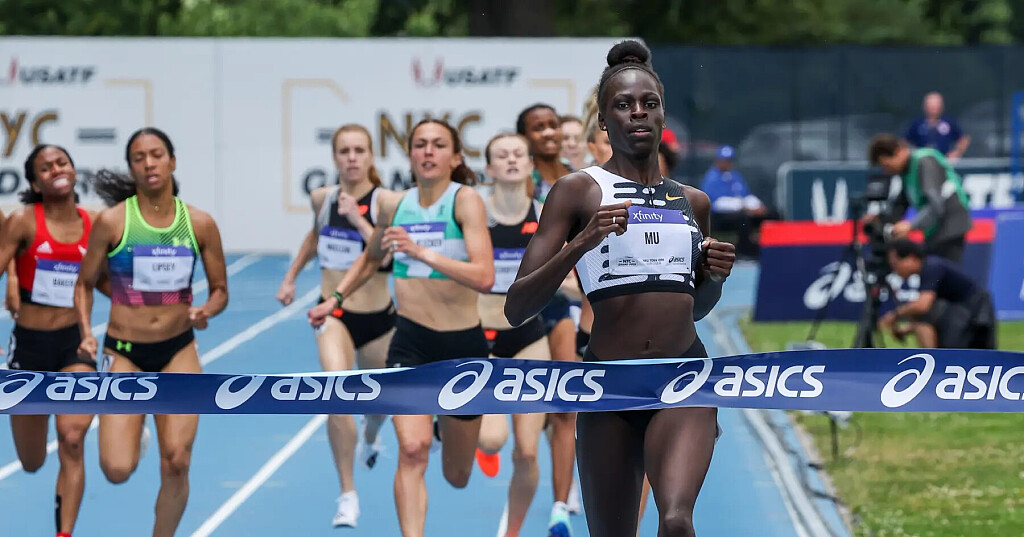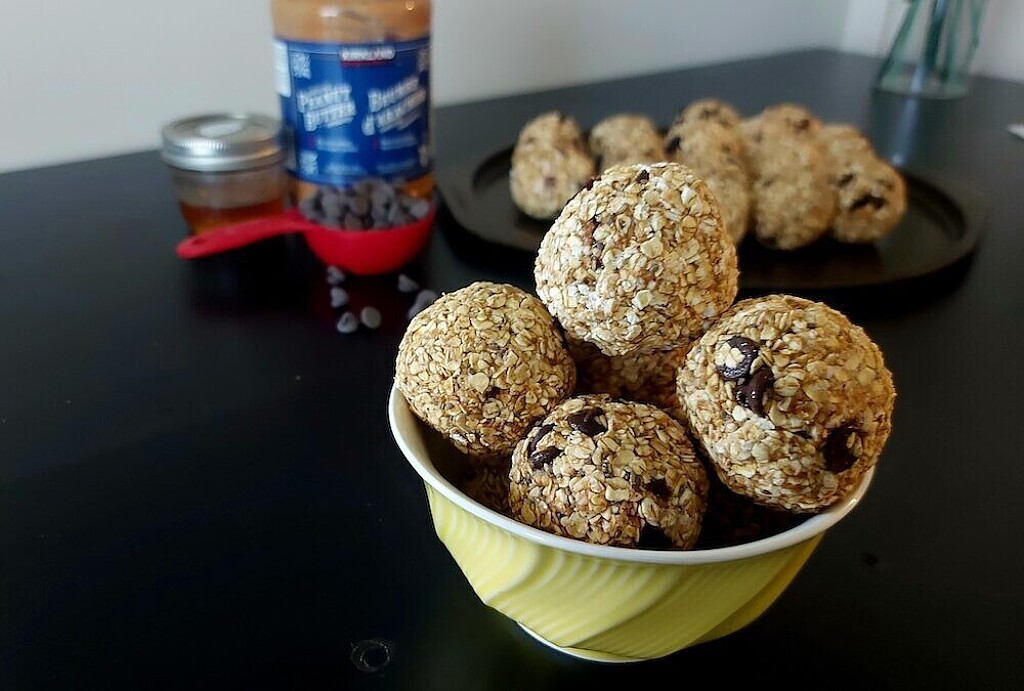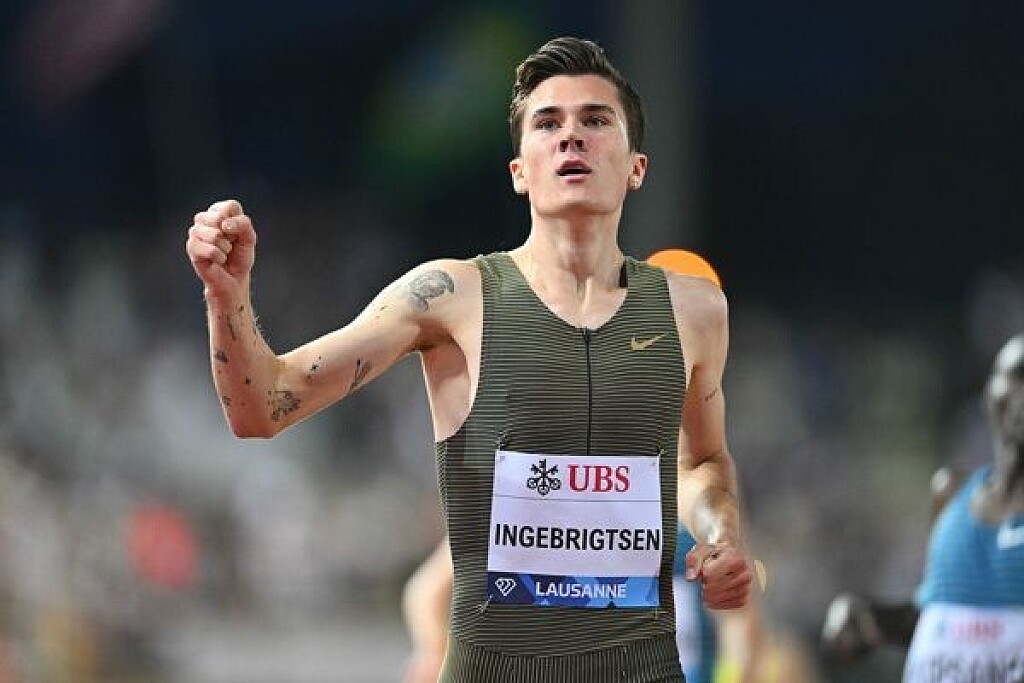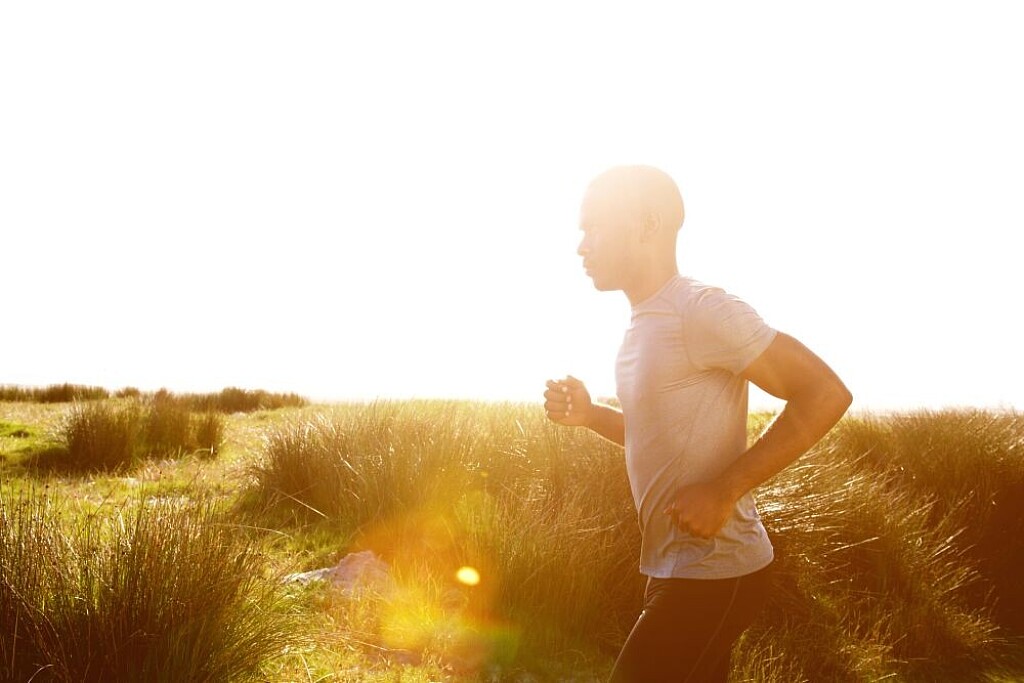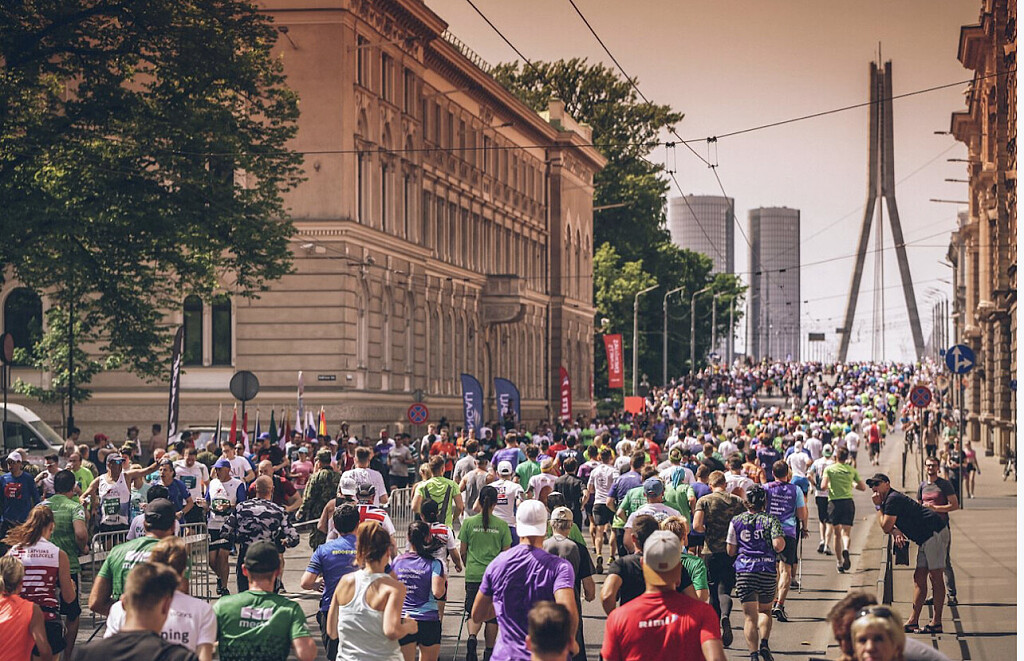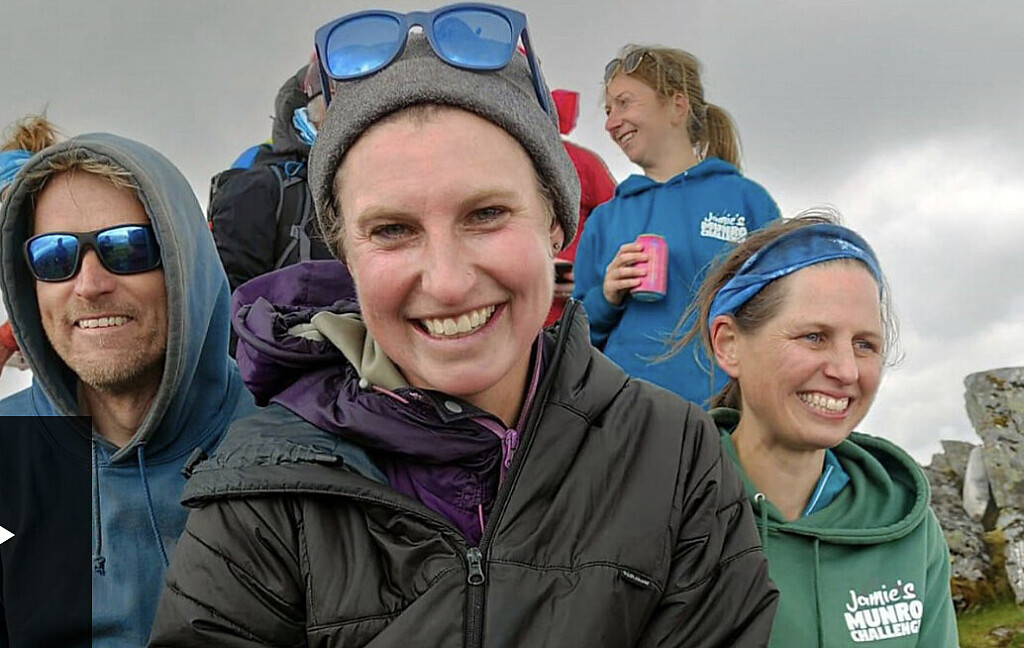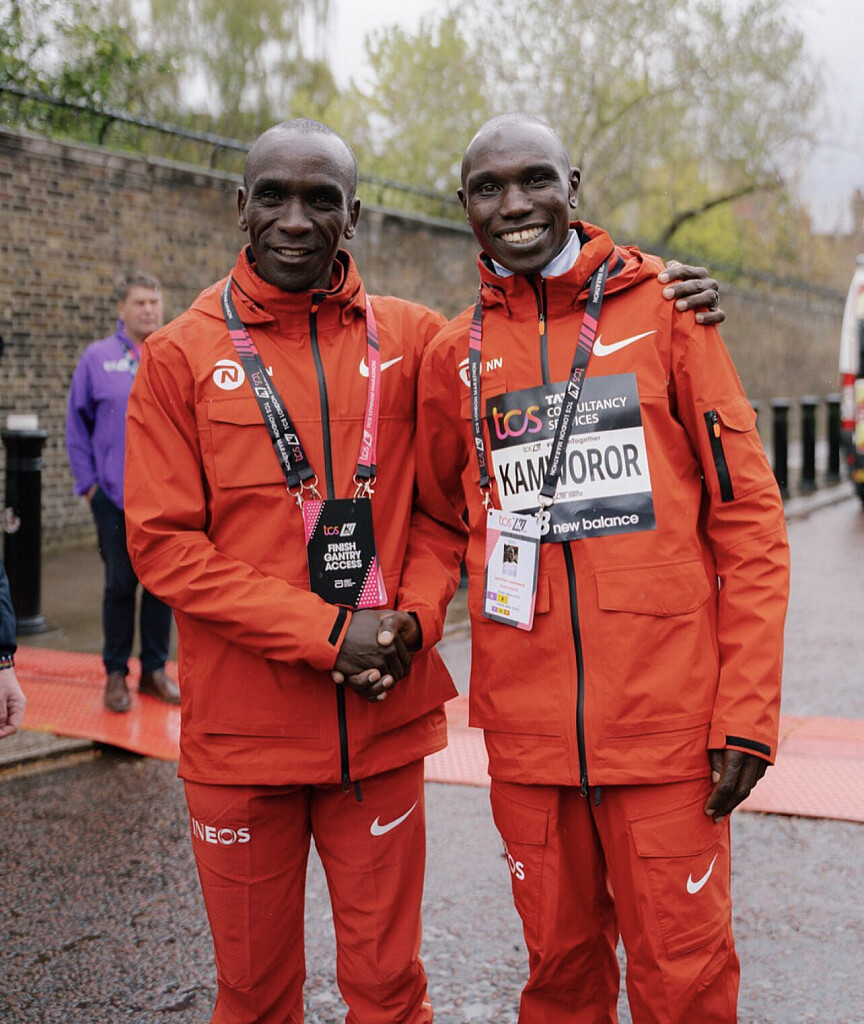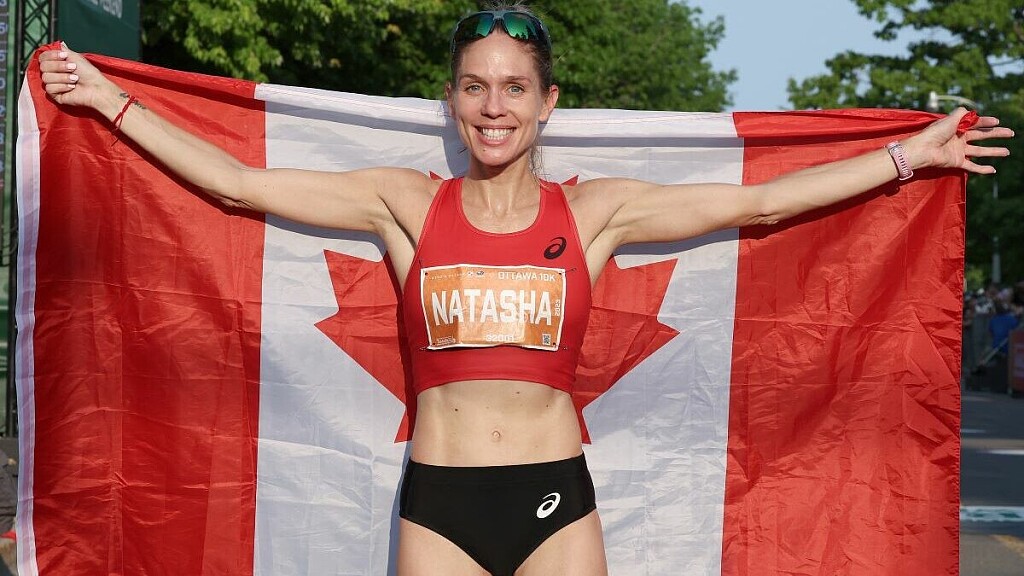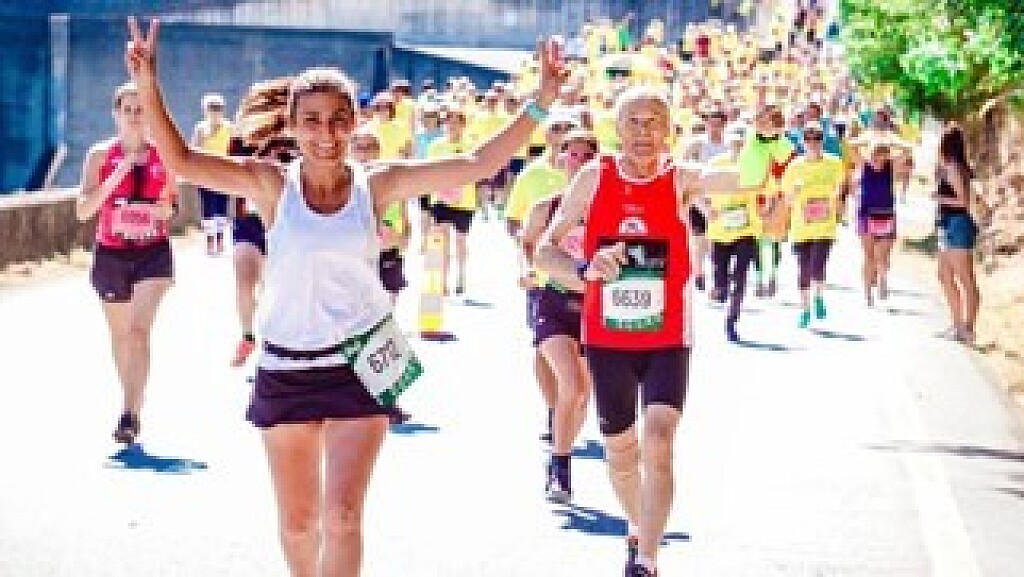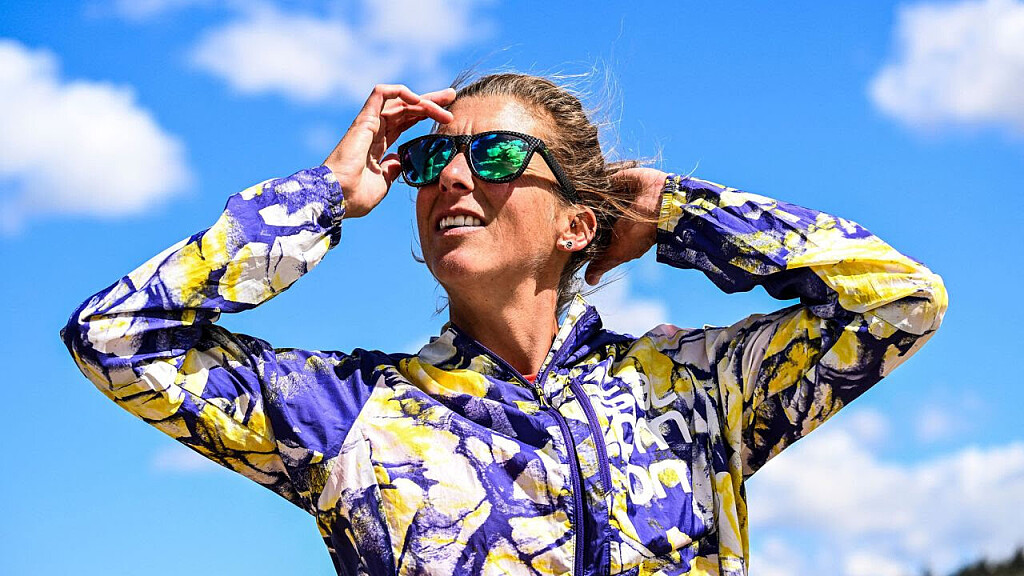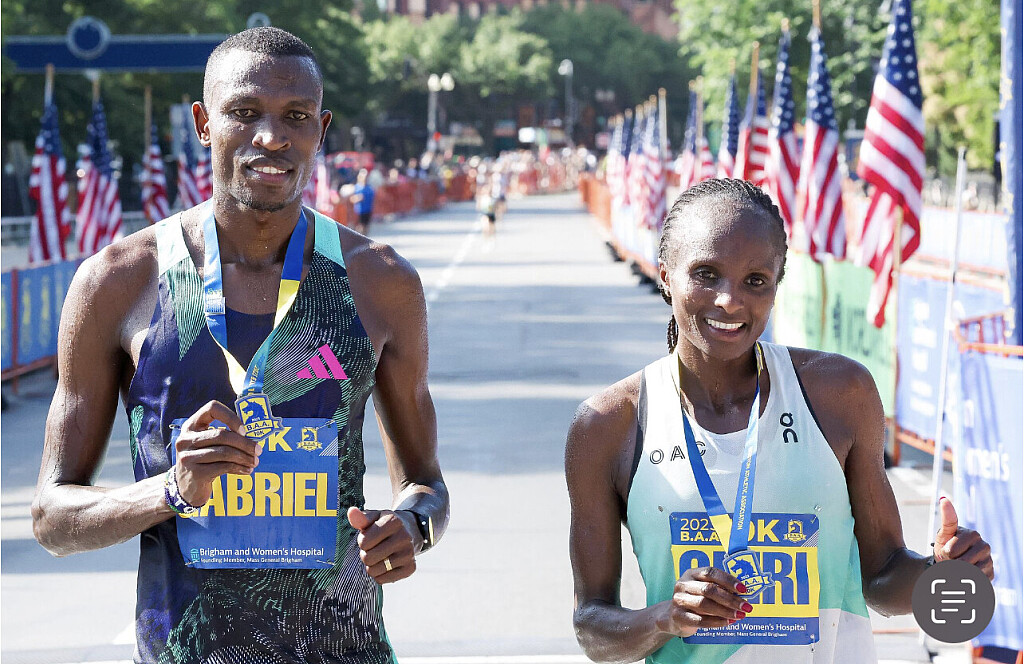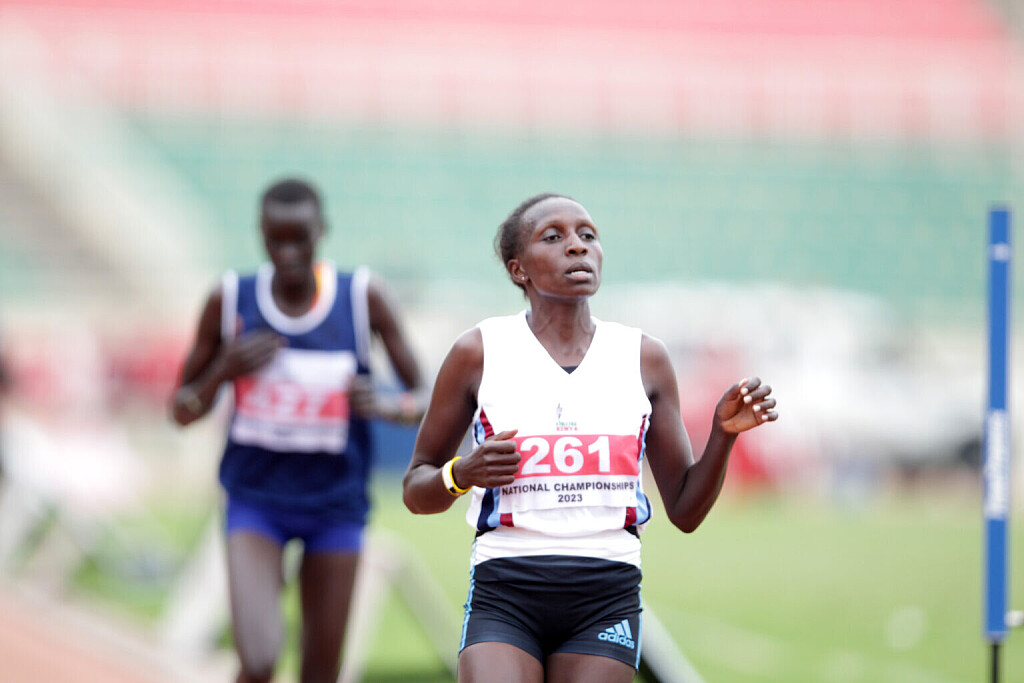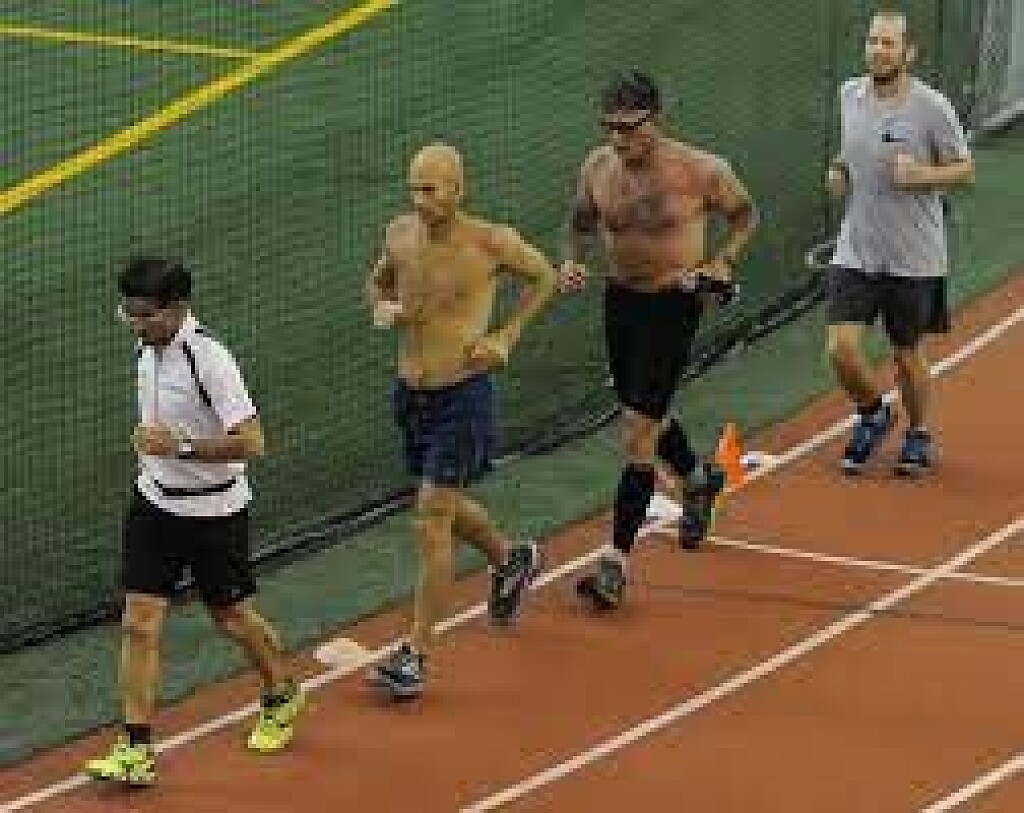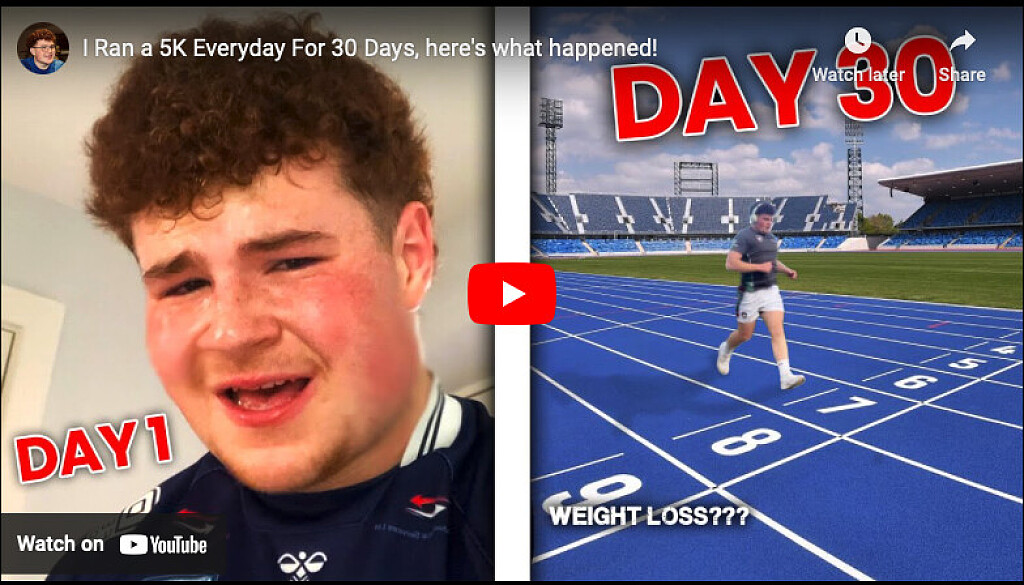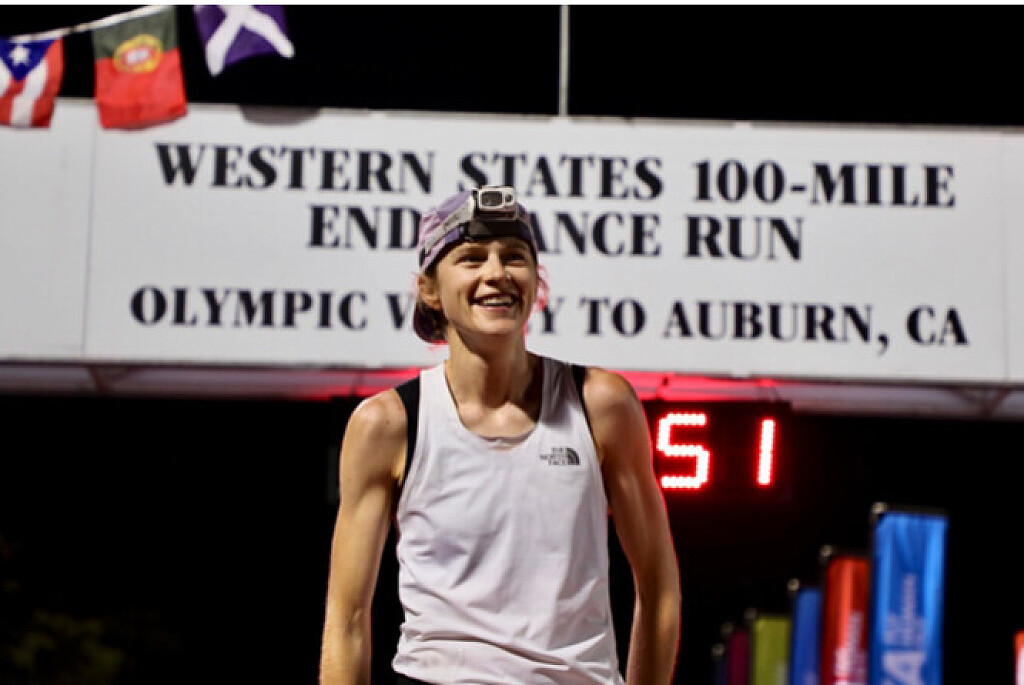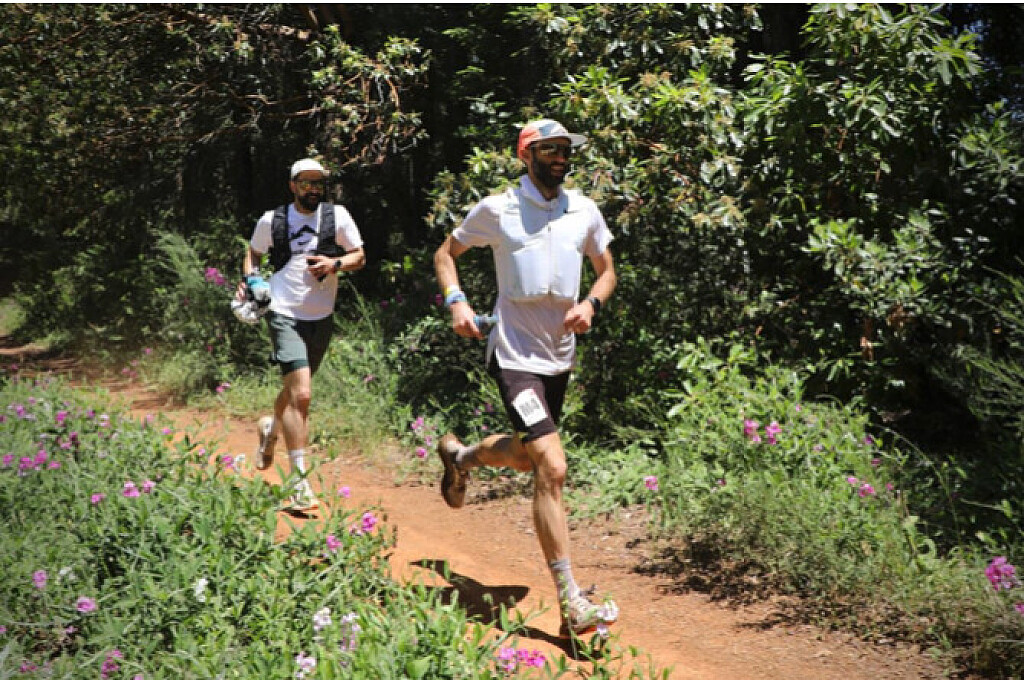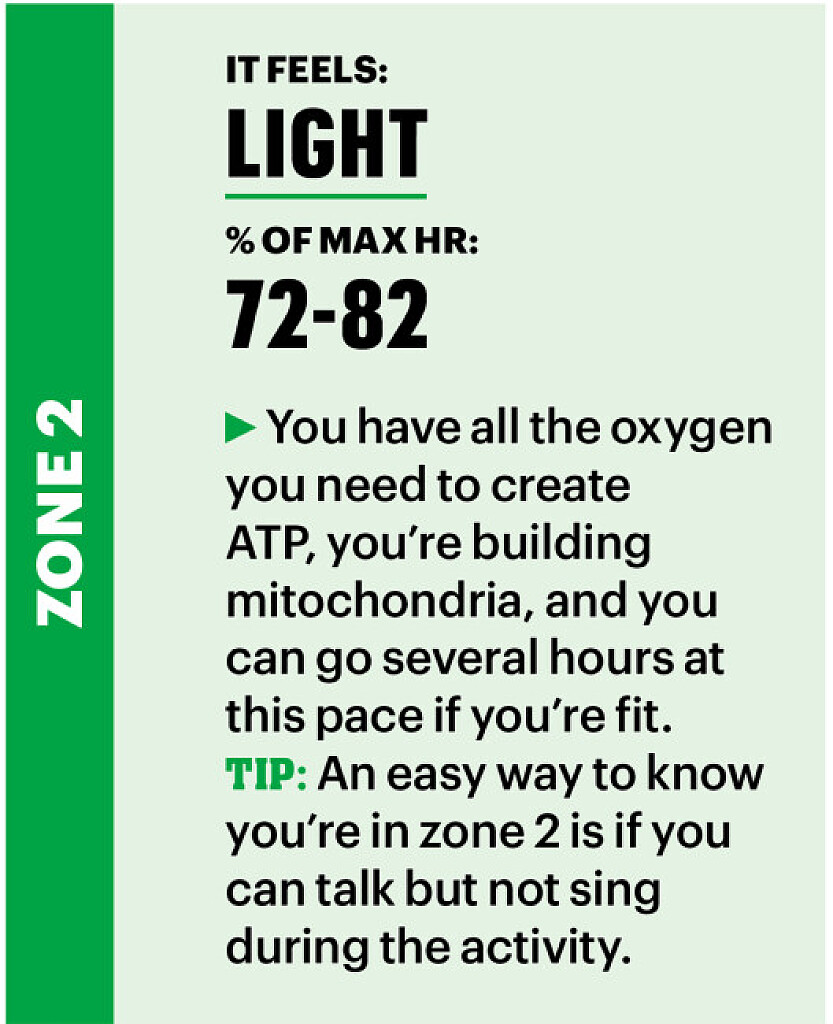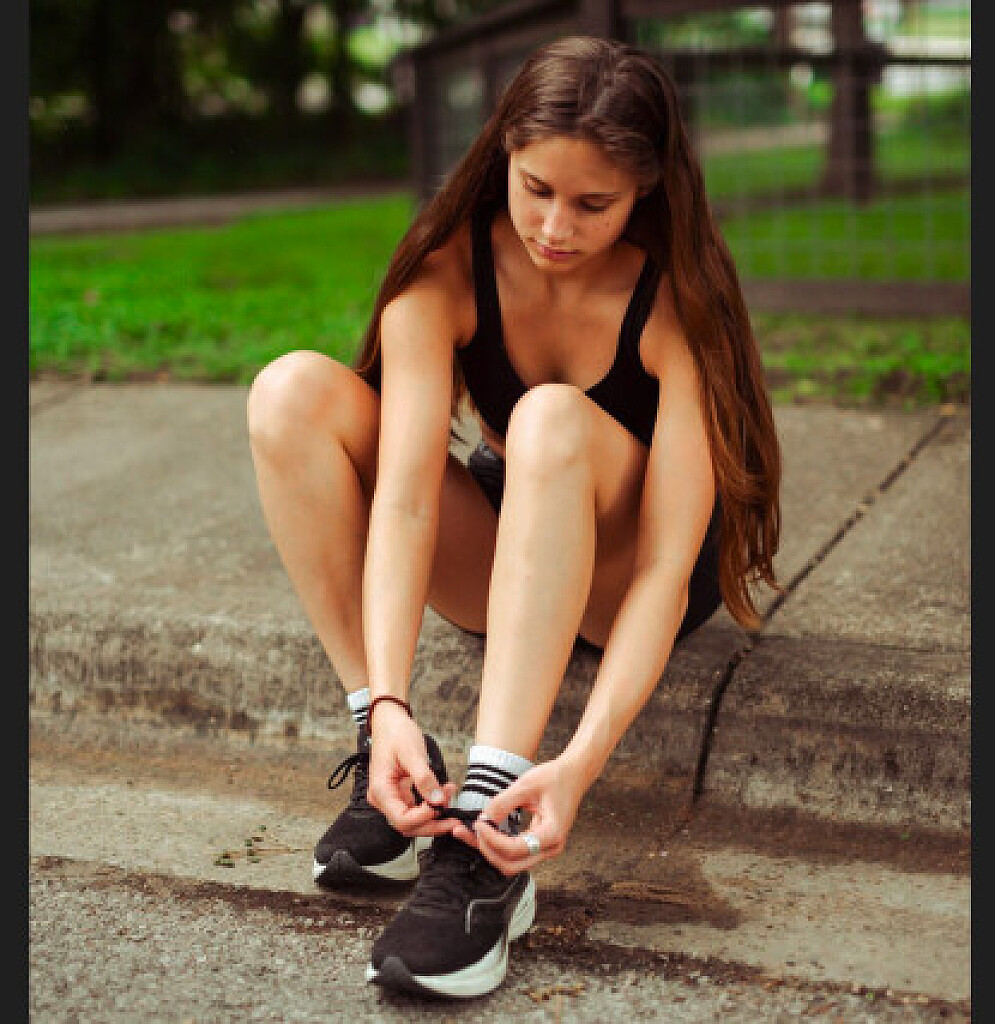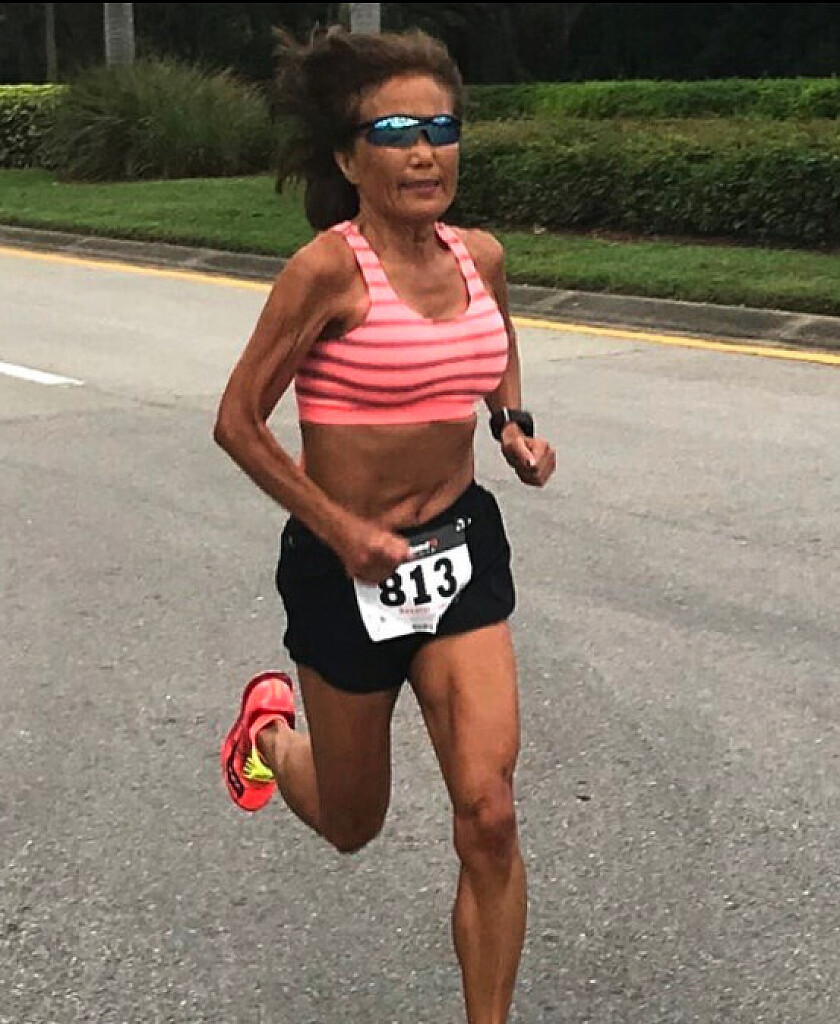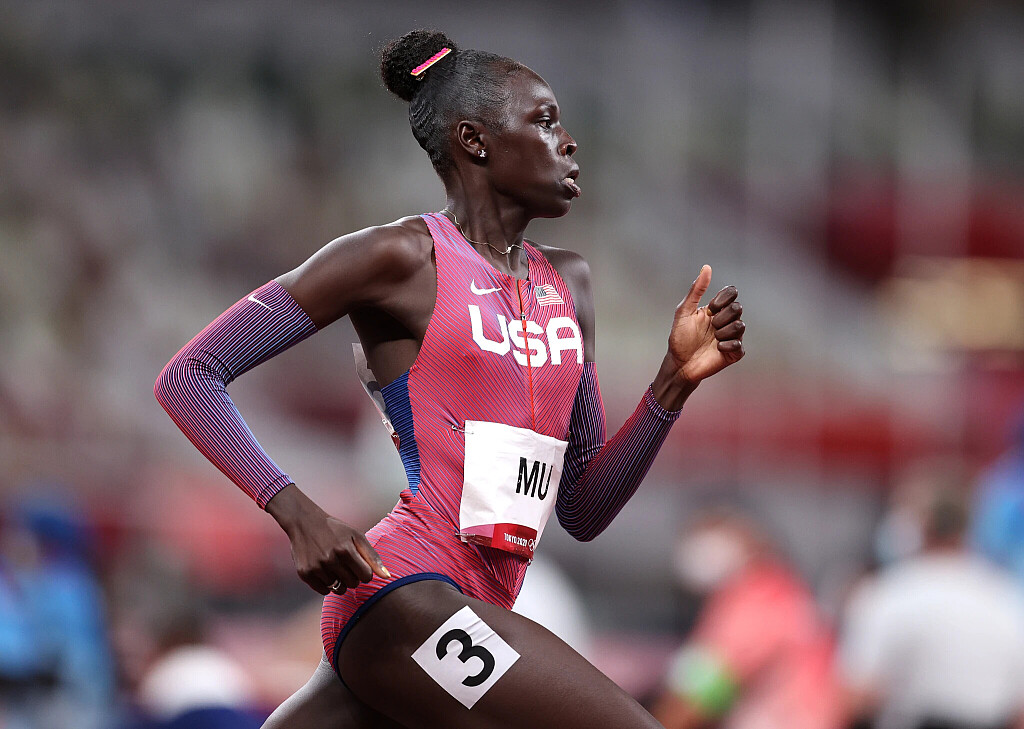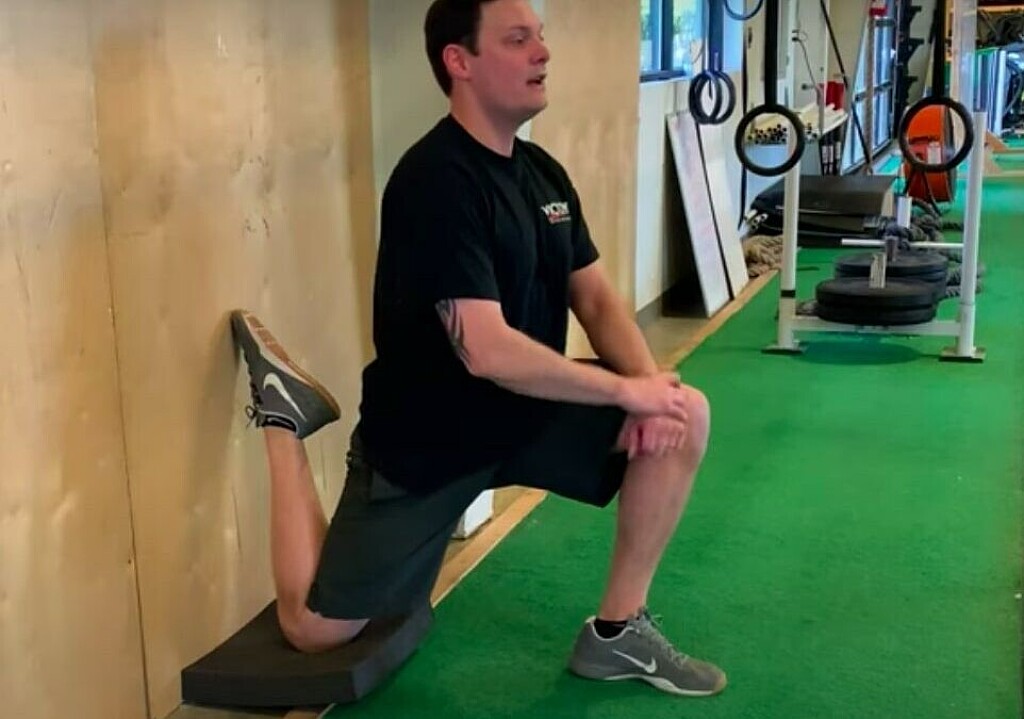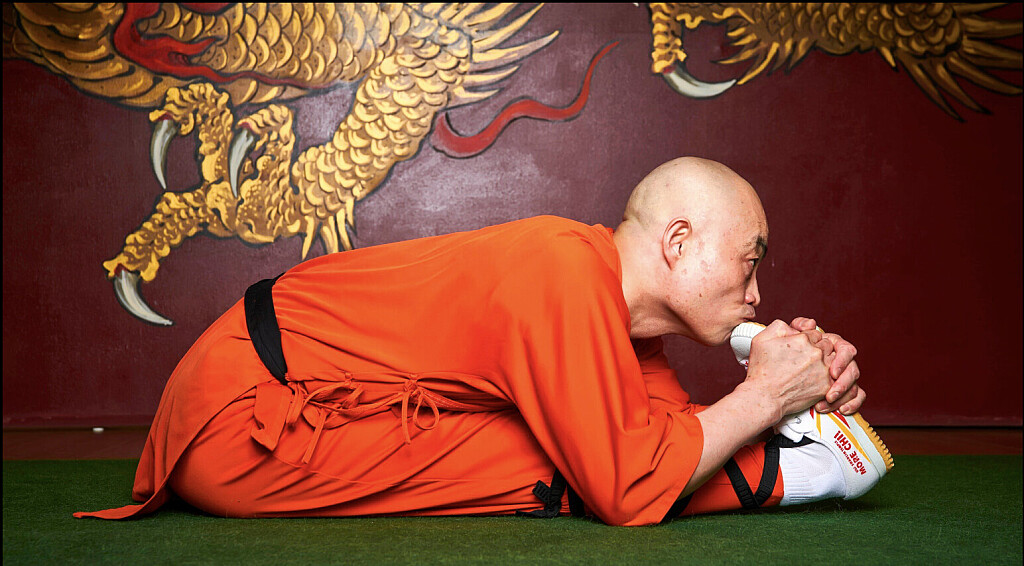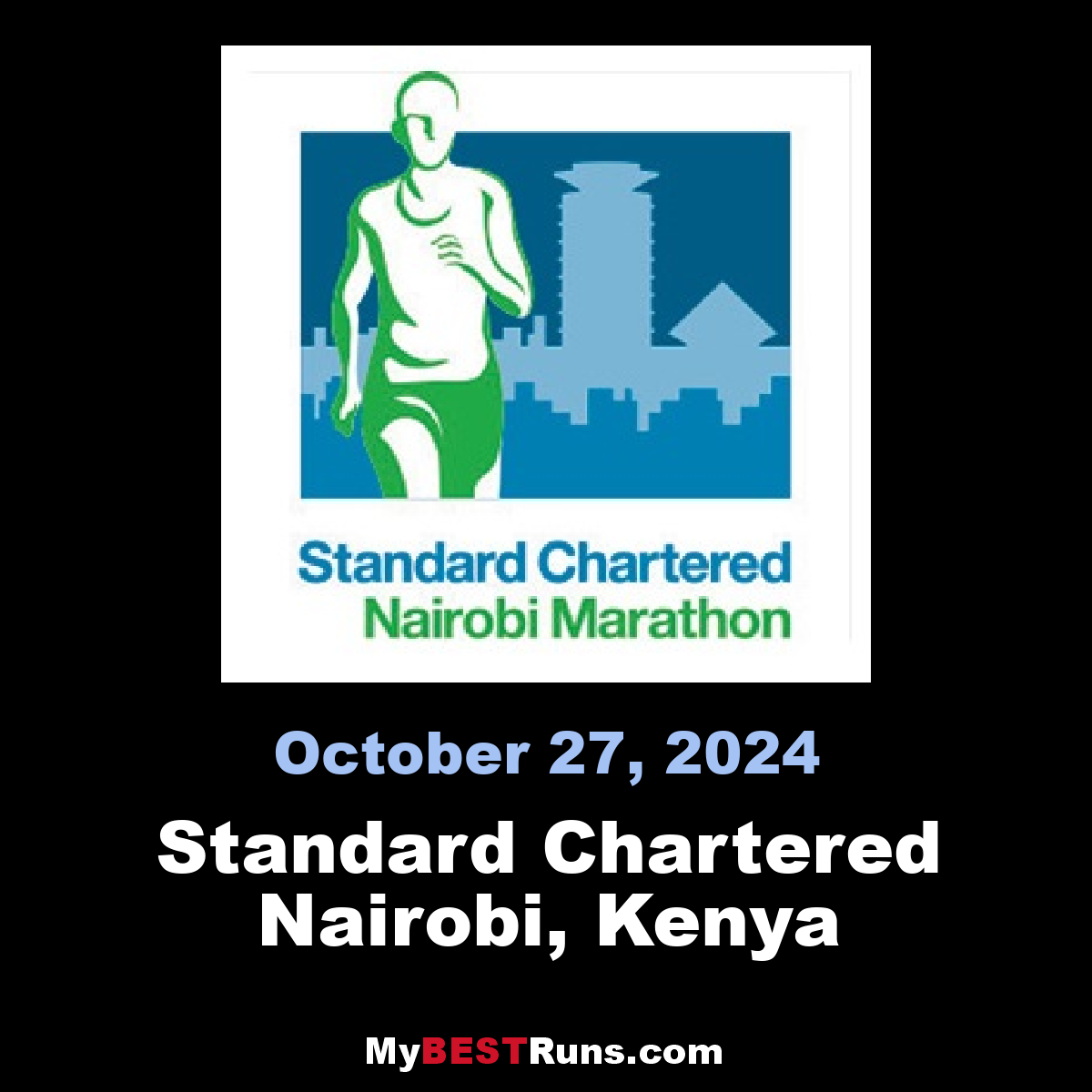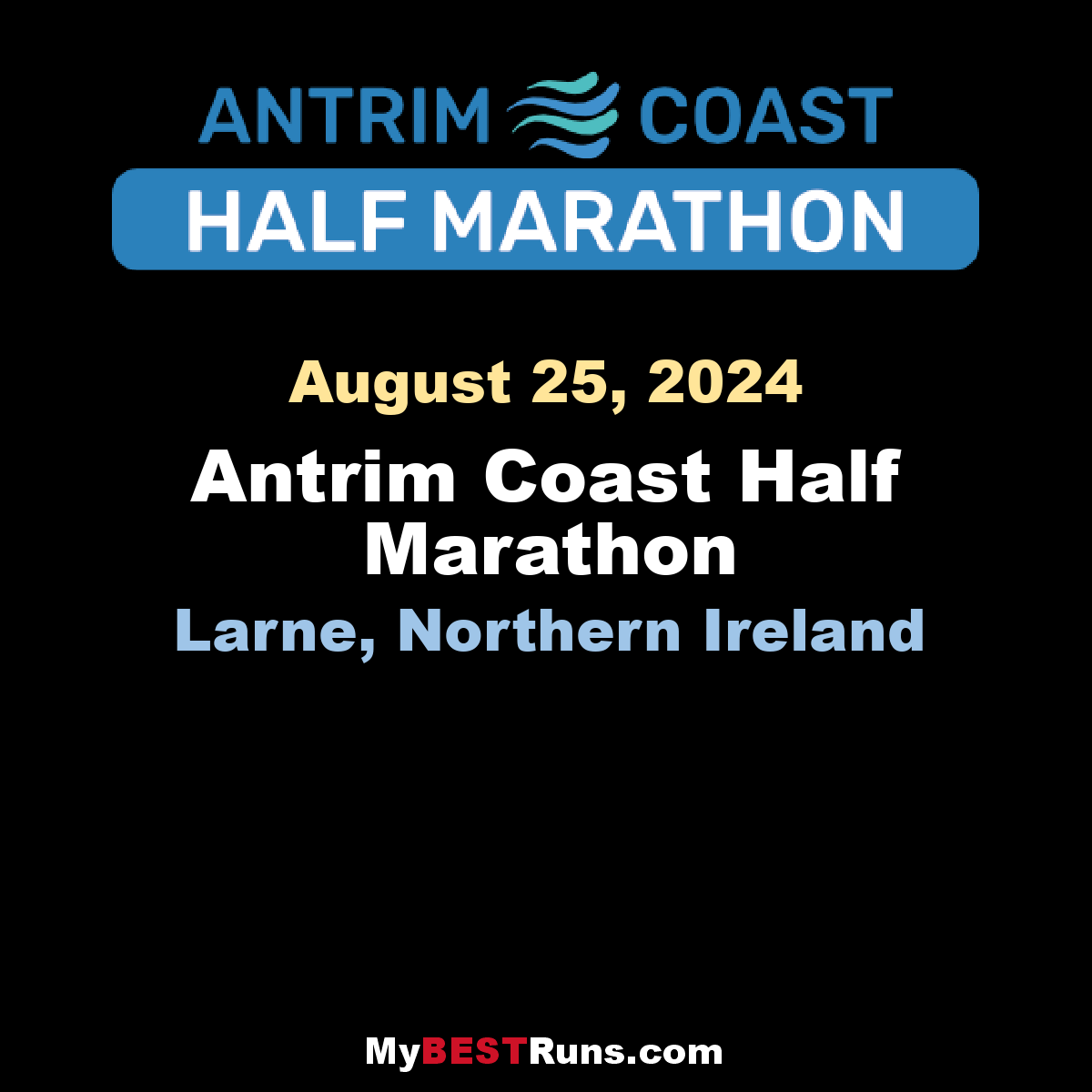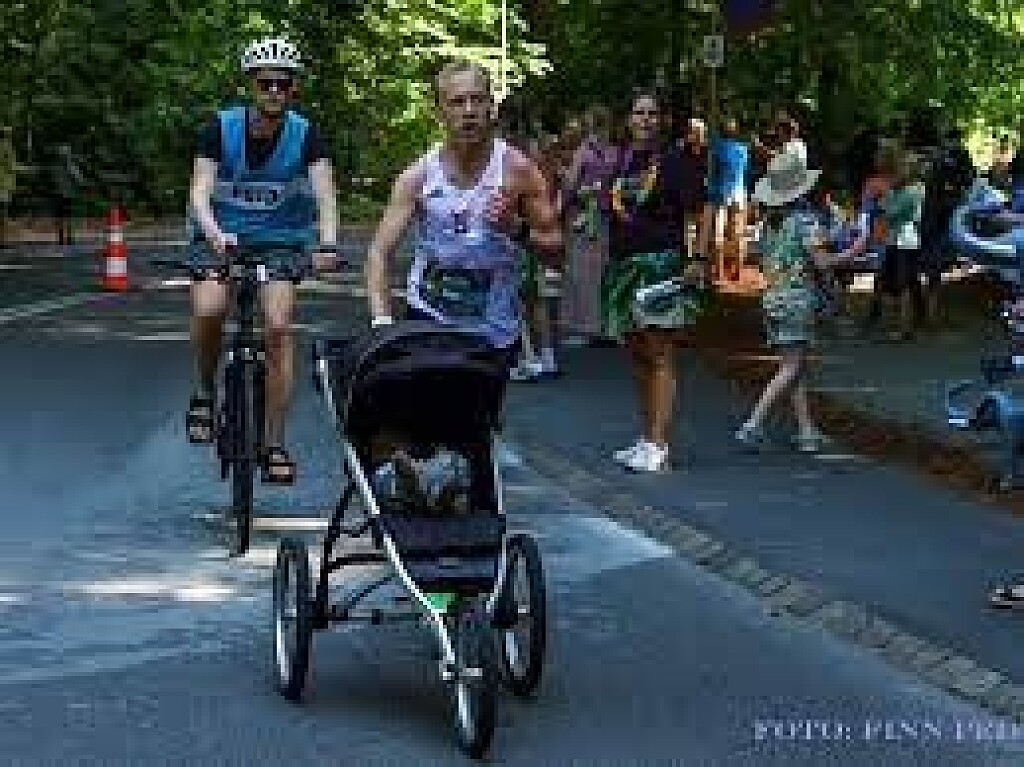Running News Daily
Running News Daily is edited by Bob Anderson in Mountain View, California USA and team in Thika Kenya, La Piedad Mexico, Bend Oregon, Chandler Arizona and Monforte da Beira Portugal. Send your news items to bob@mybestruns.com Advertising opportunities available. Over one million readers and growing. Train the Kenyan Way at KATA Running Retreat Kenya. (Kenyan Athletics Training Academy) in Thika Kenya. Opening in june 2024 KATA Running retreat Portugal. Learn more about Bob Anderson, MBR publisher and KATA director/owner, take a look at A Long Run the movie covering Bob's 50 race challenge.
Index to Daily Posts · Sign Up For Updates · Run The World Feed
On the track or the road, this workout will help you build strength and speed
If you’ve got an interval session coming up in your training plan, consider trying this descending ladder workout. Starting with 600m repeats to build strength and working your way down to 200s to work on your speed, it’ll help put you on track to achieve your next personal best in a variety of short and mid-distance races.
The workout itself is quite simple–the number of reps in each set increases as the intervals get longer, and you get a slightly longer rest between sets to reset before moving on to the next distance. As the intervals get shorter, the goal is to increase your speed, so aim to run the 600s at your current 5K race pace, the 400s at your 5K goal pace or a bit faster, and the 200s as fast as you can go (800m to 1,500m pace).
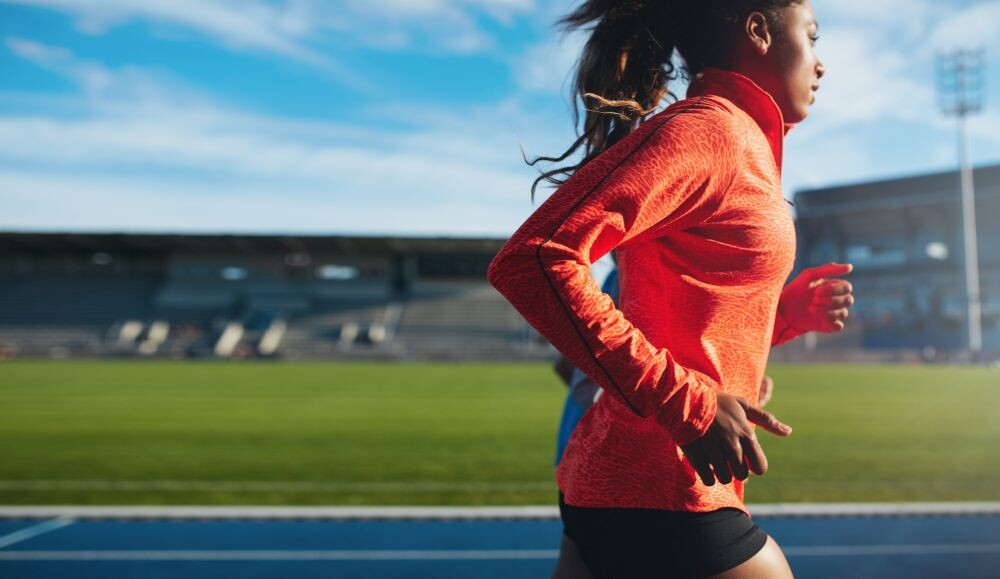
Don’t have a track nearby? Don’t worry–we’ve included a road option as well. Just make sure when you’re on the road that you’re paying attention to pace and cranking up the speed as the intervals get shorter.
The workout
Warmup: 15-20 minute easy jog, followed by form drills and strides
Workout: 600m/1 min rest/600m/2 min rest//400m/1min rest/400 m/1 min rest/400m/2 min rest//200m/1 min rest/200m/1 min rest/200m/1 min rest/ 200m
Road workout: 3 min/1 min rest/3 min/2 min rest//2 min/1 min rest/2 min/1 min rest/2 min/2 min rest//45 sec/1 min rest/45 sec/1 min rest/45 sec/1 min rest/45 sec
Cooldown: 10-15 minute easy jog followed by light stretching and mobility
(06/30/2023) ⚡AMPby BRITTANY HAMBLETON (Running Magazine)
2023 US Outdoor Track and Field Championships preview from Chris Chavez
Last night was the deadline for athletes to declare their event for the 2023 U.S. Outdoor Track and Field Championships, which will take place in Eugene from July 6-9. At USAs, athletes are allowed to enter multiple events and then make a decision about which event(s) they wish to contest once entries are in, which allows those who’ve achieved multiple qualifiers to be strategic about where they want to concentrate their efforts. The top three in each event who meet the qualifying standards for the World Athletics Championships will go on to represent the United States in Budapest in August.
Reigning World champions have a “bye” to the next year’s Worlds, which means the country they represent gets to send four athletes, not three. Similarly, reigning Diamond League and World Athletics Continental Tour champs earn a bye, but if there is both a World and other champion in the same event, their country still only gets to send one extra athlete.

These complex rules lead many American World champions to make interesting choices about what events they wish to contest at USAs and how hard they want to push while still in the middle of the championship season.
MEN’S SPRINTS
– 100m world champion Fred Kerley has the bye to the world championships and will only run the 200m. Last year, he qualified for the World Championships in the 200m with a third place finish behind Noah Lyles and Erriyon Knighton. He injured his quad in the semifinal of the 200m and was unable to run the 4x100m relay for Team USA. Kerley has a season’s best of 19.92 from his win at the Doha Diamond League.
– 200m world champion Noah Lyles has the bye to the world championships and will only run the 100m. He ran a season's best of 9.95 in his outdoor opener in April. The last time he ran the 100m at a U.S. Championship, he finished seventh at the 2021 U.S. Olympic Trials final.
– 400m world champion Michael Norman is declared for the 100m and 200m at the U.S. Championships. He ran a wind-aided 10.02 (+3.0m/s wind) at the Mt. SAC Relays in April. He has not raced since a last place finish in the 200m at the Doha Diamond League in 20.65 on May 5.
WOMEN’S SPRINTS
– Sha’Carri Richardson is running the 100m and 200m. She is looking to qualify for her first World championship team. Her season’s best of 10.76 from her victory at the Doha Diamond League is the second-fastest performance in the world this year. Her season’s best of 22.07 from the Kip Keino Classic at altitude in Nairobi is No. 4 on the world list.

Only Gabby Thomas’ 22.05 from the Paris Diamond League is faster this year by an American woman. Richardson, the 2019 NCAA champion, attempted the double at USAs in both 2019 and 2022, where her highest finish was 8th in the 100m in 2019. She has yet to make a U.S. final in the 200m.
– Reigning U.S. champion Abby Steiner is only running the 200m despite qualifying in both the 100m and the 400m as well. She just ran her season’s best of 22.19 to win the NYC Grand Prix.
– As previously announced, 400m hurdles Olympic champion, World champion and world record holder Sydney McLaughlin-Levrone is running the flat 400m. She plans to make a decision after the U.S. Championships whether she will run the flat 400m (if she qualifies) or defend her 400m hurdles title in Budapest.
– NCAA record holder Britton Wilson, who ran 49.14 to become No. 4 on the U.S. all-time list, will only run the 400m and not the 400m hurdles. She hurdled at last year’s World championships and participated in the 4x400m relay.
MEN’S DISTANCE
– This year’s men’s steeplechase team should have a new look. 2016 Olympic silver medalist Evan Jager is not entered in the steeplechase. He has raced just once this outdoor season. Hillary Bor, the reigning U.S. champion who also owns the fastest steeplechase time by an American this year in 8:11.28, broke his foot earlier this spring and will miss the U.S. Championships. This is the first U.S. team he has missed since 2015. The top returner is Benard Keter, who made the Olympic team in 2021 and the World team in 2022, but he is only the fifth-fastest entrant by seed time.
– For the first time, 2021 U.S. 5000m champPaul Chelimo is entered in both the 5000m and the 10,000m. Chelimo, the 3x global medalist at 5000m, has typically only focused on the shorter event, but after his 27:12.73 performance at the Night of the 10,000m PBs in the U.K. earlier this season, he has decided to contest both events. He’s seeded No. 4 by qualifying time in both events behind Grant Fisher, Woody Kincaid, and Joe Klecker (all also double-entered).
WOMEN’S DISTANCE
– 800m Olympic and world champion Athing Mu entered the 1500m, as previously announced with coach Bobby Kersee. She has the bye to the world championships in the 800m. Her personal best of 4:16.06 is well outside the automatic standard of 4:05.00 and was achieved outside the qualifying window for the championships, but USATF rules allow for significant discretion in accepting entries from the Sports Committee chair.
– Josette Norris and On Athletics Club coach Dathan Ritzenhein have decided to focus solely on the 5000m. Norris ran 14:43.36 at Sound Running’s Track Fest in early May. That’s the second-fastest time by an American woman on the year behind her teammate and training partner Alicia Monson’s 14:34.88 at the Paris Diamond League. Monson is entered in both the 5000m and 10,000m after choosing to only contest the 10,000m last year.
– NC State’s NCAA record holder Katelyn Tuohy will only run the 5000m. Tuohy qualified for NCAAs in both the 1500m and the 5000m but ended up only running the 1500m after an uncharacteristically disappointing performance in the final.
– The Bowerman Track Club’s Elise Cranny has declared for the 1500m, 5000m and the 10,000m. The first round of the women’s 1500m is 19 minutes before the final of the 10,000m on Day 1 of the competition, so Cranny will likely scratch one or more events at a later point.
(06/30/2023) ⚡AMP
by Chris Chavez (Citius magazine)
USATF Outdoor Championships
With an eye toward continuing the historic athletic success of 2022, USATF is pleased to announce competitive opportunities for its athletes to secure qualifying marks and prize money, including a new Grand Prix series, as they prepare for the 2023 World Athletics Championships in Budapest, Hungary.As announced a few months ago, the 2023 Indoor Championships in Nanjing, China have been...
more...When you consistently stress the body and the mind, you are changing your chemical makeup. Here’s what the latest science tells us about burnout
Kieran Abbotts is a PhD student at the University of Oregon, studying human physiology. He earned his master’s degree in Metabolism and Exercise Physiology at Colorado State University. The lab where he now works studies exercise and environment and stressors on physiology. In other words, he’s an expert on how the chemicals in the body work during exercise, and what happens when things get out of whack.
“Essentially, there are two kinds of training. There’s functional overreaching, which means you stress the body with hard workouts and long runs. Then you provide adequate time to recover, and you induce adaptations,” Abbotts said. This kind of training is ideal—your body is getting stronger. “You want to be functionally overreaching as an elite athlete—so that you’re making progress and becoming a better runner, but also giving yourself adequate recovery.”
And then there’s non-functional overreaching, which can feel the same to many athletes, but it’s very different. “With non-functional overreaching you’re essentially doing the same thing—big workouts, stressing the body—but not giving yourself enough time to recover. And so you start doing damage.” That damage might take a long time to show itself, Abbots said, but it eventually will.
This might be the most important thing to know about being an athlete at any level. Non-functional overreaching is exactly the same as very healthy training, except without enough rest. And rest is different for everyone, which makes it exceptionally easy to slip from functional overreaching into damaging non-functional overreaching without realizing it. Without adequate rest, the body begins to break down instead of build stronger.
Stress Is Stress

Professional ultrarunner Cat Bradley, 31, living in Hawaii, has experienced fatigue and burnout in various forms, including just after she won Western States in 2017.
Winning a big race is great, but it also means all eyes are on you—the pressure is high to stay on top. “After winning Western States, I took a month off, but I was still running at a high level. And for lack of a better term, I felt like I had a gun to my back,” Bradley said. “I wanted Western States so badly, and after I won, so many things happened and I never shook that gun-to-the-back feeling. After a while, it led to burnout. I had to take a mental break.”
For many athletes, finding success can be the stress that makes non-functional overreaching feel necessary. How can you take an extended break when you’re winning and signing new sponsor contracts?
A second version of burnout for Bradley came when she went through an especially stressful situation outside of running. She was dealing with such extreme daily emotional stress in her personal life that everything else was affected, including running and training. When the body is enduring stress, it doesn’t know (or care) what the cause is. We can’t put our life into silos. If there’s stress in one’s life, everything else needs to be adjusted. It doesn’t matter if that stress is “just work” or illness, or relationships.
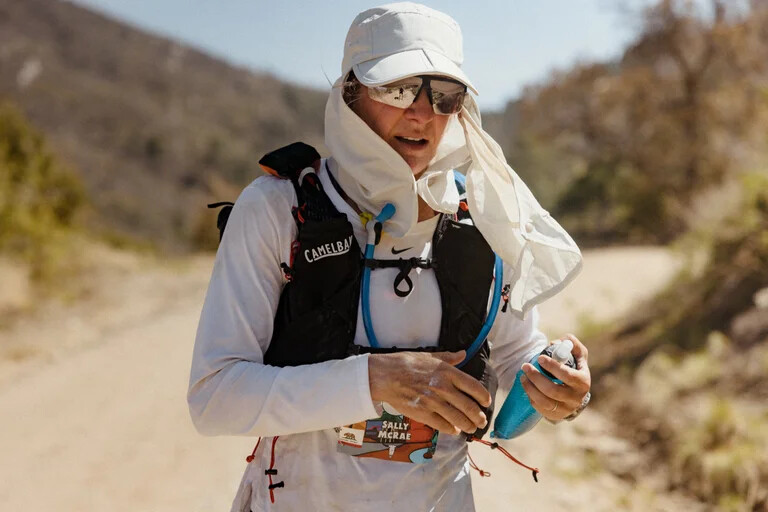
When you’re overtraining or chronically overstressed, your body is creating higher levels of “catecholamines,” hormones released by your adrenal glands during times of stress like epinephrine, norepinephrine, or adrenaline. “Having those chronically high levels of overstimulation and not enough recovery, you wind up with a desensitization,” Abbotts said. “Overstimulation also causes decreased levels of plasma cortisol. Cortisol is the stress hormone, and it plays a very important role in your physiology.”
When you’re exercising or stressing the body, cortisol will go up, to help the body deal with the stress. But if you’re constantly requiring lots of cortisol, your body will eventually down-regulate. It will adapt and then you’ll have low levels of cortisol. This means trouble dealing with physical and mental stress.
In February, Bradley experienced her most recent version of burnout, and it happened mid-race. Bradley was running the Tarawera 100-miler in New Zealand. Besides training for such a big race, she was also working full-time and planning and preparing for her wedding, which was just days after the race. On top of everything, travel to the event was incredibly stressful.
“I was in fourth place, I could see third, and at mile 85, I passed out and hit my head on a rock,” Bradley said. “We can talk about the reasons that I fainted, but I really think my brain just shut down—it was too much.”
For Bradley, reaching burnout has a lot more to do with outside stressors than the actual running. But now she’s aware of that—she continues to work on not reaching the “gun-to-the-back” feeling. The need to please others. The fear of losing fitness in order to take care of her body. It’s an ongoing process, but an important one.
Overdoing Is the American Way
Professional ultrarunner Sally McRae said, based on her observations, Americans are really bad at taking time off. “I’ve traveled the world and Americans are really bad at resting,” she said. “It’s part of our work system. You go anywhere in Europe and everyone takes a month-long holiday. You have a kid and you take a year off. We’re not conditioned like that in America. It’s like you get one week and then after you work a decade, you get two weeks of vacation.”
For McRae, avoiding burnout and overtraining has a lot to do with creating a life that’s sustainable. She started working when she was 15-years-old, so she realized earlier than most that life couldn’t just be working as hard as possible to count down to retirement.
“Perspective is massive when it comes to burnout. My goal every year is to find the wonder and the beauty and the joy in what I do. Because it’s my job, but it’s also my life,” McRae said. “And I really believe we’re supposed to rest—it should be a normal part of our life. Whether that’s taking a vacation or taking an off-season. I take a two-month offseason and I have for a long time.”
One of the most important parts about rest and not overstressing the body is that everyone is different. An overstressed body can lead to hormonal imbalances, which in turn affects everything.
“When you’re overtraining, you tend to get mood changes and have trouble sleeping,” Abbotts said. “Two of the big things that stand out are, you’re exhausted but you can’t sleep. And the other is irritability—mood swings, and depression.” When you get to the point that you’ve overstressed your body for so long that the chemicals are changing, pretty much everything starts falling apart.
And even though everyone is different, you’d never know that from looking at social media. “I know social media makes it seem like ultrarunners are running 40 miles a day, doing a 100-mile race every other weekend,” McRae said. “And that’s insane. You’ve got to be in touch with yourself. It’s very different to wake up and feel sore or tired, but if you wake up and feel like you have no joy in the thing you’re doing, you need a real break from it.”
How Can the Running Community Do Better?
Elite ultrarunner and running coach Sandi Nypaver wants runners to get more in touch with how they’re feeling and less concerned about numbers or what anyone else is doing.
“I have to have honest talks with people I’m coaching. I need them to feel like they can tell me how they feel, because sometimes they think they have to stick to the training plan for the week no matter what,” she said. “But the plan is never set in stone. It’s meant to be adjusted based on how you’re feeling. Some weeks we might feel great and not need to change anything, while other weeks we might have to totally crash the plan and do something else.”
It’s easy to judge ourselves against everyone else, especially when results and reactions are so public and available.
“It’s easy to say, ‘if that person only took three days off after a big race, and now they’re already back to training, that must be what you’re supposed to do,’” she said. “But even at the highest level, training is different for everyone. Resting is different for everyone.”
“Something that’s really, really hard for many runners to understand is that once you’re not sore anymore, that you’re still not recovered,” Nypaver said. “A lot of research says that things are still going on in your body for up to four weeks after, for certain races, depending on the distance.”
Sometimes it’s difficult to be aware of subtle signs when the soreness is gone. “Convincing people that they need to chill out for a while, even past the soreness, can be really difficult.” But after a huge effort, and before the next, people rarely end up saying things like, “I really wish I hadn’t rested so thoroughly.” Part of it is actually having a recovery plan. Putting rest days on the calendar, focusing on foam rolling and mobility on days that you’re not “doing.”
“And, actually just relaxing. Taking it easy. It’s not just a running model, we live in a culture where we’re always being asked to do more,” Nypaver said. “I wish instead of always thinking about doing more, we’d focus on how we want to be more. A lot of us want to be more relaxed and less stressed and happier and enjoy our lives. We need to put our attention on that instead of trying to do so much. It’s something I struggle with all the time.”
We don’t get validation for resting, relaxing, and being present because there’s no tangible thing to show for it. There’s no “be really calm often” challenge on Strava. But the bigger rewards are great. You just have to trade in immediate dopamine hits for a much more balanced, happier life.
Simple, right?
“One thing I’m doing, and asking my athletes to do, is to write down your intentions,” Nypaver said. “One of my intentions is to chill out more this summer and enjoy it. I grew up thinking it’s all about running, and I have to go all-in on running. But having other outlets, other things that I like to do, is so important.”
When you’ve reached burnout—an extended period of non-functional overreaching, prolonged rest is the only way to let the body fix itself.
“Once you are overtrained, you need to stop training,” Abbotts said. “It’s just kind of the bottom line. Maybe some people can get away with greatly reducing their training load, but most of the time you need to stop. You need an extended amount of time off.”
There’s nothing glamorous about rest. There’s no prize money in relaxing. But it’s the absolute key ingredient in extended performance, and in a much healthier, happier life.
(06/29/2023) ⚡AMPby Outside Online
These five-ingredient, no-bake chocolate chip peanut butter bites will keep mid-run tummy grumbles at bay
No one wants a grumbly tummy halfway through their run, but timing your nutrition before your runs can be challenging when you’re trying to fit them around a busy schedule. These chocolate chip, peanut butter and oat balls require no baking and are the perfect snack to sneak in right before you head out the door. So whether you’re an early morning pavement pounder, a lunchtime hero or an after-work warrior, they’ll help keep you fuelled until your next meal.
If the idea of making your own snacks sounds like a hassle, fear not: these tasty treats contain only five ingredients and don’t require any special equipment. All you need is a bowl, a spatula and your own two hands. (They’re also very easy to customize to individual tastes.)
The primary ingredients are:
Oats
Chocolate Chips

Banana
Peanut Butter
Honey
Not a banana fan? Leave it out and increase the amount of peanut butter and honey. Want a vegan option? Swap in maple syrup for the honey and carob chips for the chocolate chips. You can also try different nut butters and add all sorts of fun things into the mix, such as dried cranberries, chia seeds, flax seeds, chopped walnuts or anything else you’ve got in the cupboard. Be sure to check out the “optional add-ins” section for more great ideas.
These snacks take less than 30 minutes to make and can be kept in your freezer for up to a month. They’re a great alternative to store-bought snacks, but keep in mind that they don’t travel as well as packaged goodies, so they won’t make the best pack-and-carry fuel on a long trail run.
Check out the recipe below. Happy snacking!
Recipe
Ingredients
1 ripe banana, peeled *see note, below
⅔ cup smooth all-natural peanut butter *see note
⅔ cup honey (for a vegan alternative, use maple syrup)
4 + 1 cups instant or small-flake oats *see note
½ cup semi-sweet or dark chocolate chips (for a vegan alternative to milk chocolate chips, use carbo chips)
A pinch of salt
Method
In a large bowl, mash the banana until there are very few chunks left. Add the peanut butter and honey and whisk until smooth.
Add 4 cups of oats (reserving the last cup for later), chocolate chips and salt.
Mix thoroughly with a spatula, making sure to scrape along the bottom so there are no dry sections.
If the mixture is very wet, add the final cup of oats, ¼ cup at a time, stirring thoroughly after each addition. The mixture should be sticky enough that it holds together when you pinch it between your fingers, but not so sticky that it leaves a lot of residue on your hands.
Line a baking tray or large plate with wax paper. Wet your hands slightly with cool water and take about 2 tablespoons of the mixture into your hands. Roll it into a ball between your palms, gently squeezing it to ensure it sticks together. Each ball should be about the size of a golf ball.
Place each ball onto your baking sheet and freeze for at least an hour. Once they’re frozen, transfer them to a sealed plastic bag or container to stay fresh.
Optional add-ins *see note
Dried fruits (cranberries, raisins, etc.)
Nuts (peanuts, walnuts, pecans, etc.)
Cinnamon
Chia seeds
Ground flax seeds
Flaked coconut
Notes
Banana: If you choose to leave out the banana, increase the liquid ingredients by about ⅓ cup (more honey, more peanut butter, or a mix of both)
Peanut butter: Feel free to use regular (not all-natural) peanut butter, but the consistency may be different and you may have to adjust your dry ingredient ratios.
Oats: These work best with instant oats, because large-flake oats don’t stick together as well. If you only have large-flake oats, pulse them in a blender or food processor a few times first.
(06/29/2023) ⚡AMPby BRITTANY HAMBLETON (Running Magazine)
Ingebrigtsen and Girma go head-to-head in hunt for fast 1500m in Lausanne
Jakob Ingebrigtsen and Lamecha Girma both made history earlier this month in Paris, where they set a world two-mile best and a world 3000m steeplechase record, respectively. Now they have the chance to push each other to fast 1500m performances when they return to Wanda Diamond League action in Lausanne on Friday (30).
Norway’s Ingebrigtsen, who broke the world indoor 1500m record by running 3:30.60 in Lievin in February, clocked 7:54.10 in Paris to improve Daniel Komen’s world best for two miles. Despite still having that race in his legs, the 22-year-old improved his own European 1500m record to 3:27.95 in Oslo six days later – a time that places him sixth on the world all-time list.
Although the world record had not been his aim in Oslo, Lausanne’s Athletissima gives Ingebrigtsen another opportunity to take further strides toward Hicham El Guerrouj’s almost 25-year-old world record of 3:26.00.
“I 100% have more left in me,” Ingebrigtsen said after his performance in Oslo. “I just have to keep focused on each race ahead in the build-up to Budapest (World Championships), where it really matters.”
Girma will hope to be up there with him. The Ethiopian 22-year-old stormed to a time of 7:52.11 for his specialism in Paris, taking 1.52 seconds off the world 3000m steeplechase record set by Said Saeed Shaheen in 2004, and then turned his attention to attacking the Ethiopian 1500m record of 3:29.91 at the Continental Tour Gold meeting in Ostrava on Tuesday (27). He still looked like he had plenty left in the closing stages but having to run wide down the home straight, he focused on the win, running a PB of 3:33.15 that he will aim to improve again in Lausanne.
It will be the first time that Ingebrigtsen and Girma have clashed in any discipline.
In Oslo, Ingebrigtsen led the first eight men under 3:30 for the first time in history, and this time the line-up includes two other men who have dipped under that barrier so far in their careers: Britain’s Olympic bronze medallist Josh Kerr and Australia’s Stewart McSweyn. They are joined on the entry list by Ethiopia’s Teddese Lemi, New Zealand’s Sam Tanner and Britain’s Neil Gourley.
In the 5000m – the discipline in which Ingebrigtsen won world gold last year after his 1500m silver – Olympic champion Joshua Cheptegei will take on Olympic 10,000m gold medallist Selemon Barega, world 5km record-holder Berihu Aregawi, Telahun Haile Bekele, Birhanu Balew and their fellow sub-13:00 runner Muktar Edris.

In the women’s 3000m steeplechase, world U20 silver medallist Sembo Almayew is back on the track after her world-leading PB performance of 9:00.71 to win in Florence. The 2021 world U20 gold medallist, Jackline Chepkoech, was second on that occasion and is also racing, along with world record-holder Beatrice Chepkoech and world bronze medallist Mekides Abebe.
The world leader also heads the entries in the women’s 800m, where world and Olympic silver medallist Keely Hodgkinson – who improved her British record to 1:55.77 to win in Paris – will look to make another statement as she renews her rivalry with Kenya’s Mary Moraa.
World bronze medallist Moraa, who won Commonwealth Games and Diamond League titles ahead of Hodgkinson last year, has run a best of 1:58.72 so far this season and the strong field also features Habitam Alemu, Noelie Yarigo, Jemma Reekie, Catriona Bisset, Natoya Goule and Switzerland's Audrey Werro, who recently ran a world U20 1000m record of 2:34.89 in Nice.
(06/28/2023) ⚡AMPby World Athletics
Maybe your long run is too long
5 clear cues it's time to dial down the distance
Your weekly long run can be tricky for runners to get their heads around. It’s one of those slippery but essential elements of training—like “easy days” or “hard” efforts—that not only differs from one person to the next, but is also tough to pin down for ourselves. Depending on a runner’s goals, experience and abilities, the weekly long run might range from a few minutes to several hours, or might vary in length from hundreds of metres to tens of kilometres.
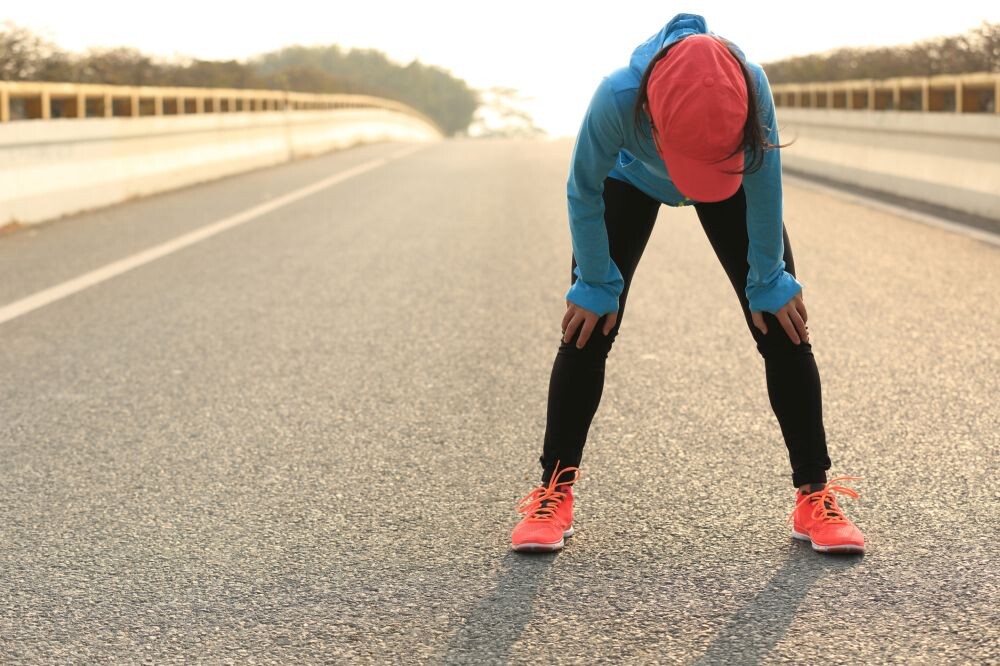
Despite the countless possible variations, long runs of all distances and durations may have something in common: clear signs that your longest run of the week is too long, and that it’s time to dial things back. If you’re wondering whether your concept of the long run could use some reworking, keep these clues in mind.
The numbers don’t add up
The total distance you run per week can offer sound guidance for limiting the length or time of your long run. According to famed U.S. running coach Jack Daniels, runners who are racking up fewer than 64 km over the week should limit their long run to 30 per cent of their total weekly distance. For those logging more than that in a week, the long run shouldn’t exceed 25 per cent of the week’s total distance—or 150 minutes, whichever comes first.

As the length and possibly the duration of your long run will increase in the course of training for an event like the marathon, increases need to be made wisely. Daniels recommends that runners not change their total weekly distance for four weeks before bumping up their weekly total, and by extension, the distance of their long runs. If the distance of your long run relative to your weekly mileage, or the frequency of increases to your long-run distance, shoots above these guidelines, it’s a sign you should trim your long runs accordingly.
Recurring injuries
Even if you’re sticking to those guidelines, your body can be sending you strong signals that you need to cut things back further. The most urgent warnings come in the form of recurring injuries. Pay attention to injuries or niggles that consistently resurface after your long runs. They might indicate that the distance is placing excessive stress on your body. Heed these warning signs and consider trimming the length of your long run to prevent further injury.
A plummeting pace
If you find your pace significantly drops toward the end of your long run, and you struggle to keep a consistent speed, it could indicate the distance is too long for your current fitness level. Try cutting off the distance of your long run at the point your pace starts to plummet, and if that new distance is sustainable, cap your long runs there for the next four weeks before returning to your original distance.
Declining motivation
A prolonged lack of enthusiasm and persistently diminished motivation may be a clue that you’re consistently pushing yourself too hard during long runs. It’s crucial to strike a balance between challenging yourself and maintaining a positive mindset to make progress in your training. (Declining motivation could, of course, be due to any number of other factors, including that you are running your long runs too fast.)
Low heart rate variability (HRV)
More running watches and fitness trackers are adding heart rate variability (HRV) measurement to their long list of metrics. Low HRV—the natural variation in tempo from one heartbeat to the next—might be an indication that your long runs are too demanding for your current level of fitness. Shorten your long runs for at least the next two weeks and make note of your HRV. If you start scoring higher,
(06/28/2023) ⚡AMPby Running Magazine
World Road Running Championships in Riga Latvia September 30
Athletics fans will have the opportunity to see the world’s best milers, 5km runners and half-marathoners compete in a single day at the World Athletics Road Running Championships Riga 23 under the revamped schedule announced today.
World Athletics and the Riga Local Organising Committee (LOC) have agreed to introduce a more compact programme, which will see the elite races and mass races held on the same day, October 1, at the championships.

The inaugural World Athletics Road Running Championships was originally envisioned as a two-day event, with the new road mile and 5km road championships to be held on Saturday 30 September and the half marathon races on Sunday 1 October, but in a move to create a more exciting build up for fans, all events have been brought together with the mass races on one day.

World Athletics President Sebastian Coe said: “As preparations for the World Road Running Championships have evolved, it has become apparent that the event will work better as a single-day event in Riga, both for local organisers and for broadcast. It will also give recreational runners the opportunity to be fully immersed in the day, running before and after our elite runners, and will create the festival atmosphere that we want to see to celebrate road running at every level.”
The new timetable begins on the morning of 1 October with the mass races over 5km and the road mile to be followed by the elite races over the same distances. Then attention will turn to the half marathon distance with the elite races to be followed by the mass race.
This unique global running festival will not only crown the world road mile, 5km and half marathon champions, but is also expected to feature thousands of amateur runners, kids and families from up to 100 countries participating alongside elite runners.
Aigars Nords, Head of the Local Organising Committee, commented: “With three months to go to the inaugural World Athletics Road Running Championships in Riga, Latvia, we have already attracted recreational runners from more than 50 countries all over the world. Saturday 30 September will see thousands of kids and families warm up for the championships during Kids’ Day, while Sunday 1 October will provide a unique opportunity for everyone to earn their mass race medals, not only in the road mile, 5km, and half marathon, but also in the half marathon relay, a new mass race, aimed at recreational runners not yet ready for the challenges of a half marathon.”
Any recreational runner who is ready for a challenge can register for any of the official mass races of the World Championships in Riga and earn a unique medal from the World Athletics Road Running Championships.
WRRC Riga 23 updated schedule
Saturday 30 September 202310:00 – 15:00 Kids’ Day
Sunday 1 October 202310:00 Mass race | 5km11:30 Mass race | Road mile11:50 Women | 5km12:15 Men | 5km13:00 Women | Road mile13:10 Men | Road mile13:30 Women | Half marathon14:15 Men + mass race | Half marathon | Half marathon relay (10.5km + 10.5km)
(06/28/2023) ⚡AMPby World Athletics
A woman has set a new time record for scaling all the mountains in Scotland higher than 3,000 feet
Ultra-runner Jamie Aarons finished the challenge in 31 days 10 hours and 27 minutes, breaking the previous record by more than 12 hours.
There are 282 mountains that meet the benchmark and they are known collectively as the Munros.
The challenge saw Aarons ascend 459,000 ft, the equivalent of climbing Mount Everest 16 times.
She also ran, cycled and kayaked between each of the Munros, covering a total of around 932 miles (1,500km) on foot and about the same distance by bike.
(06/27/2023) ⚡AMPEliud Kipchoge says he is determined to keep on writing history — and secure a third Olympic marathon crown next year
Eliud Kipchoge is widely regarded as the greatest marathon runner of all time has set himself many challenges in his dazzling career, and remains insatiable despite his two Olympic titles, his world record of 2:01:09 in Berlin in 2022 and an incredible 15 wins in 18 marathons he has entered.
He broke the mythical two-hour barrier over the 26.2 mile (42.195 kilometre) distance in Vienna in 2019, with a time of 1:59:40, but the feat was not recognised as an official world record as it was not in open competition.

Victory has eluded the 38-year-old in the Boston and New York marathons, which if he won would make him the first man to have all six major titles under his belt.
"The priority now is to focus on the Olympics and win a third time. The other (challenges) will come later," Kipchoge says in an interview with AFP at the renowned Kaptagat training camp in Kenya's Rift Valley.
His two Olympic marathon gold medals in 2016 and 2021 put him at level pegging with Ethiopia's Abebe Bikila (1960, 1964) and Waldemar Cierpinski of East Germany (1976, 1980).
A third gold at the Paris Olympics in 2024 would make Kipchoge the undisputed marathon giant at the Games, and bring him a victory steeped in symbolism.
The French capital was the city where he won his first international crown in 2003 at the age of 18, clinching the 5,000 metres world championship title ahead of sporting legends Hicham El Guerrouj of Morocco and Ethiopia's Kenenisa Bekele.

However, Kipchoge does not rule out giving up on his other goals.
"If time comes in to hang the racing shoes, I will say bye to other big things in sport."
'I know myself'
Sitting on a shaded bench in the Kaptagat camp where he has lived and trained for several months a year for 20 years, Kipchoge looks back on his poor showing in Boston on April 17, where he dropped from the lead group in the 30th kilometre and ended up finishing sixth.
This rare failure dampened his spirits.
"I'm trying to forget what has happened in Boston. It's caught in my mind... but I believe that what has passed has passed."
With his lifelong coach Patrick Sang, he has analysed the reasons for his disappointing performance, saying "it's mostly the hamstring".
He brushes aside concerns about his difficulties on hilly courses such as Boston and New York and which will also confront him in Paris.
"It is not really a concern, but I respect everybody's thoughts," he says. "I think it was a bad day and every day is a different day. I'm looking forward for next year.
"Everybody can write anything, you have no control. But I know myself."
'Want to be an inspiration'
Kipchoge is now preparing for his final marathon of the year.
"I'm doing well. My training is going on in a good way," he says.
But he has not yet disclosed which event it will be — Berlin on September 24, Chicago on October 8 or New York on November 5.
"At the end of July, I will know where to go."
He is following his usual training programme, eating up more than 200 kilometres a week on the red dirt tracks of Kaptagat forest, 2,400 metres above sea level.
Among his 20-odd training partners at the camp at the time of the AFP interview were Kenya's new 1,500m and 5,000m world record holder Faith Kipyegon and two-time New York marathon winner Geoffrey Kamworor.
As the respected dean of Kenyan athletics, Kipchoge is happy to see the emergence of 23-year-old compatriot Kelvin Kiptum, who won the London Marathon in April in 2:01:25, the second fastest time in history and just 16 seconds away from his own world record.
"I want to be an inspiration and I trust my breaking the world record twice is an inspiration to many young people. I trust they will want more and even beat my records."
'Prioritise drugs tests'
But in a country where athletics has become tainted by large-scale drug use, Kipchoge laments that "many people are going into shortcuts to advance".
"I think doping is there... It's all more about getting rich."
Kipchoge says the authorities should prioritise testing for performance-enhancing substances, saying it was much more important than education "because everybody who is doing doping knows what is going on".
"Just pump everything in testing, put testing as a first priority and all will be well," he says.
"The moment we prioritise testing and we register those who are handling the athletes across the country, we have the right data to know who is who in the whole country.
"But if we really ignore the people who are working with athletes and athletes themselves, then we are in danger."
(06/27/2023) ⚡AMPNatasha Wodak and Jeremy Coughler win Canadian 10,000m titles
Wodak secures her second national in three weeks, and Coughler wins his first Canadian 10,000m title at Pacific Distance Carnival in Langley, B.C.
Three weeks after successfully defending her Canadian 10K title in Ottawa, Natasha Wodak added another national title to her extensive resume at the Canadian 10,000m Championships in Langley, B.C. Wodak won by a significant margin of 30 seconds, securing her second Canadian title of the 2023 season. On the men’s side, London, Ont’s. Jeremy Coughleremerged as a first-time national champion, crossing the finish line in 28:46.96 on a warm and windy evening at the Pacific Distance Carnival.
Despite experiencing some minor hamstring tightness leading up to the 10,000m championships, Wodak displayed her exceptional fitness by establishing an impressive lead of nearly 100 meters after the 5K mark. Assisted by 2020 Olympian Natalia Allen for 12.5 laps, Wodak maintained her position and claimed victory overKatelyn Ayers and Cleo Boyd.
Ayers achieved a personal best time of 33:11.77, securing second place, while Boyd from Kingston, Ont., finished seven seconds behind Ayers in 33:18.27, taking the third spot. This marks the second time in the last four years that Wodak has achieved the remarkable feat of winning both the 10,000m and 10K titles. She previously accomplished this feat in 2019.
Wodak will now return to training as she continues her preparations for the marathon at the 2023 World Athletics Championships scheduled in Budapest in late August. Her last representation for Canada was at the 2020 Tokyo Olympics, where she placed 13th in the marathon.
Coughler captures Canadian crown
For Coughler, following his third-place finish at the Canadian 10K Championships last month, the desire for further success propelled him to secure his first individual Canadian national title. Representing the London Western Track Club and working as a full-time chiropractor, Coughler has been on a roll in 2023, winning multiple races and showcasing his talent. Perry MacKinnon from Sherbrooke, Que., impressed with a commendable time of 28:52.60, securing the second position.
Meanwhile, Mexican Olympian Juan Luis Barrios claimed third place with a time of 28:55.82. However, since Barrios is ineligible for Canadian championship recognition, the third-place medal was awarded to Andrew Alexander from Toronto, who finished fourth in 29:25.64.
(06/27/2023) ⚡AMPby Running Magazine
Unleashing Potential: Exploring Why the Gambling Industry Could Be a Beneficial Sponsor for Running Events
Running events have gained quite popularity in the last few years. They become a center of attraction for people who particularly have a passion for fitness. Such events, inarguably, require a large amount of funding for the organization and execution. The event organizers are often on the lookout for sponsorships to get proper funding.
There is one industry that offers great potential for sponsorship and is also quite in demand – the gambling industry. This article takes a deep dive into the reasons why the gambling industry could be a beneficial sponsor for running events.
1. Promotion of Responsible Gambling Practices
As unfortunate as it might be, the lack of awareness related to gambling has resulted in people disregarding its responsible practices. By partnering up with the gambling industry, running events can play a crucial role in raising awareness about responsible gambling and how it is done while staying within one’s means.

Several casinos, such as Zodiac Casino, are to be named prime examples of gambling done in the right way. The participants in running events will come to know about this through sponsorship. What’s more, Zodiac Casino sign-up is a pretty hassle-free procedure, which further provides the players with opportunities to practice online gambling in the most responsible manner. Ever since its launch in the early 2000s, it has continued to provide people with the opportunity to play for real money.
2. Financial Support
The gambling industry possesses all the financial means to offer substantial funds for running events. Said funds can be used to organize the events and execute them by renting out the venue, marketing the event on multiple platforms, and looking after the convenience and demands of participants.
Moreover, online casinos are popular in this regard since the funding coming from them is used to invest in enhancing the experience of runners.
As reported by BBC, Aston Villa's Fan Consultation Group stated, “The commercial reality is that for teams outside the top six, such sponsors offer clubs twice as much as non-gambling companies.”
3. The Subsequent Exposure
Online casinos have a massive online following and reach. By enlisting its help, running events can successfully manage to reach a broader audience. The use of promotional ads and posts on various social media platforms is said to be quite effective in leading to higher participant registrations.
As a matter of fact, various brands take advantage of the reach of online casinos to maximize their visibility on online forums. Active gamblers discover such brands on the websites and accounts of casinos and search for them later.
Conclusion
Promoting responsible gambling practices and awareness regarding casinos, along with financial funding and larger exposure to a broader audience, is one of the primary reasons why the gambling industry is considered a beneficial sponsor for running events. It can contribute to the success of such events and further provide a more dynamic event landscape.
(06/26/2023) ⚡AMPThese simple tricks will have you gliding effortlessly over hills and up mountains
Running uphill seems simple in theory, but many runners struggle with the challenge or avoid hills altogether. Striding up some vert can help all types of runners, in every distance, boost speed and strength. Learn how to maximize your hill training (without getting hurt) by running both up and down effectively and efficiently.
Practice the long, steady climb

With the exception of hill sprint workouts, you should aim to run uphill at a moderate, sustainable pace. Burning up energy by tackling hills full-tilt will cause a deficit later in your workout or race, while evenly-paced climbing will keep you running smoothly throughout. Studies show many runners tackle hills too quickly at the outset and end up running at greater effort than they can maintain.
Find a hill that takes you 10 minutes or longer to run up (or set your treadmill incline so that your legs are burning but you can smoothly keep pace). Aim to mimic the effort you use on flat terrain, even if it feels like you’re running very slowly. If you find yourself starting to breathe more heavily, slow down.
Lengthen your stride at the top

After speeding up a hill, you may have a habit of slowing down (or even stopping) to catch your breath before resuming your normal pace. Runners naturally have a shorter stride heading uphill, and it takes a conscious effort to switch back to your regular stride quickly.
Make a habit of cueing yourself to open your stride and pick up your pace. To get better at this, find a short hill that takes under a minute to reach the top of. Run hard to the top, lengthen your stride, and accelerate for roughly 15 seconds. Run easily back down the hill to recover and repeat five to 10 times.
Learn to love the downhill
Downhill running at high speeds is an art form. Inserting some fast downhill sections into your training will help you gain the confidence needed to have a loose, relaxed gait and fast pace, while avoiding zooming out of control.
After a regular run, add four to six 100-metre strides down a gentle hill that has a grade you feel comfortable playing with speed on. Try shortening your stride, while keeping your arms wide and low for stability. Aim for quick steps and a smooth gait. If you find you are breathing easily, push a little bit harder. As you get more comfortable picking up the pace, find steeper hills to practice on.
(06/26/2023) ⚡AMPby Running Magazine
Courtney Dauwalter breaks record at Western States 100 by almost 80 minutes
Ultramarathon runner Courtney Dauwalter crushed the women’s course record at the Western States 100-mile race in California, taking more than an hour off the previous best time.
Dauwalter finished the Western States 100 – the world’s oldest 100-mile race – in 15 hours, 29 minutes and 34 seconds, almost 80 minutes faster than Ellie Greenwood’s record set in 2012. The race was first run in 1974.
“I just kept asking [my legs] to do one more mile for me and they kept responding, so I was very thankful for that,” Dauwalter told iRunFar about the last 20 miles of the race.

“I was definitely, though, deep in the pain cave and really focused on every single step, every single second.”
Cooler weather contributed to faster times at this year’s Western States 100, which started in the early hours of Saturday morning in Olympic Valley, California.

Snow covered much of the initial stages of the course before runners descended into a recently unshaded section scorched by last year’s Mosquito Fire.
After running with fellow American Katie Schide, Dauwalter started pulling away around the 30-mile mark, steadily eating away at Greenwood’s course record.
Covering 18,000 feet of climbing and almost 23,000 feet of descent across Californian trails, the race finishes on a high school running track in the city of Auburn in Placer County.
“I couldn’t believe when the track suddenly showed up and you make that turn, I was like: We did it! We’re here!” Dauwalter told iRunFar.
“Because that was the moment where I let myself actually believe that we had finished and we were about to be able to stop moving.”
Dauwalter, who is set to defend her title at the Hardrock 100 in Colorado in three weeks’ time, also won the Western States 100 in 2018, though her time this year was nearly two hours faster.
Most people’s idea of fun wouldn’t involve running for hours on end through brutal, undulating terrain – but ultra-marathon sensation Courtney Dauwalter is no ordinary person.
While an ultra-marathon is technically defined as any race longer than 26.2 miles, Dauwalter’s exploits tend to take place at distances far greater than that, usually between 100 to 250 miles.
The 38-year-old’s list of achievements is almost interminable. Dauwalter, a four-time ‘Ultra Running Magazine Ultrarunner of the year,’ holds multiple course records for the obscenely long races around the US and abroad.
Dauwalter’s breakout moment came at the Moab 240 – an annual 240-mile race in Utah. At the 2017 edition, shortly after making the decision to become a full-time ultra-runner, Dauwalter completed the course a scarcely believable 10 hours ahead of all other competitors – male and female.
The Transgrancanaria event on February 24 – Dauwalter’s most recent escapade - resulted in her 15th straight race win by gender dating back to March 2021, according to results database Ultrasignup.
The Minnesota native completed the grueling 128km course (79.5 miles) – including over 7000 meters of elevation gain - around the Canary Island in a course record 14 hours 40 minutes: over 90 minutes ahead of her closest competitor.
(06/26/2023) ⚡AMPTOP Marathons Sponsored by Casinos
The running industry is booming and it's not just because of the health benefits. It also has a lot to do with how much fun it is to sign up for a marathon and get geared up for the big day.
The excitement and energy of an event like this, combined with the thrill of crossing that finish line, are enough to put anyone in a good mood—even if they're exhausted from all that training! But there's another reason why marathons have become so popular: casino sponsorships!
Benefits and Significance of Marathon Sponsorships for Casinos
Marathons are a great way for casinos to connect with the running community. While running is often seen as an individual sport, marathons can bring together thousands of people from all walks of life and make them feel like part of something bigger than themselves.
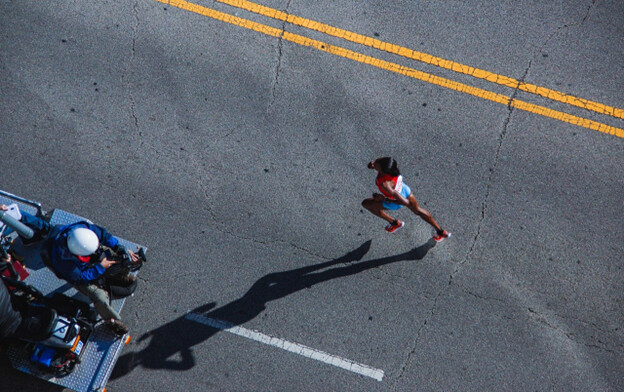
Casinos can also use marathons as an opportunity to build their brand awareness by sponsoring races or offering discounts on race registration fees for casino members. They don’t just rely on no deposit casino bonuses and other promotions as a marketing strategy. Sure, one of the top deals they can make are no deposit bonuses with Gamblizard's no deposit offers being a perfect example. Casinos who sponsor races often do so because they want their name associated with healthy lifestyles (since many people run as a form of exercise) but also because it gives them access to new customers who may be interested in visiting the casino after seeing how much they care about helping others achieve their goals through such programs.
Advantages of Casino Sponsorships in Marathons
Casinos can use marathons to promote their brand, promote a healthy lifestyle and connect with communities. Casinos are popular destinations for runners and other athletes looking for great gaming experience and low wagering bonuses. They often have race sponsorships in place to help them gain exposure among this demographic and attract more players, just like they do with low wagering casino bonuses at sites where gamblers don’t need to deposit much. But casino sponsorship goes beyond simply advertising on running gear or at the finish line.
A casino's involvement in a marathon or triathlon can go much deeper than just slapping its logo on some promotional materials and handing out free drinks at the finish line. Gambling brands may take part in planning events that support athletes' training, offer prizes for winners and host post-race parties where competitors gather after completing their race together as one big group.

Building Brand Visibility and Reputation
Casinos are building a reputation for sponsoring marathons. They're also building a reputation for being good corporate citizens, good neighbors and good employers.
The casino industry has had its share of negative press over the years. Casinos were originally seen as dens of iniquity where people went to gamble away their money and possibly engage in illegal activity. However, today's casinos have taken steps to improve their public image by sponsoring charitable events like marathons or races.
The casino industry is also seen as a good employer. In many states, casinos are required to provide jobs for people who live in economically depressed areas where unemployment rates are high. The casinos provide employment opportunities both on-site and off-site, and many of these jobs require little or no experience.
Casinos are also seen as good neighbors. They often donate money to local charities and sponsor community events.
Connecting With Communities and Promoting a Healthy Lifestyle
Casinos can make a real difference in their communities by sponsoring a marathon. They can be a part of the community and help to promote healthy living, which is something that is important for everyone.
Casinos want people to come out and have fun with them, but they also want people to feel good about themselves when they leave the casino. This means encouraging them to get out there and exercise (or join a marathon) or eat healthier food options at their restaurants or cafes.
The TCS New York City Marathon is one of the largest marathons in the world. It's also one of the oldest races in North America, having been run every year since 1970 (except 2012 and 2020 due to justified reasons). The 2019 edition featured 53,627 finishers and 98,247 applicants for entry into this international sporting event--making it the world's largest marathon by both measures. In addition to being a major athletic competition, it has also become an important cultural celebration that highlights New York City's diversity while also raising money for charity organizations such as Team For Kids Foundation and Autism Speaks!
The course starts at Fort Wadsworth in Staten Island before crossing over into Brooklyn via Verrazano-Narrows Bridge before going through Queens and then Manhattan before finishing up near Tavern of the Green with tens of thousands cheering them on their way! The marathon has many sponsors, and occasionally it is sponsored by a local casino. Moreover, they have ESPN as one of the official sponsors, who may not be a casino, but they do offer Fantasy Football Sweepstakes.
Las Vegas Rock 'n' Roll Marathon
The Las Vegas Rock 'n' Roll Marathon is one of the largest marathons in the world, attracting thousands of runners from around the globe each year. The 13th edition of the half marathon attracted more than 27,000 participants in February 2023.
Even if the races started in 1967, the annual marathon event takes place in February every year since 1993, except when it was cancelled because of the 2020 Coronavirus outbreak.
The Strip at Resorts World Las Vegas sponsored the Rock ‘n' Roll Running Series Las Vegas expo took, with an attendance exceeding 50k people over three days! Resorts World Las Vegas, the expo's presenting sponsor, organized the three-day Health & Fitness Expo on the Strip. A Health & Fitness Expo kicked off race weekend, where runners had a chance to pick up their bibs, explore interactive exhibits, shop for event merchandise, and enjoy non-stop music and live entertainment. With its opening on June 24, 2021, Resorts World Las Vegas is the Strip's newest property in over a decade. Moreover, one of the marathon editions also had MGM Resort was also one of the sponsors, and they are listed on the official marathon website.
Niagara Falls International Marathon
Niagara Falls International Marathon is one of the most popular Canadian marathons. The fun fact about it is that it starts in one country(Buffalo, NY) and ends in another (Niagara Falls, Ontario, Canada). The marathon was established as part of the casino's grand opening celebration and has been held every year since then.
The events include 5k races and 10k races as well as half marathons and full marathons. It is one of the largest and most popular marathons in Canada, with over 6,000 runners participating each year since 1974. From 1998 until 2008 when it was known as the Casino Niagara International Marathon, they had a sponsorship with Casino Niagara (as their title sponsor).
Impact of Marathon Sponsorships on the Running Industry
Marathons are an excellent way for casinos to increase their brand awareness, as well as help promote a healthy lifestyle in their community. By sponsoring these events, casinos can make running more accessible to more people. This is good news for everyone--casinos get to see their name on the race bibs and banners, while runners get some extra motivation from knowing they're part of something bigger than themselves.
Influence of Casino Sponsorships on the Running Community
The influence of casino sponsorships on the running community can be seen in many ways. Casinos can help by offering financial support for races that would otherwise not be possible, as well as providing enhanced race experiences and promoting healthy lifestyles. These benefits are important because they provide runners with an avenue for their passion and allow them to enjoy their hobby even more. They also build brand visibility, reputation and loyalty for casinos who choose to invest in these types of projects.
Financial Support and Enhanced Race Experiences
Casinos can provide financial support to races. This can come in the form of direct sponsorship or through event partnerships that include promotional opportunities. Casinos are also able to enhance the race experience for runners and spectators alike by providing amenities such as:
The idea of a casino sponsorship is not always seen as a positive thing. Some people believe that casinos are not healthy places to be, and running marathons may seem like an activity that should be promoted by health-conscious organizations. However, there are many reasons why this sponsorship works well for both parties involved:
Casino sponsorships are a great way for casinos to reach new customers and increase their brand visibility. Casinos can leverage their sponsorship to promote a healthy lifestyle, connect with communities, or simply promote their company's name.
Casinos have found that sponsoring marathons is an effective method of gaining exposure in local communities where there may not be many other businesses competing for attention.
(06/26/2023) ⚡AMPATHLETES FROM 49 STATES AND 102 COUNTRIES PARTICIPATED IN THE BAA 10k RACE THROUGH BACK BAY
The summer road racing season kicked off with sunshine and spectacular finishes, as 7,867 athletes took part in today’s 2023 B.A.A. 10K presented by Brigham and Women’s Hospital. Kenya’s Hellen Obiri, returning to the city two months after winning the 127th Boston Marathon, took home the win in the women’s open division, while Tanzania’s Gabriel Geay earned his second B.A.A. 10K win in five years. Obiri’s finish time for the out-and-back course was 31:21, with Geay clocking in a new personal best 27:49.
In the wheelchair division, Hermin Garic of New York successfully retained his men’s title – crossing in 22:44 just inches ahead of James Senbeta—while Yen Hoang of Illinois took home top honors in the women’s wheelchair division in 25:25.

From the outset Obiri asserted her frontrunning prowess, building a 13-second lead by 5K. It was then that the hot and humid conditions began to impact the double Olympic medalist.

“At 8K my body was so tired. Maybe I went out too hard from the start,” admitted Obiri. “The ladies coming from behind were so strong. But I say, I’m also the best. I can try to win.”
That she did, crossing in 31:21. Stacy Ndiwa of Kenya was second in 31:25, followed by compatriot Sheila Chepkirui (31:27), American Emily Sisson (31:35), and Kenyan Mary Ngugi (31:45).
“I’m so happy about the result,” said Obiri between smiles. “I wanted to run in the 30s [minutes] but unfortunately the weather was too hot, it was humid. But I am so happy for the win today.” The energetic support from the Boston running community also spurred Obiri on: “The crowd was so friendly, all the way they say Go Hellen! You get that energy; you want to race hard so that don’t let your fans down.”
A pack of nine men hit the halfway mark in 14:11, though Geay soon began pressing the accelerator. He’d hit 8K with a five second lead (22:16) before extending the margin of victory to 11 seconds at the finish. Kenya’s Edwin Kurgat (28:01) was second, with Kenyan Alex Masai rounding out the podium in third (28:09). American Diego Estrada was fifth in 28:19.
“I tried to push at the beginning, and from 6K or 5K I tried again to push it. There were three guys at my back but in a few meters they dropped off. I was intending to win,” said Geay, who is coming off a runner-up finish at the Boston Marathon in April. “The time was fast. I was hoping to run 27; I’m happy because of the weather.”
(06/25/2023) ⚡AMPB.A.A. 10K
The 6.2-mile course is a scenic tour through Boston's Back Bay. Notable neighborhoods and attractions include the legendary Bull and Finch Pub, after which the television series "Cheers" was developed, the campus of Boston University, and trendy Kenmore Square. ...
more...Why The Budapest World Championships Means Everything For Prague Champion Irine Kimais
Prague Half Marathon champion Irine Kimais says she will be overjoyed beyond measure were she to make the team to the World Chmapionships in Budapest, Hungary in August this year.
Kimais revealed she is putting in an extra shift in training as she eyes a first-ever appearance for Team Kenya at the global showpiece.
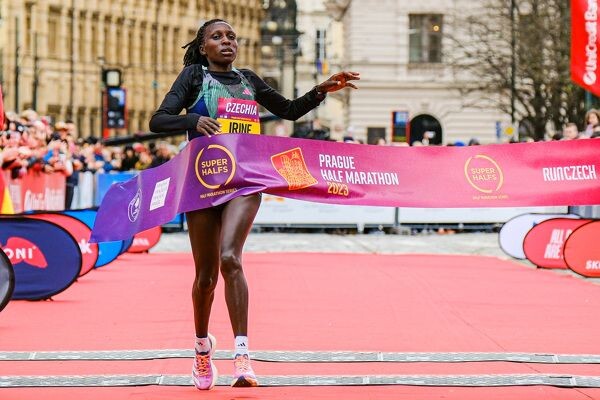
“I am working extra hard in training because I want to make the national team. My eyes are set on the national trials for the World Championships in the next two weeks. If I manage to make the final team, it would be my greatest happiness. Of course, all that depends on how I perform at the trials,” the South American Half Marathon champion said.
Kimais was a disappointed woman at last year’s national trials for the World Championships in Oregon, United States, after she clocked 32:02.53 to finish fifth in the women’s 10,000m.
On Friday, she went some way towards righting the wrongs of 2022 when she clocked 31:56.37 to win the women’s 10,000m at the Athletics Kenya (AK) National Championships at Nyayo Stadium.
In second place was North Rift’s Catherine Releen who timed 31:57.79 as Chicago Marathon champion Ruth Chepngetich clocked 32:09.87 in third place.
Kimais said the win has boosted her morale ahead of a cutthroat fight for a place on the plane to Hungary for the World Championships, come August.
“I came here to see how much more work I have to do before the national trials. I know I now need to work on my time ahead of the competition. I have been training in Kapsabet and I can say, so far so good. I will try my best to ensure I am among those selected in the final team,” she said.
(06/25/2023) ⚡AMPThere’s a Six-Day Ultramarathon Happening Inside a Speed Skating Rink
Runners have been logging miles around a 443-meter running track all week. Last year’s winner ran 437 miles.
While summer racing heats up, some ultra athletes in Milwaukee are keeping on their layers as they race ’round the clock at the Six Days in the Dome ultramarathon. Held inside the Pettit National Ice Center, which houses two full-sized hockey rinks and a speed skating track nestled inside the 443-meter running track, the facility’s temperature is kept at a steady 55 degrees year-round.

That’s the point in this competition, which originated in 2014 at the Alaska Dome in Anchorage—where Joe Fejes broke the then American record for six days by running 580 miles. Eventually, the race relocated to Milwaukee for its second running in 2019. Whereas many ultra competitions feature rough terrain, brutal conditions, and require an “expect anything” mindset, the original race director, Steve Durbin, wanted to create an ultra race in a fully-controlled environment.
But just because the environment is carefully calibrated for racing success doesn’t mean the great distances require any less mettle than ultras that are contested in rugged outdoor settings. Ultramarathon running requires a great deal of planning—runners schedule their sleep, kit changes, showers, and fueling, and must stay on top of the unavoidable blisters, chafing, and other small aches and pains that can end their race if not tended to.
“The thing about ultra-running, the finish is not a guarantee,” race co-director Mike Melton told UrbanMilwaukee.com. “That’s part of the challenge. How deep into yourself will you go? How deep into the pain cave can you handle? How can you manage the sleep deprivation, the miles you want to do? Everyone’s motivation is something different, something unique.”
As Saturday night looms, athletes are nearing the end of the nearly weeklong competition, which began on June 18. The stakes are high, as those who place in the top six will secure their place on the U.S. 24-Hour National Team. As of Wednesday afternoon, Romania’s Nicolae Buceanu and Sandra Villines-Burruss from Florida were in the lead, at 268.268 and 243.243 miles, respectively.
Canadian Viktoria Brown took the win last year with a total of 457.4135 miles, setting two Canadian records and one world record in the process, but she didn’t return to defend her title, so the multi-day competition is anyone’s game at this point.
In addition to the six-day competition, there are 12, 24, 48, and 72-hour categories, and several attempts at records have been pursued. New Delhi’s Meenal Kotak was cheered on Wednesday afternoon as she completed her 72-hour attempt, recording just over 235 miles and setting a women’s record for India.
(06/25/2023) ⚡AMPby Runner’s World
Here’s What 30 Days of 5Ks Did to This Guy’s Body
YouTuber Tom Morley documented the effects a daily three-mile run had on his weight loss and overall fitness.
Between his studies and freelance work, Tom Morely spends most of his time sitting at a desk. While he does train weights several times a week, he does little to no cardio, and so in a recent YouTube video, he decided to add some physical activity to his daily life. Specifically, he sets himself the challenge of running a 5K every day for a whole month, to see what kind of effect it will have on his overall health and fitness.

"I know it's going to be a hard challenge, and I know I'm gonna want to quit at times, but if I can give it my all, if I can throw everything into this, I really think I can do it," he says, adding that he will take measurements of his arms, chest, legs and waist on Day 1 and Day 30: "I want to see how my individual body parts react to this 30 days."
On the first day of the 30-day challenge, Morley completes his first 5K run in exactly 33 minutes, which he is not entirely satisfied with—and his time increases each day after that.
"Unfortunately, getting a bit slower each day was the pattern for about a week," he says. "The pain just got so bad in my calves and my knees because obviously I hadn't been doing this level of intensity in terms of cardio probably ever. My legs were starting to struggle with that."
When his time finally begins to improve in the second week, Morley feels much more "motivated to progress," and pushes on. "I'm starting to enjoy running," he says. "I never thought I'd say those words."
His time on the 5Ks continues to decrease into the third week of the month, and he achieves a series of new PRs, culminating in a 28:02 run on Day 20. Unfortunately, this is where the challenge hits a painful, impassable obstacle: Morley breaks his leg.
"It's just so annoying when you try so hard, and put so much time and so much energy into something, and then something like this happens and completely kills it," he says. "I worked so hard for the results that I'd already seen, and I'm sitting her, 11 days after surgery... I can't even walk without crutches... Right now I can't even imagine doing that again."
"I'm absolutely gutted," he says. "I really was looking forward to Day 30 here, to see the results, had my body fat percentage decreased, had my muscles increased in size, or maybe lost some size due to the weight loss? I was really intrigued to see what would happen there."
Morley notes that in the 22 days where he was able to complete a daily 5K, he lost 9 pounds (4.1 kg) and is proud that he was able to knock nearly 5 minutes off his PR—and he says he looks forward to trying the full challenge again once he has healed.
(06/25/2023) ⚡AMPby Men’s Health
2023 Western States 100 Women’s Race
None of the first four women from last year’s race — Ruth Croft, Ailsa MacDonald, Marianne Hogan, Luzia Buehler — returned. That made Zimbabwe’s Emily Hawgood (pre-race interview) the highest returning finisher from 2022. Hawgood’s pretty much a race local now too, living in nearby Roseville, California. But it was 38-year-old Courtney Dauwalter (pre-race interview) that came into the race as a favorite. She won here in 2018 in 17:27 and was looking to avenge a late drop at the 2019 race.
Dauwalter was first up the Escarpment. At 2,500 feet, it’s the race’s biggest climb and it happens right away in the first three miles. But 2022 UTMB winner Katie Schide (pre-race interview) was right there too. Schide, an American who’s lived in France for the past seven years, hit the top in 46 minutes with Dauwalter and the two dropped into the Granite Chief Wilderness together. Already Dauwalter and Schide, age 31, had a three-minute lead on third-place Ida Nilsson (pre-race interview) from Sweden.


By mile 11, Lyon Ridge, Dauwalter and Schide’s lead on third-place Nilsson had ballooned to eight minutes. And then it got even bigger as the two completely broke away from everyone else. At mile 16, Red Star Ridge, no one was within 14 minutes of the front two. Nilsson, Hawgood, 2023 Black Canyon 100k winner Keely Henninger (pre-race interview), Taylor Nowlin, professional triathlete-turned-ultrarunner Heather Jackson, Canada’s Priscilla Forgie and Jenny Quilty, and 2022 sixth-place finisher Leah Yingling (pre-race interview) all ran inside the early top 10.
The Mosquito Fire limited crew access this year and everyone met their crews for the first time at mile 30, Robinson Flat. Dauwalter was in at 5:07 and out within a minute, and still on her 2019 splits. Schide took a longer break and changed shoes, exiting the aid station three minutes behind the leader. The two had completely broken open the women’s race. Nilsson, in her 100-mile debut, had been alone in third to this point, but was now joined by Henninger, Hawgood, and Nowlin.
At mile 34, Miller’s Defeat, the course record watch started. Dauwalter and Schide were under Dauwalter’s own 2019 splits and Ellie Greenwood’s 2012 course record pace. Dauwalter was five minutes up on Greenwood’s splits, and Schide was three minutes faster. Even more, the two were over 30 minutes in front of third-place Hawgood at mile 38. Dauwalter and Schide were out front for the win and the course record, and the other contenders grouped behind them.
Dauwalter was red hot up the Devil’s Thumb climb at mile 48, but Schide hadn’t given up much time. She took longer in aid and left six minutes after Dauwalter. Hawgood, Nowlin, and Henninger came in together next, now 40 minutes behind second-place Schide.
At Foresthill, Dauwalter was 25 minutes up on record pace. Schide conceded only another two minutes over the last stretch and was 11 minutes behind Dauwalter. While Dauwalter and Schide were still off the front, the race dynamic was heating up behind. The third- through eighth-place women were all in Foresthill together with only three minutes separation. Hawgood was there first among the chase group, but Hungarian living in Hong Kong Eszter Csillag quickly jumped from eighth at mile 52 to fourth at mile 62. Nilsson was fifth, and Henninger, Katie Asmuth, and Nowlin were all there too.
Dauwalter ran 2:10 from mile 62 Foresthill to mile 78 at the American River. Only the men’s winner would run a quicker split on this day, and only eight men have ever run a faster split in the race. Dauwalter was five levels better than everyone else, and she was boldly racing without a pacer too. Schide stayed comfortably in second, but fell further behind Dauwalter’s quickening pace and river conditions necessitated that everyone cross the American River in a boat this year.
From Foresthill to the river, Katie Asmuth vaulted into third, past Eszter Csillag and Ida Nilsson. Asmuth was seventh at Foresthill and picked up four spots on the downhill Cal Street stretch, outrunning common expectations in coming back from injury. All three women split faster from Foresthill to the river than Schide did and even if the front two were gone, the women in general were running really fast. There’s bound to be some bad luck in a 100 miler though, and Henninger fell just before the river and dislocated her shoulder. She would then drop from the race at mile 80, Green Gate, due to that injury.
Dauwalter’s incredible second half and incredible race brought her to the Placer High School track finish in 15:29. Dauwalter completely shattered the record books and set a new standard that is likely to last for a lifetime. Ellie Greenwood’s 16:47 course record had stood since 2012. Dauwalter will next race the high altitude 2023 Hardrock 100 in Silverton, Colorado, on July 14. Dauwalter is the Hardrock course record holder, too, but Western States plus Hardrock will certainly be a challenging double.
Schide challenged Dauwalter early, and outpaced the rest of the women’s field in doing so. Schide was in second for much of the day, ultimately finishing as runner up in 16:43. That was also under the old course record.
Csillag, who was fifth at the 2022 UTMB, had a remarkable second half to finish third in 17:09. It is the race’s fourth-fastest run ever. And she just edged out Asmuth, who moved up from last year’s ninth-place run to finish fourth in 17:21. Asmuth’s time was just inside of Ruth Croft’s winning time from last year, and is the race’s fifth-fastest ever.
Hawgood earned a second straight fifth-place finish. In 2022 she was able to finish fifth in 18:16 and in this year’s faster race Hawgood was fifth in 17:26. That time ranks eighth-best ever and is just faster than what Dauwalter ran to win in 2018.
Taylor Nowlin improved her finish place by one from prior year, but like Hawgood greatly improved her finish time. Nowlin was sixth in 17:40. One-hundred-mile debutante Ida Nilsson was seventh in 17:43, and Priscilla Forgie was just minutes back in eighth at 17:46. Leah Yingling was a repeat top-10 finisher in ninth at 17:49. For perspective, no year had seen more than three women finish under 18 hours before. But this year nine women finished under 18 hours. It is the new standard for women’s racing at Western States.
The 25-year-old Meghan Morgan took the prized 10th-place finish in 18:11, thereby guaranteeing a chance to automatically return next year.
(06/25/2023) ⚡AMPby Justin Mock I Run Far
Western States 100
The Western States ® 100-Mile Endurance Run is the world’s oldest and most prestigious 100-mile trail race. Starting in Squaw Valley, California near the site of the 1960 Winter Olympics and ending 100.2 miles later in Auburn, California, Western States, in the decades since its inception in 1974, has come to represent one of the ultimate endurance tests in the...
more...2023 Western States 100 Men’s Race
There’s nowhere to go but up at the start of the Western States 100, and Jia-Ju Zhao from China charged the opening climb. Despite snow, Zhao hit the top in 42 minutes. Slower to the top, Frenchman Mathieu Blanchard (pre-race interview) and Brit Tom Evans (pre-race interview) turned to greet the brilliant sunrise together.
Zhao won the Ultra-Trail Mt. Fuji 100 Mile in April 2023 and is a two-time winner of the Doi Inthanon by UTMB 100 Mile in Thailand. He pushed his early lead to five minutes at Lyon Ridge, mile 11, while 2022 fourth-placer Tyler Green led the early chase group. Green had finished as high as second here before, in 2021, but was running more aggressively toward the front earlier than ever before.From mile-15 Red Star Ridge to mile-25 Duncan Canyon, the chase group started to make up time on Zhao. Tom Evans, Chinese runner Jia-Sheng Shen, and Dakota Jones (pre-race interview) were among a group that cut four minutes from Zhao’s lead over just nine miles. Evans was third here in 2019 in 14:59, and Jones had just biked 680 miles from his home in Utah to the race start.


Zhao was quickly swallowed up in the next five miles to Robinson Flat, mile 30, and soon fell out of the top 10. A lead trio of Tom Evans, Dakota Jones, and Jia-Sheng Shen came into aid at 4:45, meeting their crews for the first time. At mile 30 and with Zhao falling backward, Anthony Costales (pre-race interview) was fourth, and then he was with Tyler Green at mile 38 in fourth and fifth. The two would barely separate the rest of the race.Evans and Jones dropped Shen on the climb to Devil’s Thumb, mile 48, and the two leaders came into aid together in 7:03. Four minutes back Costales had caught Shen on the big climb, and Tyler Green, Jeff Colt, New Zealand’s Daniel Jones, Ryan Montgomery, Mathieu Blanchard, and 47-year-old Ludovic Pommeret were inside the top 10. Those six were 14 minutes apart. 2022 third- and second-place finishers Arlen Glick (pre-race interview) and Hayden Hawks (pre-race interview) were back in 11th and 16th, respectively. After earlier moving up, Hawks had just lost several places and would later drop with injury at mile 55. Other top-10 finishers from 2022 Cody Lind, Scott Traer, and Alex Nichols were all noticeably outside the top 10 too.
As the race shifted to its mile-62 Foresthill hub, Evans gained some separation on Jones and entered the aid station first, but as Evans changed shoes and socks, Jones didn’t wait and exited first. Jones was now in the lead by himself for the first time and he was overheard voicing his intention to break Evans. Some 11 minutes back of those two leaders, Green and Costales were again together and in third and fourth. Shen and Jeff Colt were just minutes back of those two, and Colt was remarkably almost an hour faster than a year ago when he finished 11th.Jones and Evans separated leaving Foresthill and anticipation ran high for their next steps. The two had been together for nearly the entirety of the race to this point. Jones wanted to make a move and Evans wanted to keep up with (the) Jones. The duel ended quickly and dramatically though. Tom Evans dropped a 5:54 downhill mile and hit Cal 2, mile 71, in 10:12. That surge pushed Jones eight minutes back at mile 71. It was just nine miles from Foresthill to that split on Cal Street, but the front two had shattered and moved in opposite directions the rest of the race.
Evans ran alone to the river crossing at mile 78, and ultimately to the finish. Tyler Green, Anthony Costales, Jeff Colt, and Jia-Sheng Shen all overtook Dakota Jones on the way to the river too. Forget about Elm Street, Jones was having a bit of a nightmare on Cal Street.
Evans, the 2022 UTMB third placer, continued to put time on the field the rest of the way. He finished in 14:40 and that’s the race’s fourth fastest finish ever. The mark trails only Jim Walmsley and Jared Hazen in 2019, and Walmsley’s 2018 mark too. Evans was a runaway winner, but the rest of the top 10 was much more closely packed.Tyler Green pushed on in second, and held off an Anthony Costales chase over the last 15 miles. Green finished in 15:04. It was his second runner-up finish and a big personal best for the course. He was able to finish with his baby boy on his shoulders. Green’s 15:04 was the race’s 11th-fastest finish ever. Costales was third in 15:09, the race’s 13th-fastest finish ever.
Jia-Sheng Shen and Daniel Jones both finished fast. Shen clocked 15:19 and Jones was fifth in 15:22. Mathieu Blanchard and Ryan Montgomery both overtook Jeff Colt late. Those three — Blanchard, Montgomery, and Colt — finished in 15:37, 15:38, and 15:42, respectively. Local runner Cole Watson bettered his 2022 14th-place finish with a ninth-place 15:54.
In 2019 the top 10 all went under 16 hours. This year’s 10th-place man Janosch Kowalcyzk from Germany just missed matching that feat. He finished in 16:09.
Seven of last year’s top 10 returned, but only Tyler Green was able to again make the top 10. The 2022 top 10 finishers Ludovic Pommeret, Arlen Glick, Scott Traer, Cody Lind, and Alex Nichols finished 12th, 13th, 15th, 16th, and 28th this year, respectively. As earlier mentioned, 2022 runner-up Hayden Hawks dropped.
After running near or in the lead through Foresthill, Dakota Jones finished 17th in 17:00.
Early leader Zhao’s high risk, high reward start ended with a drop at Michigan Bluff, mile 55.
(06/25/2023) ⚡AMPby Justin Mock I Run Far
Western States 100
The Western States ® 100-Mile Endurance Run is the world’s oldest and most prestigious 100-mile trail race. Starting in Squaw Valley, California near the site of the 1960 Winter Olympics and ending 100.2 miles later in Auburn, California, Western States, in the decades since its inception in 1974, has come to represent one of the ultimate endurance tests in the...
more...Why You Need Zone 2 Training in Your Workout Plan
How easy workouts can bring big rewards.
A minute ago, high-intensity interval training (HIIT) was king. Now that gut-it-out-and-get-the-glory work might need to share the crown with slow and steady efforts, thanks to what they do for your body, your longevity, and maybe even your mind.

These are the famous zone 2 workouts—keeping your heart rate between about 70 and 80 percent of its maximum—that runners, smart gymgoers, and everyone with a podcast is talking about these days. Think of zone 2 as the range between easy and moderate cardio, where you can carry on a conversation but someone on the other end of a phone would know you’re not sitting down. (Find out more on how to know you’re in the zone by checking out the chart below.)
What happens in zone 2 powers up your endurance, your lifting routine, and your general performance as a human being, proponents say. Here’s what to know about the zone.
How an Easy Effort Brings You Gains
Endurance athletes, such as marathoners, cyclists, and Ironmen, have long understood that zone 2 training is a key to performing well on race day. Look at Eliud Kipchoge, the world’s fastest marathoner, who spends four days a week running in zones so low that any decent runner could keep up with him. Lower-zone training yields high results in endurance sports, says Mike T. Nelson, Ph.D., C.S.C.S., owner of Extreme Human Performance, possibly “because the athletes aren’t out there just trying to fry themselves crazy every single day.” A long Z2 effort today leaves room for more time on your feet or in the saddle the next day. But another huge perk of Z2 training, no matter your sport, is the adaptations your body is making deep within your cells.
It all goes back to your mitochondria, the parts of your cells that generate ATP—that’s the fuel that drives muscle contractions. With age, your mitochondria get kind of like old dog fur: sparse, damaged, and inefficient. “Zone 2 cardio basically helps build your mitochondria,” says Kenneth Jay, Ph.D., a sports scientist who’s done research with the National Research Centre for the Working Environment in Copenhagen. These workouts help you produce more of those cellular powerhouses and shed old, damaged ones. When you get out of that zone, you start using a different energy system that doesn’t stimulate mitochondria to the same extent.
These cellular improvements can help you make gains in lifting, too, by aiding your recovery between sets. People without healthy and plentiful mitochondria “just don’t have the capacity to regenerate ATP fast enough to repeat something. And what they are repeating is half the output of what they were doing at the beginning, so they’re not getting the stimulus that they could,” Nelson says.
Building mitochondria might not get you ripped, but it deserves a lot of cred given that “mitochondrial dysfunction” has been linked to cardiovascular disease, cancer, diabetes, and obesity. Shoring them up with Z2 essentially gives you a more efficient engine to get through life on. “It’s like a hybrid car,” explains Stephen Seiler, Ph.D., a professor of sports science at the University of Agder in Kristiansand, Norway, who’s studied the effects of high- and low-intensity zone training in athletes. Redlining your workouts saps battery power. “You can run off the battery for a little while, but to pay it back, you’ve got to have your main engine.” Consistent Z2 work not only helps you recover better between sets or workouts, but it also helps you get better at everyday challenges: a family hike, an extra-long-haul rush to your flight gate, or a grueling workweek.
Does Zone 2 Work Have to Be Cardio?
In general, yes. That’s because a big benefit of zone 2 cardio is that it helps keep your heart strong and, basically, stretchy. When you lift heavy, your heart’s left ventricle—the one that pumps oxygenated blood to the rest of your body—gets tough, too. Heavy loads make your heart contract in a way that causes it to lay down more muscle fibers. But it lays them down inside the chamber, so there’s less room for blood. (Don’t get smug, endurance folks; a huge amount of cardio makes yours too thin and can leave you vulnerable to issues like atrial fibrillation.) Zone 2 cardio moves blood through the heart in a way that keeps walls at a healthy thickness and stretchiness, so it functions better, says Jay.
There’s debate on exactly how much time you need in Z2 to get the benefits. If you’re mostly sedentary now, any amount of low-intensity movement will help. If you’re somewhat or very fit, experts typically promote a minimum of 30 to 40 minutes of zone 2 cardio twice a week. (For endurance athletes, 80 percent of total training volume in Z2 is a good guideline). The trick is not turning that cardio workout into a sprint endorphin rush. Once you start pushing the intensity, cellular by-products (lactate) begin to accumulate and a different energy-producing process starts to take over. And that’s not what you want to train in these workouts.
Zone 2 is chat-paced work, so bring friends. Fit people might need more than a casual walk; hiking and rucking uphill can get you there. Keep it interesting in the gym by giving ten minutes each to the rower, bike, and treadmill. The key is control. “There is a warrior aspect to this as well,” Seiler says. When you have the discipline to stay in the zone, “there can be a Zen there in going out and finding your rhythm and not be influenced by the person who runs past you that day,” he says.
When it comes to creating a more efficient engine, easy really does do it. It’s not like you can’t have go-hard-or-go-home workouts; you need those, too. But being smart about adding a little low can feed your high.
(06/25/2023) ⚡AMPby Men’s Health
Genevieve Clemons Won’t Let Anxiety Run the Show
When she started her freshman year during the height of the pandemic, the college student felt trapped. Then she started running.
Genevieve Clemons told her story to producer Ann Marie Awad for an episode of The Daily Rally podcast. It has been edited for length and clarity.

I was in a dormitory with one other roommate, but because classes were online, we spent most of our time in this tiny room, taking online classes. And so I just felt really cooped up, irritated, unmotivated. I wanted to find my community, and I just hadn’t.
I go by tons of nicknames, kind of dealer’s choice, but just generally Genevieve.
I am currently going to be a senior at the University of Texas at Austin. I would say two of my biggest passions would have to be nature and wildlife. And, recently, a big passion of mine has become running, just anywhere, as far as I can go. I love running.
When the pandemic hit, it was the end of my senior year of high school, and I was honestly quite miserable even before the pandemic started. I was dealing with some anxiety and perfectionism. I didn’t really feel like I fit in in my high school.
I didn’t have the best experience with high school sports. I was on the tennis team, but I had a coach that treated me not the best. And so I just kind of had a complicated relationship with sports, and I was also having a hard time balancing academics with everything else. I just took things really seriously. I graduated as Valedictorian, but I wasn’t happy.
I wanted to change a lot of things about my life, my outlook and the way I was living it. I saw college as an opportunity for that.
Coming out of high school, I didn’t really have a lot of connections and friendships, and I was really depending on having that normal freshman-year college experience to help me bounce back. So when the pandemic hit, I got pretty depressed.
Having to be cooped up inside all day started out kind of exciting, like, Whoa, what’s happening? Finishing out high school, we get to do school online, it’s easy, and then it just kind of dragged out. I started out my freshman year at UT in the middle of the raging pandemic, and it was fully online, so that was pretty difficult.
At that point where I was really seeking balance, I was like, Maybe I just take everybody else out of the equation, and I just fully look for something and do it because I love it and I want to do it. Maybe that’s the answer.
I knew my dad was a marathon runner, in his younger days. And I was like, Why don’t I try running? And honestly, I hated it in tennis, when we had to do running. Hated it. But I was like, you know what? I’m gonna try it, but I’m gonna do it my way. So I just literally put on some shoes and started running. I didn’t want anyone to know I was running. I didn’t want to know how fast I was going. I just wanted to get out there.
For several, several months, I would just go out on this trail by my house. Sometimes it was just a mile, and that mile was freaking hard, and I would feel accomplished because I was really just shutting everything else out. And it was, How did I feel today? Slowly I had little victories and little moments like, Oh, I actually kind of felt not out of breath today, or, I ran a little faster or went a little further. I was hooked.
I started to run further and further. And I just loved it. I loved the feeling of pushing myself in that way, in the endurance way. I was attracted to distance running. So, one day, I was like, I want to run a marathon. And I shocked myself when I said that, but I was like, my dad did it, I want to do it. I want to see what it’s like.
In my head, when I say something out loud that I’m gonna do it, I’m gonna do it. I was so intimidated. I was like, The last thing I want to do is run with all these people. They’re gonna see how slow I am, they’re gonna see I’m not a real runner. But I was like, You know what? This has all been good so far. Just try it. And that was my new goal after getting out of high school and letting anxiety run the show. I was like, I’m not doing that anymore. Let’s just go.
But I knew that’s the kind of stuff you can’t do alone. Sure, there’s the internet, but I wanted to talk to some people that had done it. So I went to these running groups, and I found a community that I was so embraced by. In sports as a kid, I was always on the sidelines breathing really hard, and the coach was like, “Come on.” I wasn’t used to these people just believing in me and seeing my potential, and wanting to share the gift of this sport.
I did my first trail race, and I was so scared. But my family came and I was like, You know what, I’m not gonna worry about it. I got out there, and I have never ran, or competed, or done something where I felt so joyful. We were all out there to have fun. I would pass people on the trail in the race, and they would say, “Hey, great job.” It was just so encouraging.
So, I just catapulted off from there. I’ve run probably about nine races, maybe ten so far.
Seeing other people believing in me, I realized I could also believe in myself. I think whatever that looks like, having some kind of faith in yourself, listening to whatever that is inside you that guides you to do things—that light, that spark in you—instead of walking in fear and doubt. Everybody has those thoughts, I sure do still. If I’m about to sign up for a race, I think, Are you sure you can do that? Or, Is this really for you? Or, as I’m sure everyone thinks, Can someone like me really do this? To recognize and say, Hey, I’m hearing these voices of doubt, but right now, I’m gonna choose to listen to something else.
Genevieve Clemons is a senior at the University of Texas at Austin, majoring in biochemistry. Earlier this year, she competed in her first 100K race. She was nominated for the show by her very proud dad.
(06/24/2023) ⚡AMPby Outside Online
Training Advice from the Greatest Women Masters Marathoners Alive
While Jeannie Rice and Jenny Hitchings are busy setting masters world records, their differences in training are even more instructive than their similarities
The spring marathon season has come and gone, and it didn’t disappoint, producing sensational races and world headlines. This was particularly true in Boston and London. However, you might have heard little or nothing about two of the best marathon performances in those events.


The big media coverage went to seemingly-unbeatable Eliud Kipchoge, who finished sixth at Boston, where Evans Chebet gained his third straight World Marathon Major victory in 12 months. At the London Marathon, Kelvin Kiptum ran 59:45 for the second half, en route to a course record 2:01:27, and Sifan Hassan demonstrated that she can win in the marathon as she has at multiple shorter distances.
But 75-year-old Jeannie Rice and 59-year-old Jenny Hitchings outran them all, on an Age-Gender performance basis, both setting new world records for their age groups. Rice’s 3:33:15 in Boston won’t count, since the Boston course is considered ineligible due to its significant downhill slope and point to point layout, which allows for a tailwind boost. Still, she beat the fastest 75-79 age-group male runner by more than 20 minutes, which has likely never happened before in a global marathon. And five weeks before Boston, at age 74, she ran 3:31:22 in the Tokyo Marathon.
A week after Boston, Hitchings ran 2:45:27 in London—a marathon world record for women in the 55-59 age division. Remarkably, she’s at the high end of that age range, as she’ll turn 60 in early July. Not only that, but it was her personal best marathon in 40 years of running.
Rice was born in South Korea and immigrated to the U.S. in her mid-30s. A retired real estate agent, she now divides her time between south Florida and Cleveland. Hitchings is a longtime resident of Sacramento, California, where she works as a middle-school cross-country coach and a private running coach.
Rice and Hitchings live on opposite coasts, but they have much in common. They’ve both been running for decades, both are extremely consistent in their training, and both log multiple 20-milers in their marathon buildups. Surprisingly, neither makes a particular effort to include hill training, a staple among other top marathon runners. Both are small and lean. Rice stands 5-foot-2 and weighs 96 pounds; Hitchings is 5-foot-4 and 100 pounds.
But Rice and Hitchings also present some stark contrasts. These differences carry an important message: There are many paths to marathon success, and the best senior runners understand this. Through their experience and wisdom, they’ve learned to focus on the positives and jettison the junk.
Here’s a look at some of the major contrasts between master marathon greats Jeannie Rice and Jenny Hitchings.
Both Rice and Hitchings had previously won age-group titles at Boston. Rice chose to return there in April for emotional reasons, as Boston marked her 40th anniversary of marathon running and her 130th marathon. Hitchings selected London for technical reasons. In 2021, she ran 2:45:32 at Boston. It would have been a record except for the point-to-point course prohibition. So this spring she opted for London’s record-eligible course.
Rice: “Boston has always been a special marathon for me,” said Rice. “My preparation wasn’t the best, as I ran the Tokyo Marathon in early March, and then did some traveling. But I wanted to have my Boston celebration, and I had quite a few running friends there with me.”
Hitchings: “London was on my marathon ‘bucket list’ anyway, and it gave me a great opportunity to set an age-group world record,” said Hitchings. “Since my 2:45 at Boston didn’t count, I figured I should take a crack at London while I was still in the age group.” [She will turn 60 in early July.]
Rice has always been self-coached. Hitchings, a running coach herself, has had a longterm coach-athlete relationship with Chicago-based Jenny Spangler. Spangler won the U.S. Olympic Trials Marathon in 1996 and ran a 2:32:39 marathon in 2003, after turning 40.
Rice: “I’ve been approached by people who wanted to coach me, but they seemed expensive and had other demands I didn’t like. I listen to what my friends do and what others are doing in training. I try to run 50 miles most weeks, and a bit more before my marathons. But I don’t actually follow a schedule. Mostly I just train the way I feel. I’m still running strong and beating records, so I must be doing something right.
“I know it’s possible that a coach could help me the way Gene Dykes’s coach helped him, but it’s also possible that things could go wrong. I like to decide my training according to how I feel each day.”
Hitchings: “I coach other runners, and I could certainly coach myself, but you know what they say about doctors who treat themselves: They have a fool for a patient. I think that can also apply to athletes who coach themselves. It’s just smarter to have someone looking over your shoulder, and adding some perspective.
“I’m one of those who’s often guilty of running too fast on my easy days, or getting excited and going too hard when I’m training with friends. Jenny [her coach] holds me accountable for those kinds of things. She has a great personal performance record that I respect a lot, and has been coaching for many years.
“It’s also important to me that she’s a female coach of my own age. She understands what I’m going through and dealing with in terms of female physiology.”
Both runners say they enjoy a relaxed morning cup of coffee before launching into their days. But Rice is up earlier, and often out the door quicker. Hitchings needs more time to be ready for a solid run.
Rice: “I like to get my run done early, so I have the whole day in front of me when I get back home at 7:30 A.M. or so. I’m usually running by 6 A.M. In Florida, where I spend my winters, that can be important for the cooler weather.
“But on days when I’m going 20 to 23 miles, I’ll get up at 3:30 A.M. and begin running at 4:30 A.M. I’ll go two hours on my own, and then join a local training group for their morning loop, which gives me another hour or so.”
Hitchings: “I coach a number of people who can roll right out of bed and start running. I’m not one of those. My favorite time to run is about 8 A.M. or 8:30 A.M. in the morning. I like my coffee first, and the morning newspaper, and I always make sure to get a light breakfast in my stomach. Since my favorite place to run is the American River Parkway, that gives me another 15 minutes of drive time before I get going.
“There have been times when I had to be a noontime runner, and that was OK, too. But 4 P.M. or 5 P.M.? That’s not going to happen. By that time of day, I’m too tired or depleted.”
This one is easy for Rice, who has never been injured except for a fall (and banged-up knee) in 2021 that cost her several weeks of running. Hitchings also considers herself relatively injury-free, but she has encountered an assortment of typical runner injuries through the years: Achilles tendinitis, piriformis pain, and surgery for Haglund’s deformity (a bony growth at the back of the heel resulting from mostly genetic causes).
Rice: “I go to the gym three times a week for a light strength workout, some pushups, and some stretching. But it’s not a serious session at all. I also golf for fun; I really enjoy golfing.”
Hitchings: “I try to do light weight work as much as I can, and I ride my bike 20-30 miles a week outdoors, and do Peloton indoors. Recently, I added Pilates once a week to improve my strength and mobility.
“Also, Jenny and I have agreed to take one hard running day out of my weekly schedule. I used to do speed work of some kind on Tuesday and Thursday, and a long weekend run. Now I’m down to speed on Wednesday, and a weekend long run that often has some tempo-pace segments.”
While both are clearly fit, Rice and Hitchings say they enjoy a wide variety of foods, and have no particular restrictions in their diets. Both enjoy wine drinking. Hitchings admits to a sweet tooth, too, but desserts are not a problem for Rice.
Rice: “Breakfast is usually oatmeal with fruit and nuts. At lunch and dinner, I enjoy a green salad with some sort of seafood or fish on top. I’ve never liked sweets and don’t crave them, but I love cheese and nuts. That’s my big downfall—cheese and nuts. The only supplements I take are calcium with vitamin D, B-12, and magnesium.”
Hitchings: “I eat ‘clean,’ a well-balanced diet with an emphasis on carbs. I simply don’t feel good if I eat heavy, creamy, or fried foods. I get most of my vitamins and minerals from real foods, though recently I’ve added Athletic Greens to my routine.
“When I’m in heavy marathon training, I find it hard to maintain my weight, so I’ll have some protein shakes and maybe one chocolate bar, muffin, or pastry per day. I’ve got a drawer full of vitamins, calcium, collagen, and iron supplements, but I never seem to stick with any for long. It’s just too much.”
While realistic about their futures, neither Rice nor Hitchings sound the least bit intimidated by the unwritten future. Despite aging, both are driven to perform. They hope to keep running hard and fast, and chasing age-group records. Both plan to run the Chicago Marathon on October 8, as it will be the site of this year’s Abbott World Marathon Majors Wanda Age Group Championships.
Rice: “Getting faster at 75 is almost impossible, but this year I’m going to run a few road miles to work on my speed. I’ve won my age group in every World Marathon Major but London, so I want to get back to London in the next several years. I want to run the Sydney Marathon, the Ho Chi Minh City Marathon, and, of course, I must run the Seoul Marathon in the country where I was born.”
Hitchings: “I’m running faster at 60 than I’ve ever run in my life. My time in London was literally my lifetime best, and I’ve been running a long time. Sometimes I get asked, ‘When are you going to stop running?’ My answer is always: ‘Why would I stop?’ I’m still getting faster, and I’m still enjoying it.”
Rice, though 15 years older, feels the same. It’s fun winning major marathons, of course, especially when she beats most men her age. In local and regional races, she challenges herself to finish as high as possible in the masters division against females three decades younger (and sometimes wins outright).
“I love competition,” she says. “I’m motivated to train hard, and I’m excited about setting more records as long as I can. Maybe into my 80s.”
Running is about finish times, sure, but it’s even more about attitude. Find the goal that’s right for you, and go after it. This is the approach both Rice and Hitchings have followed successfully, and neither plans to change course now, no matter how many candles adorn their next birthday cake.
Both are on a shared mission, and they’d like others to join them. As Hitchings says: “I think if we keep a positive attitude and motivation, we can go out there and do much more than people think. It’s important to show others that we can defy the way aging has been defined for us for so long.”
(06/24/2023) ⚡AMPby Outside Online
Former University of Oregon runner wins World Series of Poker event
Former University of Oregon track and field runner Chris Brewer has hit the jackpot, winning over $5 million and a prestigious golden bracelet at the 2023 World Series of Poker (WSOP). From the track to the poker table, Brewer won a high-roller No-Limit Hold’em event with a substantial $250,000 buy-in, with some luck on the river (final card).
Brewer had his back against the wall when his opponent, Russia’s Artur Martirosyan, raised him with ace-king. Brewer re-raised, pushing his chips all-in, which set up a bad beat for the ages that worked out in Brewer’s favour, netting $5.2 million for the win. Watch below.

Brewer, 30, ran for the University of Oregon Ducks cross-country and track and field program for five years and was a teammate to renowned athletes like Australian Olympian Jessica Hull, 17-time NCAA champion Edward Cheserek and American 25 km record holder Parker Stinson. During his collegiate career, Brewer held bests of 3:43.97 over 1,500m and 4:06 for the mile. When he graduated from Oregon with a degree in mathematics in 2016, he took a break from running and found success playing online poker.
In a 2021 interview with Pokernews, Brewer was asked if he credits his card-playing success to his running background, resulting in an all-time quote:
“Running is much harder than poker. You have to put in way more effort. Anything I’ve accomplished in poker is easy compared to waking up in the morning and running 15 miles,” replied Brewer. “When you’re a runner, you have to be mindful of your diet and sleep. Poker is a different ballgame—I sacrificed many years to pursue running. So if I have to fold a hand, it’s no big deal. I never felt anxious playing poker. Running races, on the other hand, gave me plenty of anxiety.”
Although Brewer may not see many similarities between the two, it is evident that the discipline and dedication he acquired from running have translated into his poker success.
(06/24/2023) ⚡AMPby Running Magazine
Canadian Olympian Julie-Anne Staehli gives old running shoes a new purpose
Canadian distance runner and Olympian Julie-Anne Staehli is renowned for her success in the 5,000m, but she has also made a profound impact through a project that’s close to her heart.The ReRun Shoe Project originated in 2016 during a local road race in Kingston, Ont., when Staehli and her friend, Kurtis Marlow, realized the number of shoes they accumulate each year. This gave her the idea of repurposing shoes to enable others in their physical activity. Staehli explains, “The project started with a personal donation to a local youth sports organization, which sparked the idea of repurposing shoes to make a difference in the community. With no local organization dedicated to donating lightly used shoes on a regular basis, we took the initiative to create The ReRun Shoe Project.”The primary objective of ReRun is to collect lightly used running shoes that are no longer suitable for running but that could be worn by those without access to expensive gear. By reducing the number of unused shoes and donating them to local organizations, ReRun aims to provide shoes with another purpose and enhance the lives of others.“Most of the recipients of shoes are elementary school and college students, but we have also built a network with organizations like Big Brothers and Big Sisters to ensure the shoes reach those who need them the most,” says Staehli.Julie-Anne Staehli: Run Your Way” — Canadian Running Magazine
Having grown up in the small town of Lucknow, Ont., Staehli feels personally connected to this initiative; she received her first pair of spikes through a donation. “Making physical activity more accessible and witnessing the impact, regardless of who receives those donations, is truly meaningful,” she says.

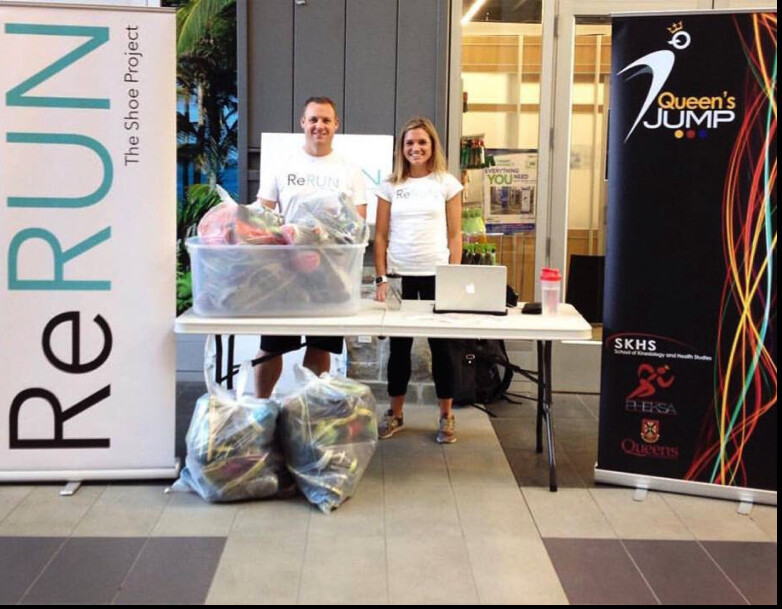
Staehli takes pride in the project’s meticulous selection process, accepting lightly used shoes with good soles that are still suitable for walking or other activities. Its mission is to ensure the shoes find their way into deserving hands.A poignant moment for Staehli and Marlow that reinforced their commitment to the cause occurred at a women’s shelter in Kingston. Staehli recalls, “We donated hundreds of shoes, mainly adult sizes, and all the shoes disappeared within the hour. This highlights the immense need for shoes in our community.”
To date, ReRun has collected more than 5,500 pairs of shoes. The project has expanded to collect donations in three stores in Kingston, two stores in London and multiple locations in Edmonton and Calgary. ReRun serves as a remarkable example of how a simple idea and a dedication to giving back can create a lasting impact on communities.y providing shoes with a new lease on life, ReRun is taking strides to make physical activity more accessible—one step at a time.
(06/24/2023) ⚡AMPby Running Magazine
NCAA likely to remove cannabis from banned substance list
An NCAA committee is pushing to remove cannabis from its list of banned substances, advocating that collegiate drug testing should instead focus on testing for performance-enhancing drugs rather than recreational/medical substances. The proposal was released by the Committee on Competitive Safeguards and Medical Aspects of Sports (CSMAS) on Friday and represents a significant divergence for the NCAA, which has been testing for cannabis at championship events for nearly four decades.
The committee has suggested a suspension of cannabis testing at all championship events until a final decision is reached. For the rules to change, the new legislation would need to be introduced and approved by all three divisions of the NCAA: Division I, II and III. Division II and III administrators were the ones who requested that the NCAA committee examine and challenge the current rules around cannabis.


This recommendation comes amid a growing trend in the U.S., with an increasing number of states legalizing medical or recreational cannabis use. Twenty-three states have now legalized it for recreational use. In the past two years, two prominent U.S. track athletes, Tara Davis-Woodhall and Sha’Carri Richardson, have served short bans for positive cannabis tests, both losing U.S. national titles as a result of their positive tests.
In 2021, the World Anti-Doping Agency (WADA) altered its code involving cannabis, allowing for a reduced sanction if the athlete’s use occurred out of competition and unrelated to sports performance.
Last December, CSMAS acknowledged that cannabis does not provide performance-enhancing effects and suggested implementing policies that instead address the potential risks associated with excessive recreational drug use by athletes.
Previous studies suggest that cannabis is not a performance-enhancing substance from the perspective of speed, power or strength. In one study, researchers had cyclists use cannabis and then assessed their performance on the bike. They looked at both speed and power, and both were decreased in the cannabis condition. Others showed minimal or no difference in performance.
A final decision is expected from the NCAA before the start of the fall season.
(06/24/2023) ⚡AMPby Running Magazine
UTMB book reveals the history of the famous event delving into controversy over prize money and the people behind the race
A new book to mark the 20-year anniversary of the Ultra Trail du Mont Blanc (UTMB) highlights the human story behind the event, contextualising controversies such as prize money.
“I don’t always agree with the founders’ decisions personally but I always found the answers very interesting and it gave me more perspective and understanding,” said Doug Mayer, 58, the book’s author.

The book – The Race that Changed Running: The Inside Story of the Ultra Trail du Mont Blanc – details the history of the UTMB with interviews with the founders Michel and Catherine Poletti.
The race is the most high-profile event in trail and ultra running. The main event is the 171km race from Chamonix, all the way around the Mont Blanc Massif, through Italy and Switzerland and back to Chamonix in France.
During the week, there are also other races: the 145km TDS, the 100km CCC and the 56km OCC.

The UTMB has often been criticised for being too commercial. They have expanded to different countries with races “by UTMB” and recently partnered with Iron Man to make a world series, through which runners can qualify for the main event in Chamonix.
The founders of the UTMB check the book for accuracy, but they were not allowed to change anything, and had no editorial control.
He did not shy from asking controversial questions. Some of his critical views of the race have been softened by the human side of the answers.
For example, the UTMB seemed to be making money, but offering little or no prize money to its runners, attracting a lot of controversy.
“It turns out that Catherine had been the treasurer of the Marathon Mount Blanc [a different race] many years ago at a time when East African runners were winning and she was writing cheques out to their managers,” Mayer said.
“She knew exactly what was going on – the money wasn’t going to the athletes, it was going to the managers. That horrified her. When she talks about that today, you can hear the indignant tone in her voice.
“That informed their thinking about prize money. For years, they saw prize money as corrupting.”
Since then, trail running has become increasingly professional. Runners and critics, including the Post, called for the UTMB to offer prize money. In 2018, they did. There were calls to give more than a token amount, to recognise that the athletes are professional runners who need to make a living.
Major publications like Outside Magazine had headlines such as “UTMB and ultrarunning’s amateurism problem”.
As of 2022, the UTMB offered US$10,400 to the winners of the UTMB, CCC and OCC, around US$5,200 for second place and US$3,125 for third. Fourth and fifth places got around US$1,500, while sixth to 10th earned US$1,000.
“I think one of their human faults is that they’re slow to change,” Mayer said, adding that he hoped people would be more forgiving of it.
One of the sources of the problems is that people have suggested the Polettis are in it for the money. In the book, the Polettis pointed out that they could have cashed out years ago. They said they wanted to pass the race on to their children.
Even the 40 per cent sold to Iron Man was not the 40 per cent they owned. It was sold to Iron Man by Group Telegram, although Iron Man did buy 5 per cent from the Polettis.
Mayer is American, but lives in Chamonix and speaks French. He has interviewed the Polettis many times but even he was taken on a journey.
“I learned a lot about them and that made them more human,” he said. “They’ve had their struggles, like all of us.”
Michel grew up in Chamonix. After university, he went to Paris to become a computer programmer.
“And he was miserable about it,” Mayer said. “A friend of Catherine said, ‘Well, you guys have a choice. It’s Paris and antidepressants, or it’s back to Chamonix.’ And they went back to Chamonix and moved into the garage of his father.”
They renovated the chalet, and it’s where they still live.
“They’re not the people that a lot of people think they are,” Mayer said. “The race is not entirely the race we think it is.”
(06/23/2023) ⚡AMPWorld class racing returns to Boston on Sunday with the BAA 10K
The BAA 10K is this Sunday in Boston. The elites—as well as a mass field of nearly 10,000 runners—will race through the streets of the Back Bay neighborhood.
Emily Sisson has her eyes on another American record; she’s been on a tear the past year on the roads. In October, at the 2022 Chicago Marathon, she took 43 seconds off Keira D’Amato’s American record, running 2:18:29 for second place. Three months later, at the Houston Half Marathon, she broke her own American record, crossing the line in 1:06:52. She’s setting her sights on Shalane Flanagan’s 10K record of 30:52, which Flanagan set at the 2016 edition of the BAA 10K.
Also toeing the line is Molly Seidel, who’s been running some shorter races to prepare for a fall marathon. In February, she finished eighth at the U.S. Half Marathon Championships in 1:13:08.
A slew of former Boston Marathon champions are also competing on Sunday. Hellen Obiri, who won April’s race, will line up next to two-time champion Edna Kiplagat and 2015 winner Caroline Rotich. The course record of 30:36 could be up for grabs.
The men’s field is highlighted by 2021 Boston Marathon champion Benson Kipruto, who won the BAA 10K in 2018. American Leonard Korir returns as the race’s reigning champion, taking last year’s win in 28:00—12 seconds off the American record of 27:48 that has stood since 1985. Gabriel Geay, Geoffrey Koech, and Tsegay Kidanu should also be in contention.
Those in the Boston area can catch coverage of the race on WCVB. The BAA Racing App will also provide live updates and results, but there is no stream of the race. The elites are scheduled to start at 8 a.m. ET.
(06/23/2023) ⚡AMPby Runner's World
B.A.A. 10K
The 6.2-mile course is a scenic tour through Boston's Back Bay. Notable neighborhoods and attractions include the legendary Bull and Finch Pub, after which the television series "Cheers" was developed, the campus of Boston University, and trendy Kenmore Square. ...
more...How to get into track running
As many parts of the world start to see the first signs of summer and the outdoor season gets under way, many will see it as a perfect time to make their own introduction to track running.
Taking those first steps can be a daunting task but there are some steps you can take to make the process easier.


How to find a club, coach and track races
Finding an athletics club can be an intimidating prospect but most clubs throughout the world are eager to increase their membership so you will likely be far more welcome than you first think.
Finding local athletics clubs can often be done by going on to the website of your national athletics federation where information is often contained about affiliated clubs as well as the registered coaches who train the athletes.
This is a good way of ensuring the club you are joining is properly trained, qualified and monitored.
Qualifications alone, however, may not show exactly what you’re looking for from a club and coach. Nowadays most clubs (and many coaches) will have various social media channels. Check them out and these may well provide a good idea of whether that club would be a good fit for you.
These pages will also often highlight any changes to training times or the right people to get in touch with to ask some questions. These channels are often much more regularly updated than websites so may be the best place to start.
While it is possible to find athletics competitions online, coaches at these clubs will be able to match your level to the appropriate competition. This means when you first decide to compete, you will be competing against people of a similar standard, making the whole experience more enjoyable and getting those competitive juices flowing.
Getting the right footwear
Athletics spikes are generally lighter than those you would use on the road, with a lower stack height and less support. That said, there do exist variances with some models offering more support than others.
The first times you wear spikes can cause a lot of pressure on your legs, especially the calves which are normally more cushioned by less aggressive road shoes.
When training on the track, many will choose to train in lighter road shoes, gradually introducing the spikes when their legs start to get used to the different impact of the track.
Speak to your coach and footwear specialists to decide what’s right for you and take time to introduce track spikes into your shoe rotation.
When taking part in competitions, it is important to note that many federations have adopted World Athletics' guidance on what shoes are eligible for competitions.
Whether your federation has adopted different rules will be something you should be able to find out from your coaches or the federation website.
Track etiquette
Often it can be intimidating knowing what to do on the track and you may feel self-conscious at the start but it is not as complicated as you might think.
The rules may vary from one facility to the next, but generally speaking if you are doing a workout on a track, you have just as much right as anyone else to use the inside lane (lane one) when carrying out your efforts.
If you are passed by someone, don’t feel the need to step into an outside lane as this may confuse the person running behind. Instead, stay on your line and the person approaching behind will normally run outside to overtake.
Equally, if overtaking someone, try not to undercut them and if you feel you might surprise them going past, a gentle call of “track” may alert them to your presence.
When warming up, it is generally good etiquette not to use the inside lane, instead using the outer lanes and paying attention to anyone else who may be using the track. When you’ve finished your session, try to find a spot outside the track to change your shoes or clothing, making sure that if it is on the inside that it does not interfere with anyone practicing their field events.
Basic strength and conditioning exercise to avoid injuries associated with first stepping on a track
As discussed, the less support provided by lighter track spikes can increase the pressure on your calves and other leg muscles. As well as building up gradually, ways of increasing the strength in your calves can include calf raises.
This exercise involves finding something for your hand to hold for balance and then slowly rising to the tips of your toes, and then slowly back down to the ground. This can start with both legs together and when you start to get stronger you can move to a single leg. Try four sets of 10-16 repetitions and build up the volume as and when you begin to get more comfortable.
Some athletes choose to use a calf raise machine, which can be found in some gyms, or alternatively carry weights in their hands to add difficulty and build further strength. With both of these make sure you don’t increase the weights too quickly and ensure this is at a weight you can manage.
There are many other exercises that can help get your body used to the extra demands of track running. Speak to a coach or a physiotherapist for more detailed information.
(06/23/2023) ⚡AMP
by World Athletics
7 Steps You Should Follow To Become A Marathon Champion
Did you ever have the inkling or desire to run a race? Many people have been drawn towards joining races like a marathon because of their excitement and challenges. The nature of a marathon, a long-distance foot race, will test your physical abilities and your mental strategy.
The legend of the marathon comes from the Greek messenger, Pheidippides, who took part in the Battle of Marathon. The Greek messenger saw a Persian vessel changing course toward Athens to claim a false victory there.

The vessel ran the entire distance to Athens without stopping, discarding their weapons and clothes to shed as much weight as possible. Upon their arrival, they formed an assembly and shouted, “we have won,” before collapsing and dying.
In modern times, the organizers of the 1896 Olympics wanted a popularizing event that would recall the glory of ancient Greece. The marathon race was proposed by Michel Breal and supported by Pierre de Coubertin, founder of the modern Olympics. An Olympic marathon was organized where Soyridon Louis first finished the male-only race in 2 hours, 58 minutes, and 50 seconds.
After the Olympic marathon was conducted, there was a marathon mania. Many people all around the world conduct their marathons in their localities. These allowed numerous runners to learn the excitement and challenges the marathon provides. It also enables them to note the steps runners need to follow and remember to become a marathon champion.

Drink Pre-Workout Supplements
Drinking pre-workout supplements is very critical for marathon runners. These supplements provide benefits that would enhance your chances of finishing marathons and, most importantly, winning them. They contain amino acids and vitamins designed to improve your training.
Looking at Pre-Workout Supplements Guide would help you choose what’s best fit for you, your health, and the marathon you’re running. Just ensure that the pre-workout supplement you’ll be drinking will:
Eat a Healthy Diet
You must always keep your health a top priority. A healthy diet through eating vegetables, fruits, and low-sugar and salt food provides you with more nutrients that your body needs to prepare for the marathon.
Hydration is also important. You must drink at least eight glasses of water daily to avoid dehydration. You don’t need any health emergency during training or the marathon, so keeping yourself hydrated throughout the process is essential.
Gear Up
Choosing the proper gear is critical. Wearing the right shoes prevents injuries and provides the proper support and stability during the run. Some might be pricey, but they’re worth it, especially because comfort is important when running a long race like a marathon.
You need to also remember the 20 degree rule. Check the temperature on the day of the marathon and then add 20 degrees to it. After that, decide on the clothing you need to wear based on that data.
Pace and Plan Training Session
One common mistake of runners who want to become marathon champions is trying to do too much too quickly. This process will burn them out, injure them, and cause them to lose their affection for running.
It’s why planning your training session in coordination with your pace is essential. Give yourself and your body the time to get used to the rigid training. It would also help you determine your fueling strategies – what energy gel you need or if you need more electrolyte drinks.
Mitigate Injury Risks
An injury is detrimental to all runners. Imagine training for weeks and months, and because of an injury, you can’t participate. It’s why you need to know how to stretch correctly early on. You’ll also need to listen to your body to approach the training process to avoid serious injuries.
Get Enough Sleep
When you lack sleep, you can’t provide your 100% because you don’t have the energy, stamina, and focus. You will not be able to properly train because there’s a high risk of you being hurt or injured since it affects your athletic performance.
If it’s possible, get at least seven to eight hours of sleep every day. Being well-rested helps you stay alert and energized during the training and the marathon.
Set Goals
It would be helpful for all runners to set a goal they want to achieve after your training sessions. You can set smaller goals at first so that you won’t pressure yourself to win the first race you compete in immediately. You can simply set that you must finish the race.
If you have achieved that, you can move on to bigger goals, like finishing in the top ten and then the top five. If you’ve achieved that as well, you can now set your sights on the championship since you’ve trained yourself well enough and did it in a way that would not put too much pressure on yourself.
Final Thoughts
Running a marathon takes a lot of process. It’s not a sprint where you can immediately run and achieve your goal. In a marathon, there are a lot of factors that you need to consider. It’s a step-by-step process. It takes a long time to achieve, but when you become a marathon champion, it will all be worth it.
(06/22/2023) ⚡AMPChepngetich, Hassan and Sisson in Chicago Marathon clash
Ruth Chepngetich returns to defend her title at the Bank of America Chicago Marathon, a World Athletics Platinum Label road race, and will face a field that features London Marathon winner Sifan Hassan and US record-holder Emily Sisson.
Chepngetich won last year’s race in 2:14:18 – just 14 seconds shy of the world record and the second-fastest women’s marathon performance of all time.

Kenya’s 2019 world champion will be back in Chicago on the hunt for her third consecutive victory on 8 October, following her inaugural win in the US city in 2021, when she ran 2:22:31. In 2023, she hopes to run her fastest time yet.

“I am planning to defend my title and improve my time,” said Chepngetich. “There's no better race in the world than the Bank of America Chicago Marathon.”
To do so, she will have to defeat double Olympic gold medallist Hassan of the Netherlands. Hassan made her marathon debut in London in April when, despite stopping to stretch twice, she closed a 25-second gap on the leaders to win and set a national record of 2:18:33. Hassan plans to compete on the track at the World Athletics Championships Budapest 23, less than six weeks before returning to the roads to race in Chicago.
“At the moment, my focus is on the World Championships in Budapest, so my marathon preparation will be very short, but as most people know, I like to be challenged,” said Hassan. “I will see how my body responds and how my mind handles it. The good thing is that I have the experience from London so I'm looking forward to Chicago, to see what the marathon can teach me this time.”
Unlike Hassan, Sisson will skip the track season to focus on getting ready for Chicago. Last year’s runner-up, Sisson finished in 2:18:29, demolishing the US record by 43 seconds. Sisson, who also holds the US record in the half marathon, said the deep field improves her chances of running even faster this year.
“Chicago is where I set the American marathon record last year,” said Sisson. “I am really looking forward to coming back for another great race in October.”
Legendary matchups have long made for thrilling finishes in Chicago. In 1985, a gruelling duel between Olympic champion Joan Benoit Samuelson and then world record-holder Ingrid Kristiansen saw Benoit Samuelson outlast her Norwegian competitor and set a US record. In 2002, British world champion Paula Radcliffe defeated Kenya’s Catherine “The Great” Ndbera and shattered Ndbera’s world record in the process. And in 2017, three-time Olympic gold medallist Tirunesh Dibaba took down rising star and future world record-holder Brigid Kosgei.
Chepngetich and Hassan have clashed once before, in the 2018 Copenhagen Half Marathon where Hassan broke the European record with 1:05:15 in what was her first serious attempt at the distance and Chepngetich finished fifth in 1:07:02. The sole clash between Chepngetich and Sisson so far came at last year’s Chicago Marathon, while Hassan and Sisson have raced each other on four occasions, in the 5000m and 10,000m, with the record so far 4-0 in Hassan’s favour.
(06/22/2023) ⚡AMPBank of America Chicago
Running the Bank of America Chicago Marathon is the pinnacle of achievement for elite athletes and everyday runners alike. On race day, runners from all 50 states and more than 100 countries will set out to accomplish a personal dream by reaching the finish line in Grant Park. The Bank of America Chicago Marathon is known for its flat and...
more...Tips for returning to speedwork after injury
Returning to running after injury can spark intense feelings of both joy and fear. Any runner who has been sidelined for a seemingly endless stretch of weeks or months has felt the elation of finally being able to slip back into their running shoes, head out the door, stretch their legs and feel their spirit soar. But a rebound from injury can also be riddled with doubts: is it too soon to start running again? Am I going to retrigger the injury? Can I ever get back to being the runner I was before I got hurt?
Uncertainty and uneasiness tend to ramp up in step with training intensity, making a return to speedwork that much more of a mental challenge. With speedwork being an important part of training for any distance, from track events to ultramarathons, the time eventually comes for the fully recovered runner to get back up to speed by reintroducing some intervals into their training. If you’re an injured runner on the road to recovery, or if you’ve recently returned to action but find yourself stuck in a slower gear, consider these tips for safely reintroducing speedwork into your training.

Let your caution be your guide
It’s important to remember feelings of apprehension you may have about upping the intensity of your runs are natural, and are likely serving you well. Erring on the side of caution is key when returning to running, especially when the focus is on speed. Appreciate the uneasiness about returning to speedwork as the inner voice of wisdom that it is, instead of mischaracterizing it as irrational worry. Your instincts to be very careful about speedwork are supported by science: a recent study, for example, found adding too much speed in training too quickly is more likely to lead to stress fractures than is running tough uphills and downhills. As the researchers of that study noted, the lesson for runners isn’t to stop doing speedwork, but to approach it with the appropriate patience and care.

Consult a health-care professional
Before resuming any intense training or speedwork after an injury, it’s crucial to consult with a health-care professional, such as a physiotherapist or sports medicine specialist. They can evaluate your condition and provide specific guidance tailored to your injury and recovery progress.
Begin with a proper warm-up
Begin each speedwork session with a thorough warm-up to prepare your body for the increased intensity. Incorporate dynamic stretches, light jogging and mobility exercises to gradually raise your heart rate and loosen up your muscles. This helps reduce the risk of further injury and may enhance your performance.
Start with short intervals
When reintroducing speedwork, start with shorter intervals rather than long, intense efforts. For example, instead of jumping straight into 800-metre repeats, begin with shorter intervals like 200 or 400 metres. This allows your body to adapt gradually to the increased pace and intensity.
Allow for adequate recovery time
Intense speedwork places significant stress on your body, so it’s essential to incorporate adequate recovery time between sessions. Give yourself at least 48 hours of rest or easy running between speedwork sessions to allow for muscle repair and adaptation. This helps prevent overuse injuries and promotes a safer progression.
Listen to your body
Pay close attention to any warning signs or pain during and after speedwork sessions. If you experience sharp or worsening pain, discomfort, or unusual fatigue, it’s important to back off and allow your body more time to recover. Pushing through pain can lead to further injuries and setbacks. Be patient and gradually increase the intensity and volume as your body allows.
(06/22/2023) ⚡AMPby Paul Baswick
Why Saucony Is Sponsoring Healthcare Workers
Nurses in the U.S. walk an average of a marathon per week, and a sponsorship model for N.C.A.A. athletes is now being extended to healthcare workersIt’s not uncommon for running brands to look into new ways of changing the game in who they choose to support. Saucony is no exception, having announced its first-ever name, image, likeness (NIL) program last month, which coincidentally was National Nurses Month. This new program is exclusively for nursing students, in partnership with Galen College of Nursing, one of the largest nursing education programs in the U.S.
In simple terms, name, image, and likeness (NIL) programs permit college athletes to use their name and promote themselves through products and services to earn money.


Since 2021, NIL programs have traditionally allowed college athletes to partner with companies for sponsorships and other marketing opportunities. The goal of this particular NIL program is to raise awareness of the vital role that nurses play in healthcare, as well as inspire and prepare the next generation of nursing professionals.
With regard to collegiate athletes, NIL programs have traditionally served as legal protections that allow them to pursue partnerships with brands and other professional domains. This legislation is not tied to the NCAA; in fact, it’s the first of its kind to be tied to an outside industry such as nursing. Brands have begun to take notice of this development and started to offer similar programs to other professionals, like nursing.
Through this program, Saucony has awarded NIL sponsorships to four of the college’s high-performing students: Brianna Nelly, Lauren Lowe, Ashley Lutes, and Sarah Sangha.According to Anna Kitson, vice president of marketing and communications at Galen College of Nursing, the college worked with its advertising agency to bridge its connection to Saucony, as well as draw the link between how hard nurses work, mentally and physically, and how hard nursing students are working on their way to being able to care for the lives of others. The students, which came from both Galen College’s associate degree nursing program, as well as its three-year bachelor of science nursing program, were selected based on academic performance.
“Our agency partners hear us talk all the time about how critical it is right now to expand access to nursing education—to elevate and celebrate nursing as a profession in a time where new nurses are vital to the future of healthcare,” Kitson said. “To make the connection from top-performing college students being celebrated and rewarded for their hard work and dedication, to nursing students—while expanding beyond the traditional college athlete—was amazing.”
“Nursing school can be defeating and extremely stressful, and sometimes as students we don’t feel like our hard work is noticed,” Nelly added. “I am so grateful to have been selected for this program, which goes to show that we are noticed.”
The selected nursing students will serve as Saucony ambassadors, showcasing their commitment and performance wearing Saucony gear, including the new Saucony Triumph 20 and Saucony Endorphin Shift 3, on the job. Since these shoes are designed to be worn all day, they’re ideal for on-duty nurses who work long shifts.
Whitney Parks, Saucony’s senior marketing director, said that the student nurses will be featured on both Saucony and Galen’s social platforms through imagery that emulates athlete portraiture in advertising, in an effort to demonstrate their heroism and performance to inspire others to pursue a career in nursing, a field that was heavily impacted by the pandemic.
“An already existing nursing shortage was exacerbated by the pandemic, and we are proud to partner with Saucony to draw attention to the importance of nurses in healthcare around the globe,” Kitson said. “It takes nurses for healthcare systems to work.”
“When we found out that nurses walk over 26 miles each week while on the job, we felt it was time we did the same for top performing nursing students as we do for top performing college athletes, in giving them an NIL deal,” Parks said. “NIL deals typically recognize the performance of elite student athletes, so with this selection process in mind we are championing the next generation of elite student nurses.”
“Since my Saucony endorsement, I have reprioritized self care by working out regularly,” Sangha, one of the student nurse NIL recipients, said. “By taking care of my body, I am able to better take care of my patients and reduce my chances of getting injured on the job.”
Kitson emphasized the need to not only recognize individual nurses with programs like this, but also showcase to the greater community the vital role they play. While no other athletic brands have announced similar programs, it’s a possibility that it will get them thinking about what’s next, and if it’s a brand model of the future.
“We have a strong sense of responsibility on so many levels—to our hard-working students, our healthcare partners where they will go to practice, and to our communities at large,” she said. “We need recognition like this to amplify the importance of new nurses coming into the workforce, as well as to help nurses and those on their way to becoming nurses see how much they are respected for their enduring hard work and commitment.”
(06/22/2023) ⚡AMPby Outside Online
The Olympic and world 800m champion Athing Mu will make her season debut at the USATF NYC Grand Prix Meet on June 24
Athing Mu, the Olympic and world 800m champion, will make her season debut at the USATF NYC Grand Prix. This meet is part of the World Athletics Continental Tour Gold series, the USATF NYC Grand Prix takes place at Icahn Stadium on Randall’s Island June 24.
It will be Mu's first competition in exactly 11 months, as she returns to action for the first time since the World Athletics Championships Oregon22, where she added world 800m gold to the Olympic title she claimed in Tokyo.

Mu made herself known as one of the world’s top track athletes in 2021 when she won the NCAA title in the 400m, and then gold medals in the 800m and 4x400m relay at the Olympic Games. The 21-year-old followed up her Olympic success with gold in the 800m in Oregon, running 1:56.30. Her US record of 1:55.04 was set in Eugene in August 2021.

Athing Mu was born and raised in Trenton, New Jersey, and is the second youngest of seven siblings. Her parents immigrated to the United States from South Sudan, and her family is of South Sudanese heritage. She began competing in track at the age of 6. Mu did not join her high school track team, choosing to compete instead for Trenton Track Club. She graduated from Trenton Central High School in 2020
Challenging her in New York will be her fellow New Jersey native and the world indoor 800m champion Ajee’ Wilson, and the US indoor 1500m champion Heather MacLean.
In the women’s 100m hurdles, 2015 world champion Danielle Williams of Jamaica joins a field that includes Keni Harrison of the United States, the former world record-holder, and Jamaica’s Megan Tapper, the Olympic bronze medallist.
Those top athletes join the previously-announced Noah Lyles, Gabby Thomas, Zharnel Hughes, Ackeem Blake, Sydney McLaughlin-Levrone, Aleia Hobbs, Melissa Jefferson, Devon Allen, Trey Cunningham, Robert Dunning, Bryce Hoppel, Will Sumner, Chase Ealey and Maggie Ewen.
(06/21/2023) ⚡AMPby World Athletics
This stretch can undo a day’s worth of sitting
After an hours-long drive to your destination race or a long day sitting at your desk, you’ve likely felt the discomfort of tight hip flexors. Before you head out for your evening run or off on a pre-race shakeout, spending just two minutes performing the wall quad stretch can reverse the effects of several hours’ worth of sitting, allowing you to run freely and comfortably from the moment you head out the door. And if the name wasn’t a giveaway, it’ll loosen up your quads, too.
How to do the wall quad stretch

The wall quad stretch targets the muscles at the front of your thigh, hip and pelvis, and is an intensely effective stretch when performed correctly. This can be highly beneficial for runners, who tend to struggle with tight hips, hip flexors and quads.
Before you begin, it’s important to remember that the aim of this stretch is not to push your limits, which will create a stress response in your body and cause you to tense up even more. Instead, the goal is to ease into the stretch, and only stretch as far as you can while maintaining deep, even breaths. If your breath starts to become shallow, or you notice you’ve started to hold your breath, you’ve gone too far and should ease up.

To perform the stretch, all you need is a wall and a pillow or towel to cushion your knee. To get into the stretch, you’re going to place one knee on the floor (start about four inches or 20 cm from the wall) with your lower leg leaning against the wall behind you. Then bring your other knee forward with your foot planted firmly on the floor in front of you for balance, at a 90-degree angle to your quad.
If you’re having trouble maintaining balance, position something (like a chair) close by that you can hold on to. If you can, raise your torso to an upright position, with your hips square and your butt tucked in, while breathing deeply. Hold for one minute, then switch sides.
The closer your knee is to the wall, the more intense the stretch will be, so start at a spot that feels comfortable, then gradually move your knee closer to the wall as you breathe into the stretch.
Check out the video below for step-by-step instructions and tips to maximize the stretch. Just a minute per side in the position at the end of your work day or after a long drive will have you feeling looser and more relaxed, and ready to hit the roads, trails, or wherever your run will take you.
(06/21/2023) ⚡AMPby Brittany Hambleton
How often should you grab water during a 10K?
If you’re thirsty for success in your next 10K race, figuring out hydration could unlock your full potential on the pavement. But how often should you grab water during the race? We’ve got the refreshing scoop on when and how often you should take H2O, so sit back and quench your thirst for knowledge!
Lara Rogers, head coach of the Under Armour professional team UA Mission Run Baltimore Distance group in Baltimore, and mentor to future stars training for the 2024 Paris Olympics, shares her insights on hydration. With her expertise, you’ll be equipped to conquer the 10K with a well-hydrated stride.

According to Rogers, the frequency of water intake depends on factors like weather conditions, sweat rate, pre-race hydration levels and personal preferences. “For runs under an hour, your body won’t require much water, as there isn’t enough time to absorb and utilize it effectively. However, in warmer temperatures (above 24 C), consuming water every 15 minutes or 3K can help ward off dehydration.”

Preparation is key, and Rogers advises drinking 12-16 ounces of water a couple of hours before the race, gradually reducing intake one hour before to avoid a sloshy stomach. “During the race, if you feel dehydrated, wet your mouth and spit out the water to combat dryness while satisfying your thirst,” says Rogers.
“Listen to your body’s signals,” says Rogers. Ignoring thirst can lead to dehydration, so make use of water stations on the 10K course. Find the hydration balance that works for you and that leads to a stellar performance.
(06/21/2023) ⚡AMPby Marley Dickinson
Celebrity Kung Fu Monk Yan Ming Can’t Stop Running
One of the world’s leading kung fu masters has trained the Wu-Tang Clan, Björk, and Wesley Snipes. Running is central to his training. Here’s whyThough Shi Yan Ming is a world-renowned kung fu master, he was lucky to survive a poverty-stricken childhood as a peasant in China.
He was born in 1964 in Henan Province, the heart-center of the country, where Chinese civilization is said to have originated, and food was scarce. Two siblings died of starvation prior to Yan Ming’s birth, and he was a very sickly child.


Fearing the same fate might befall him, his parents brought Yan Ming to the door of a 1,500-year-old Shaolin Temple. He was taken in by the monks there and began to live by the grueling schedule of a kung fu disciple—training, practicing, meditating, and running. His health, along with his skill, improved rapidly.
“I was running a lot in China,” recalled Shifu (an honorary title meaning “master” or “teacher”). “The temple was built in the woods, in a mountain range; I was running to build strength and endurance.”
In some ways, he has been running ever since.
In 1992, Shifu was part of a group of Shaolin monks invited to perform on a U.S. tour. The temple in which he was raised had been the original Shaolin Temple, dating back to 495 A.D., and the lineage of monks practicing kung fu and Chan Buddhism (also known as Zen) helped establish Shaolin as one of the most graceful and disciplined martial arts. Shifu, a 34th generation master, and his fellow monks gained renown for their craft and were quickly invited to display their skills on international tours.
After a show in San Francisco, California, he escaped his hotel room in the middle of the night and made his way by bus to New York City. He started the first Shaolin Temple in America in Chinatown, waking up early to go on training runs across the Brooklyn Bridge. In the intervening 30-plus years, he has taught countless others, from RZA of the Wu-Tang Clan to Björk to Wesley Snipes. He’s also appeared in several movies and helped spread the practice that has been his way of life.
Running is championed by many martial artists as a way to train both body and mind. Bruce Lee called running “the king of exercises,” and had a remarkably consistent routine to support his training. As an activity grounded in form, repetition, and discipline, it is no surprise that it is considered an essential part of training both physical and mental resilience. In recent years, Shaolin monks have even gone viral for their ability to “run” across water.
To Shifu, running is a form of “action meditation.” In kung fu, everything is an opportunity to hone one’s skill and wisdom. “Speaking is meditation,” noted Shifu. “Walking is meditation. Jogging is meditation. Everybody has different abilities. To help people individually, you can’t use one approach.”Such diversity of teachings is at the heart of the welcoming nature of the temple and Shifu’s ability to meet students where they are.
In doing so, Shifu aims to spread the Shaolin teachings of self-actualization, dignity, and compassion to as many people as possible. It is this spirit of inclusivity and access to a life-changing practice that has drawn so many to the temple.
Kirby Koo, a disciple of Shifu’s and the manager of the USA Shaolin Temple, stumbled into Shifu’s orbit seven years ago with the vague idea of getting in touch with her roots (she was raised partly in Hong Kong). After moving to New York, a childhood friend had told her that if she ever wanted to do kung fu, the best master on the planet was right there in Chinatown. She checked it out and hasn’t looked back.
“When you come from the depths of extreme poverty to training celebrities and being in Hollywood, you understand that everyone’s going through a journey and that we’re all the same,” Koo said, referring to Shifu’s ability to connect with people from all walks of life. “In the temple, everyone’s wearing the same uniform, everyone’s doing the same moves, and it doesn’t matter where you come from or what your bank account is.”Still, embracing running was not something Koo envisioned when starting kung fu.
“I used to be the type of person to be like, ‘When I run…I’m only running if it’s for my life,’” she said. Yet now Koo sees running as a form of meditation, a way to further the spiritual, mental, and physical training of kung fu by practicing with the whole body.
“Before training kung fu, I always understood that exercises are for different parts of your body—you do a bicep curl, you stretch your hamstring. But in order to maximize your power, speed, and endurance, in kung fu you use every part of your body for every move.”
Running is championed by many martial artists as a way to train both body and mind. Bruce Lee called running “the king of exercises.”
“Shifu says that the true gym is when you look into the jungle,” continued Koo. “Animals don’t lift weights. If you watch a cheetah, they use all their muscles to leap into the air and then they continue running, they don’t just use singular body parts.”
Look upon a trail or road and you might notice the same thing about a runner leaping and bounding with all of their muscles firing. This sense of a whole-body pursuit that is as much action as it is meditation—should one choose to perceive it that way—is perhaps where kung fu and running intersect.
At 59, Shifu doesn’t seem to be slowing down. Whenever he talks about practice, it is with language that is both nurturing and fierce, indicating the support and discipline required to inspire growth and maintain form.
“We are getting younger every day. We can work on getting younger every year,” said Shifu. “If you don’t sharpen a blade, it becomes rusty. We need to discipline ourselves to exercise. Young body, noble mind. Keep challenging yourself. Exercise your precious life.”As Koo noted, her job at the USA Shaolin Temple would be a lot easier if Shifu wasn’t committed to teaching all day, every day.
As the manager, Koo wouldn’t mind if the master slowed down once in a while and was more available for other aspects of temple administration. He has eschewed the potentially lucrative route that some masters of his renown might opt for, teaching only privately and emerging once in a while for a public showcase. But that is not Shifu; his aim is to make the temple and teachings available to all.
“If you’ve ever met anyone who knows what their life purpose is, rain or shine, that’s him,” said Koo. “That’s why he’s on Earth.”
Shifu wouldn’t disagree. “We have to take every opportunity we have to help out as many people as possible,” said Shifu, invoking the Buddhist roots at the heart of kung fu practice. “That’s why we’re here. You spread the word and help more people. That’s meditation.”
To Shifu, every moment, whether one is engaged in stillness or action, can be part of a way of life that is useful, powerful, and compassionate. And that is why, after all these years, Shifu is still running.
(06/21/2023) ⚡AMPby Outside Online
Two world records and a house for Kenya's Kipyegon
Kenya’s Faith Kipyegon, who recently set world records in the 1500m and 5000m, has received a house and 5 million KES ($35,000) following her historic feats in Florence and Paris this month.
Kipyegon met with Kenyan President William Ruto on her return to her home country, with Ruto pledging a similar monetary reward for Kenya’s future world record-breakers.
The awarding of a house to Kipyegon follows the announcement on 30 May of a new scheme in Kenya that is designed to help athletes to own property and invest their earnings. It is particularly important for female athletes, who will now be able to buy a house under their sole name.
Kipyegon – the first recipient of the scheme – ran 3:49.11 to break the world 1500m record in Florence on 2 June and a week later the 29-year-old clocked 14:05.20 in Paris to add the world 5000m record to her ever-expanding CV.
She met with Ruto at State House in Nairobi and was joined at the ceremony by her husband Timothy Kitum, the 2012 Olympic 800m bronze medallist, and their daughter Alyn.
The new scheme is the result of a partnership between Athletics Kenya and Kenyan banking institution Housing Finance Group that offers athletes affordable home ownership, financing at incentivised Kenya Mortgage Refinancing rates and links to strategic affordable housing developers.
“It is a no-brainer that having a decent shelter is one of the basic needs for human survival. Yet, for all its importance, decent housing is one of the biggest challenges that millions of Kenyans face in this country,” said Athletics Kenya President Jackson Tuwei during the launch of the partnership in Nairobi, where Hon. Ababu Namwamba, the Cabinet Secretary for Youth Affairs, Sports and the Arts, was chief guest.
“Among those affected are Kenyan sportsmen and women who struggle with balancing putting a decent roof over their heads and pursuing their ambitions on the track and field.”
Beatrice Chebet, Beatrice Chepkoech, Dan Kiviasi, Mary Moraa, Wiseman Were, Wilfred Bungei, Milcah Chemos, Catherine Ndereba, John Ngugi and William Tanui were among the current and former athletes who were present at the launch ceremony.
(06/20/2023) ⚡AMPHow to use heart rate variability as a training tool
As running technology gets smaller and more portable, the number of insights it offers into our health continues to grow. For wearable heart rate monitors, the tech has gone beyond simply providing data to reshaping the way many runners train and race. Instant access to the beats-per-minute (BPM) metric has made training by heart-rate zones the go-to training guide for many. Yet, there’s much more our hearts can tell us than how hard it’s working.
Heart rate variability (HRV), an increasingly popular metric for runners, offers subtle insights that our hearts reveal between the lines—or between the beats—that can help us better understand our overall running health and guide us in tweaking our training accordingly.
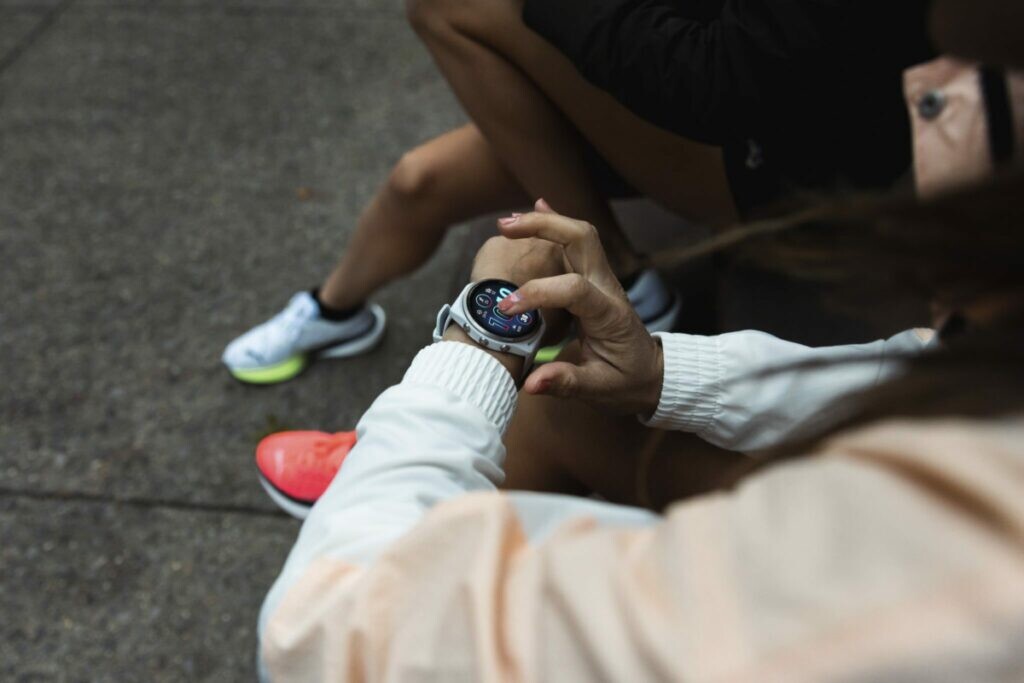
What is HRV?
Unlike heart rate, HRV focuses on the gaps between the beats. Specifically, it’s a measurement of the natural changes in tempo from one beat to the next. It’s a concept that’s probably familiar to anyone who’s ever tried playing the drums (or has lived on the same block as someone who has). An experienced drummer with rock-solid timing can hold the tempo perfectly between successive beats, so their “variability” is low. A shaky beginner who keeps striking the snare a little too early or too late, meanwhile, has high variability.

There are big differences between heartbeats and drumbeats, of course, and one in particular may make HRV seem a bit counterintuitive. While metronomic timing is great for drummers (and listeners), it’s not necessarily ideal for runners. In general, a heart that doesn’t keep the tempo exactly right between beats, like our fledgling drummer friend, reflects better overall health.
What can HRV tell us?
HRV can reflect several aspects of a runner’s overall health and fitness, for example, how well a body is adapting to training load or stress. If your HRV remains relatively high, it suggests the body is effectively recovering and adapting to the demands of your workouts. Conversely, a consistently low HRV may indicate inadequate recovery or excessive training stress, which could increase the risk of overtraining or injury.
HRV can also serve as a tool to gauge recovery. Lower HRV values are generally associated with fatigue and insufficient recovery, whereas higher HRV values indicate a readiness to perform. A higher HRV is generally associated with better cardiovascular health, overall fitness and improved autonomic nervous system function. A high HRV can also reflect the state of your mental and emotional well-being, like lower stress levels and improved mental resilience.
How is it measured?
HRV measurement is increasingly becoming a standard feature of portable running tech. It has been incorporated by companies such as Polar and Wahoo into chest strap heart-rate monitors, as well as smartwatches and fitness trackers by brands including Apple, Coros, Garmin and Fitbit. While the steps for taking measurements will vary by device, readings are taken when at rest while seated or lying down. Scores are most commonly expressed in milliseconds, with higher scores tending to reflect better overall health.
What do I do with the results?
Although HRV can provide a helpful snapshot of trends in your overall health, what the numbers mean from one runner to the next can be, rather fittingly, highly variable. As with maximum heart rate, a strong HRV score will continue to drop as runners get older, and even between healthy runners of the same age, scores can vary wildly. That’s why, when making sense of your HRV, it’s more valuable to look at which direction your numbers are trending, rather than trying to hit a score that may not reflect your overall health. Numbers that trend higher indicate improvements in fitness and overall health and may reflect your readiness to increase the intensity of your training. A string of decreasing scores could suggest one or more aspects of your overall health could use more attention.
What HRV numbers won’t tell you is what you need to fix. Because HRV can be shaped by many factors—level of physical activity, psychological and emotional stress, diet and sleep quality among them. In addition to taking HRV measurements daily, it’s important to regularly—perhaps once a week—check in with yourself on each of the above factors in your overall health, identify where you might be falling short and what changes need to be made (such as getting to bed earlier or eating more nutritious meals). Note how the changes affect the direction of your HRV scores in the coming week and see if that helps.
(06/20/2023) ⚡AMPby Paul Baswick
How Your Feet Recover (or Don't) After a Marathon, According to Research
New research highlights the type of damage that may occur from 26.2 miles of impact.
Participating in marathons can be a thrilling accomplishment, but it’s not always easy on the body—research has highlighted that marathon runners can be prone to serious soreness depending on muscular strength levels, as well as hamstring damage, for example. But what does it do to your feet? New research in the Scandinavian Journal of Medicine & Science in Sports finds that the larger muscles in the feet may show damage in the form of swelling and soreness for a week or more after a race.
To determine how feet are affected, researchers recruited 22 college runners who ran at least two to three times per week, and who were registered for the Mt. Fuji International Marathon in either 2019 or 2021. They used magnetic resonance imaging to measure the transverse relaxation time of the intrinsic and extrinsic muscles at four different time points: before the marathon, as well as days one, three, and eight after marathon completion.

To help put that into layman’s terms: The intrinsic muscles of the foot originate and insert within the foot itself, while extrinsic muscles originate in the lower leg and connect to the foot by way of the ankle. Both types of muscles stabilize the inner arch of the foot while working to move the foot during walking and running. Transverse relaxation time, also known as T2, is a measure of muscle damage.
When comparing the T2 values, researchers found significant damage for one of the intrinsic muscles and three extrinsic muscles the day after the marathon, with values fluctuating over the course of eight days.
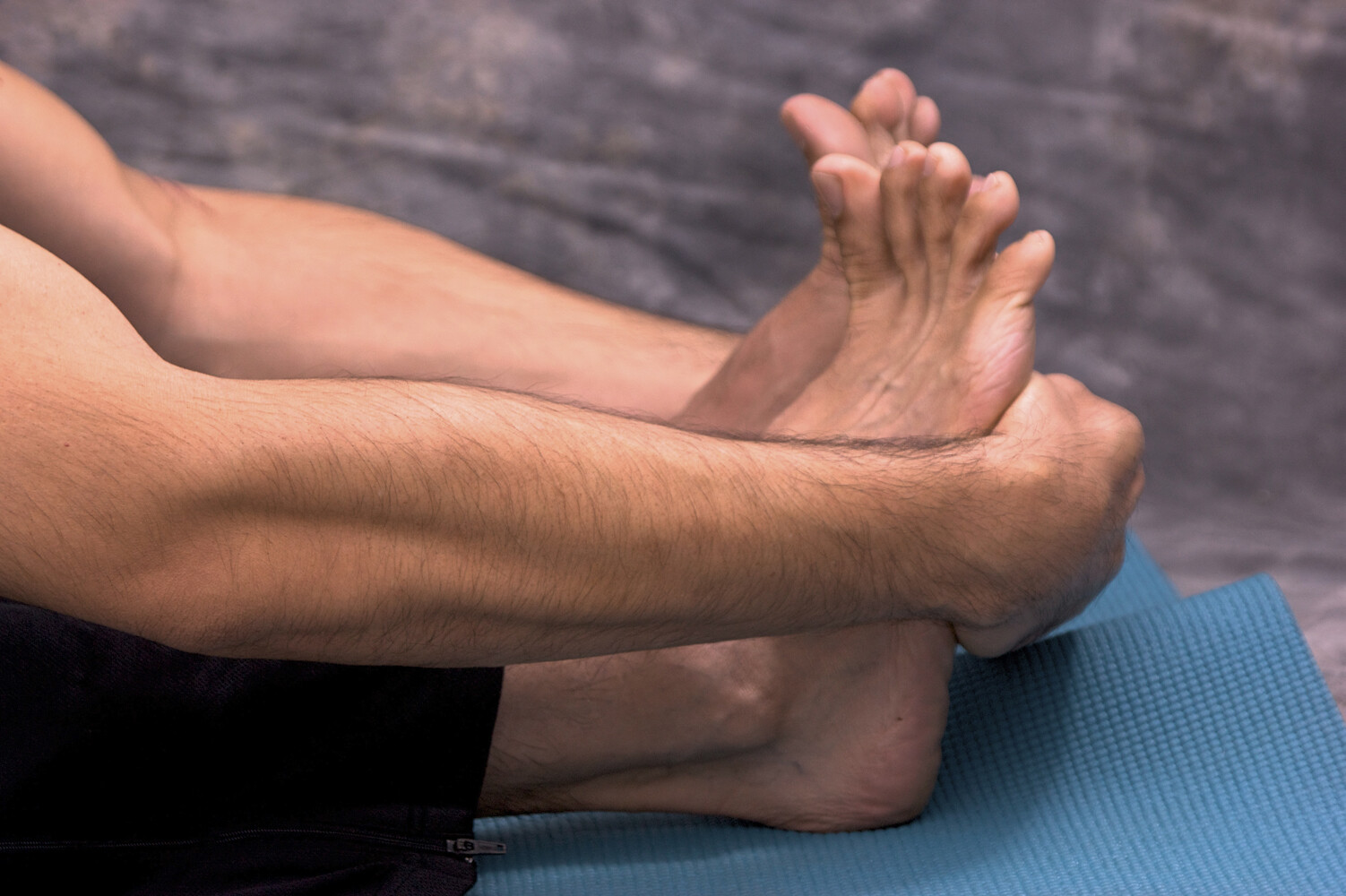
“This shows that different foot muscles are affected in different ways during a full marathon, with outer muscles more prone to damage than inner ones,” according to lead author Mako Fukano, Ph.D., researcher at the Shibaura Institute of Technology in Japan. He told Runner's World that pressure on the ankle joint during a continuous, long-distance run like a marathon would affect extrinsic muscles the most because they’re the ones that have to work harder to produce an efficient running stride.
“These findings might help for conditioning and injury prevention,” she said. “They give an indication that building strength in your feet could be important for recovery.”
In terms of how to best take care of your feet, the optimal strategy would be a combination of single- and double-leg exercises incorporated into a strength program, said Carol Mack, D.P.T., C.S.C.S.
“Strength training throughout the marathon training cycle can to help keep the foot and ankle muscles as strong as possible to run long distances,” she told Runner’s World. “For example, single-leg exercises will help isolate the stabilizing muscles in one leg at a time.”
Examples of some exercises to include in your marathon strength routine include single-leg Romanian deadlifts, single-leg squats, and Bulgarian split squats.
Another factor here is to allow time for recovery, she added. In the recent study, researchers only looked at damage in the first eight days after a race and there was still evidence of muscle damage. That means it’s unclear how long the damage may actually affect foot and ankle muscles, Mack said.
“What’s key is to understand that recovery from a marathon takes time,” she said. “In the weeks after a race, it’s important to take time off from impact exercise to let the muscles in the foot and ankle recuperate.”
(06/20/2023) ⚡AMPby Runner’s World
You too can Train the Kenyan Way in Kenya
Kenyan runners and many non-Kenyan runners training in Kenya have had good success. But why? These four things stand out as the reasons behind their success.
1. Training is a big part of their secrets including sloop training, intervals, fartlek and many exercise drills. They train twice a day, six times per week with the evening run easy.
2. Equally important is their diet, the Kenyan's runner diet is starch based very high in carbohydrates. Kenyan runners get 76 percent of their daily calories from carbs.
3. Almost all Kenyans train in groups, many at training camps.
4. Kenyans runners are surrounded by inspiration and positive thinking. You must believe you can run a 2:01 marathon to be able to do it. Visualization is a big part of this.
Many runners outside of Kenya have thought about training in Kenya with Kenyan runners. Some have made the trip and have had great success. But for most runners making the trip to Kenya and training for a month or more there never become more than a dream.
The main reason why it only remains a dream is because it just has not been easy to set it up. Lifetime runner Bob Anderson who also was the founder of Runner's World Magazine in 1966 and most recently the publisher of My Best Runs has made it easy for runners to come to Kenya and Train The Kenyan Way.
Bob and his wife Catherine first travelled to Kenya in 2013 and staged a race in Thika. It was during this trip he met up with Elam Wangwero, a 29-minute 10k runner who just loved all aspects of athletics. Bob and Elam talked about setting up a training camp in Thika (just an hour outside of Nairobi) during that trip.
Work started on the Kenyan Athletics Training Academy (KATA) some years later. Bob brought on board Florence Kimiti to be the manager and then hired Coach Joseph Ngure to be the head coach.
Construction was finished in September 2021. For the last two years the KATA staff have been working with Kenyan staff athletes getting them ready to accept guest athletes from around the world. The KATA staff athletes are training to become professional runners (some already are) and to help guests achieve their goals.
“COVID did slow things down for a while, says Bob Anderson, "but on June 14, 2023 we welcomed our first guest."
KATA has six private rooms for guests, each with a double bed and private bath with a shower. KATA has a total of 26 rooms including staff athletes’ rooms, office, a runners Lounge with a large TV screen, Olympic Dining Hall, Laundry room, Kitchen, massage room and a courtyard and garden so athletes can relax in between workouts.
KATA is solely set up for athletes who are interested in improving, running new PR's, becoming campions or being a professional runner. "We offer world-class training, quality Kenyan runner's food in a relaxed inspirational atmosphere with the emphasis on distance running, " says Director/Owner Bob Anderson working from his office in Mountain Views, California USA.

KATA’s first guest arrived on June 14th and is staying for six weeks. 20-year-old Nahim Abdallah (first and second photo) is a college student at Virginia Commonwealth University. He has clocked a 4:22 mile and recently ran a 14:31 5000m. He wants to be in top form for the upcoming cross-country season. His goal is to get under 14 minutes for 5k during his stay.
The second confirmed guest checking in July 2 for 12 weeks is Max Barnett (third photo) from England. He ran a 3:45 marathon in Paris a few weeks ago and wants to break three hours by October in Lisbon. "This is an aggressive goal," says Coach Joseph, "but we are going to help him make it happen."
"I have spoken with Max several times," says Bob Anderson "and I think we can help make this happen because of the passion Max has for running. His focus for 90 days will be running where now in England he just has too many other things getting in the way."

Bob Anderson and the team are very dedicated to this program and feel their setup is different than most. "We just have a cozy personal feel here," says onsite manager Florence. "So much positive inspiraton."
"This is your chance to Train the Kenyan Way," says Bob. All you need is a passport/visa and an airline ticket to Nairobi, Kenya. KATA will take care of everything else including picking you up at the airport. "Of course, you have to have the desire to become a better runner," says Florence, who was also a 1:59 800m runner as a junior.
"KATA offers training programs for 800m to 1-mile, 5k, 10k, Half Marathon and the Marathon" says KATA's onsite senior AK coach Joseph Ngure. "We will work with you and help you achieve your goals. Just let us know your starting point and your goals and we will provide the coaching to help you achieve it."
At any one time 12-20 Kenyan KATA staff runners are training at KATA. Most live and eat at KATA while others live nearby. These Kenyan athletes set the style of KATA as they work hard to become better runners themselves and help and support our guests.
You might be thinking that something like this must be very expensive. It is not, the cost is just $375US weekly with a minimum stay requirement of four weeks. This covers all your costs including a private room, three meals a day and world-class training.
For more info go to: www.KenyanAthletics.com
(06/19/2023) ⚡AMPby Lisa Wall
This humble sandwich is actually an incredible snack for runners
Do you remember, as a kid, being called inside after an afternoon of running around outside for a quick peanut butter and jelly sandwich (PB&J, for those in the know) and a cold glass of milk? Regardless of how you took it – crusts cut off, white bread, wheat bread, more peanut butter than jelly – it tasted like pure, unadulterated love.
Somewhere along the way, we ditched our beloved PB&Js for a more diverse lunch menu filled with chickpea salads, tuna paninis, and spinach smoothies. And while the introduction to nutrient-dense foods was essential for growing into adulthood, it’s time we look back and recognize that PB&Js are a totally underrated running snack.Let’s address the elephant in the room (who, coincidentally, would probably love PB&Js).

This beloved sammy can get a bad wrap as housing unhealthy and highly-processed ingredients, but, there are so many quality PB&J materials nowadays that you can feel good about whipping one up before or after a long training run.
Surprising no one, there are three ingredients in a PB&J. The bread, the peanut butter, and the jelly. Cool. Now that we have that out of the way, let’s talk about good options.
For years, shoddy “science” and a cultural gluten panic has maligned bread as “bad carbs”. However, studies show that whole wheat bread can not only be part of a healthful diet, but can reduce the risk of heart disease in adults. This is because whole grains contain essential vitamins like fiber, vitamin B, zinc, iron, and more. Plus, we as runners know how important carbs are.
A 2022 study followed dietary patterns of runners and found that those who ate whole grains over regular grains (white bread, white pasta, cereal) saw improvements in their runs.
It’s still a good idea to have a fair bit of skepticism when looking at breads in the grocery store aisle. Just because the packaging says, “Whole grains”, doesn’t mean it’s a good choice for your PB&J. Look for the 100% Stamp from the Whole Grains Council, which is a trusted third-party verifier.
You’ll also want to choose a bread that’s low in sugar (stick to six grams or less) and high in fiber.
A few examples of breads that meet these requirements are:
one slice - 110 calories
Did you know there’s a difference between jelly and jam? Jelly is made with strained fruit or fruit juice, whereas jam is made of mashed fruit. While the nutritional value of both are similar, their textures may dictate your preference. Jam often has fruit chunks in it, while jelly is smooth.
Jelly contains simple carbs and sugars, things runners love because of the ease of digestibility and quick hit of energy. Unfortunately, jelly can be high in added sugar and fructose corn syrup, so it’s best to keep an eye on the nutrition label when selecting this key part of the sandwich. That being said, sugar-free jelly is often made with artificial sugar replacements, which can cause digestive stress for some people.
You want to find a jelly made with natural sweeteners and little to no additives.An equally sticky and delicious ingredient to the PB&J is one many people steer clear from when trying to be health-conscious. But never fear! Peanut butter can be a great source of protein and healthy fats, both essential for a recovery from runs.
Some peanut butter brands often add in unnecessary additives and sweeteners to their products. Ideally, your choice should contain one ingredient: peanuts. Makes it easy, right? Look for natural peanut butters and don’t be alarmed by the oils sitting on top of a fresh jar. Simply mix before scooping.
As much as we stick to the humble, original PB&J combination, there are plenty of ways you, as a runner, can elevate your sandwich. For post runs, you can add banana slices for an extra dose of potassium and sprinkle flax seeds on top for healthy fats and extra fiber. If you’re more focused on quick, simple carbs before a run, replace bread with whole grain bagels instead.
For the more daring runners, try adding a splash of sriracha on top of the jelly and peanut butter. The heat cuts nicely with the sweet jelly and, when combined with peanut butter, tastes like Thai-inspired food. Yum.To a small saucepan on medium-low, add blueberries, chia seeds and water. Cook, stirring occasionally, until mixture takes on jam-like texture, about 10 minutes.
(06/19/2023) ⚡AMPby Outside Online
How to keep your momentum when traffic stalls your run
Nothing puts a cold stop to a good warmup run like the sudden flash of a traffic warning light. From short, frequent waits at downtown intersections to longer holdups at railway crossings, to drawn-out delays at lift bridges where ships saunter by at a snail’s pace, pauses caused by traffic are a reality for every runner at some point. When waiting out whatever is blocking your path, keeping your engine warm with some simple exercises can help you maintain your momentum.
Why keep moving?

Opting to keep active instead of idling during an unplanned pause can have mental as well as physical benefits. Stopping cold can disrupt a runner’s flow and mental focus, especially during a challenging run. Maintaining some level of movement can help you keep your mind engaged and prepared to throw it back into the same gear when you start moving again. Staying active when stopped also keeps blood flowing to the muscles—resting and cooling your muscles for too long can cause a performance hit, and even increase the risk of injury, once your wait is over and it’s time to pick up the pace again. Having some simple exercises up your sleeve will help you slip into active standby mode. Consider these suggestions for coping with delays of varying durations.
Traffic signals: waits of 30 seconds to two minutes
For brief, predictable stops at city intersections, where waits to cross the street typically last mere seconds to around two minutes, running in place is probably the most intuitive and practical way to keep your body moving. Transitioning from a run to a stationary jog—and back again—maintains the flow of activity with no interruption. It’s also a form of exercise that doesn’t take up any additional space, which is important when running on busy city streets where sidewalk real estate is at a premium. Running on the spot makes it easy to gauge and manage the intensity of your movement when waiting for the light to change. Those pacing themselves by heart rate can easily adjust their effort (which could be cadence, kick height, or both) to stay in the same target heart-rate zone they were in while on the move.
Railway crossings: waits of up to five minutes
While running in place might also be appropriate to wait out zippier commuter trains, getting stuck at a rural railway crossing by a seemingly endless stream of lumbering cattle cars might call for a less monotonous approach. For medium-length pauses that are too long for running on the spot, but too short to make doubling back on your route worth your while—particularly if you’re strict about not exceeding your distance goals—a mix of exercises will keep your blood pumping and help the time pass more quickly.
Consider rotating between routines that focus on different muscle groups in one- to two-minute intervals. This might include working your core by performing a plank, followed by two minutes of dynamic stretching (targeting gluteal muscles and hamstrings for a minute each) and finishing with mobility exercises such as front- and side-leg swings.
Lift bridges: waits of 10 minutes to eternity (seemingly)
Fortunately, the longest traffic delays runners are likely to face tend to be the easiest to plan around. Such is the case with boat and ship traffic. In areas such as Ontario’s Niagara region, where the Welland Canal cuts through streets in several communities, raised lift bridges can stop runners for 20 minutes or more. The most practical option for staying in motion when a raised bridge blocks your route is to have an alternate route at the ready. Or, depending on the training-run goals, it may be worth rethinking your gameplan entirely—if the route you’ve mapped out for your two-hour long run risks leaving you stuck at a bridge at the 90-minute mark, stick to a course where exceedingly long traffic tie-ups won’t jeorpardize your training targets.
(06/19/2023) ⚡AMPby Running Magazine
The benefits of adding strength training to your running routine
Running is one of the most popular sports in the world for people who want to stay fit. It offers many benefits and gives the participants lots of endorphins to get them through the day.
Although running alone is a great form of exercise, there is more you can do to become the best runner you can be. Below are some of the many benefits of adding some strength training to your normal running routine.

Strengthen Muscles Around Joints
Because running is such a high-impact sport, runners are more likely to develop injuries like shin splints and pulled muscles. Simple strength training exercises can help build and strengthen the muscles around the joints in the knees, ankles, and hips.

These are the areas where injuries and long-term pain can occur, so it is better to start strengthening the body before problems occur than to experience an injury and have to take time off of running.
Increased Bone Density
Running is a sport that will keep you strong and increase your bone density, but strength training can do that as well. According to the Mayo Clinic, prolonged strength training will make your bones denser, which is important for runners.
Denser bones mean less chance of diseases like osteoporosis later on in life. That means more years of running long into the future.
Running Longevity
Runners who integrate strength training into their weekly workout schedule may be able to run for longer. Running is known to be quite hard on the body because it is so high-impact. Because of this, many runners are not able to continue running into their 40’s, 50’s, or 60’s because of injuries or long-term wear and tear.
Doing exercises to strengthen your body early on in your running career will help you to continue running and staying fit for many more years.
It Offers An Alternative to Running
Even runners know that it is not good for you to run every single day of the week. Adding strength training to your routine gives certain muscles a break and offers others to get stronger. A good weight training routine interspersed with long and short runs creates a well-rounded workout routine that will keep you fit. Additionally, strength training gives your whole body a break from the intensity that running brings. The key to a good exercise routine is variety.
Creates a Social Atmosphere
Although runners can form friendships on the running path, it is hard to have real conversations when running. Often running takes all of the breath you have and none can be wasted on conversation.
Adding strength training to your running routine gives you and your running buddies the opportunity to chat, share running advice, and just get to know each other better.
Strength training is an activity that is growing in popularity and shows no signs of slowing down. The decision to add strength training to your routine as a runner will only help you to grow as an athlete. Once you consider these benefits, run to the gym and get a spot on the bench before they are all taken.
(06/18/2023) ⚡AMPby Colorado Runner
This Groom Literally Ran to the Altar Last Weekend
He ran a marathon from his family’s lake house to the wedding venue—and then said “I do.”
People deal with pre-ceremony jitters and mark the occasion of their wedding in myriad ways. Sometimes that entails a shot of whiskey, taking a long walk, or practicing yoga. For one Chicago man, running a marathon to his wedding venue last weekend was just the ticket.

On Thursday, before saying “I do,” Chicago runner Simon Tanzman laced up a pair of black New Balance trainers and completed his “Running to the Altar” marathon, hoofing it from his family’s lake house to his wedding venue, the Morris Estate in Sawyer, Michigan. In a video interview with ABC 57 just 24 hours before the wedding, Tanzman told the local news station how he got the idea to tackle this nuptial run. “So this started because about a year ago I decided to just randomly see about how far was it from our cabin in Sawyer, Michigan to the wedding venue, and it was 21 miles—almost a marathon, but 5 miles short,” he said. “Probably a stupid idea, but I was like, ‘Hey babe, what would you think?’ ‘Whatever you want, babe.’ And here we are.”
Holly Hurston fully supports her husband’s running goals. She said, “He just really loves to challenge himself, and any kind of goal he can attain … he’s not crazy.”
By the time the festivities began late Saturday afternoon, the groom was all cleaned up and dressed to the nines in a light gray suit with purple accents, dancing up a storm with his bride. You’d never know he’d just pulled off such a daunting athletic feat.
Tanzman started running as a hobby a few years ago to get in shape and says he fell in love with the sport. Including his run to the altar, he’s run five marathons, three official races, and two solo, self-created challenges. The first of those runs, taken up early in the pandemic when most races and events were canceled or virtual, was one Hurston created for him, called the “Hippity Hoppity Holly Half.”
She made a custom race T-shirt for Tanzman, and had him run a path along Lake Michigan, waiting for him along the course with water, Gatorade, and snacks, “just always being there for him, showing my support and love for him,” she said.
“I couldn’t have done it without her driving around the course,” said Tanzman.
That kind of mutual love and support surely bodes well for the couple’s marriage, and is sure to give the newlywed wings at Tanzman’s next race, October’s Chicago Marathon
(06/18/2023) ⚡AMPby Runner’s World
Elisha Barno becomes winningest men’s runner in Grandma’s Marathon history
The country’s 12th largest marathon represented by 56 different countries was welcomed back into the Northland on Saturday morning, Grandma’s Marathon.
During the full marathon in the elite men’s division, Elisha Barno continued to bring his best to the race earning his fifth, first place finish at Grandma’s Marathon with a PR of 2:09:14.
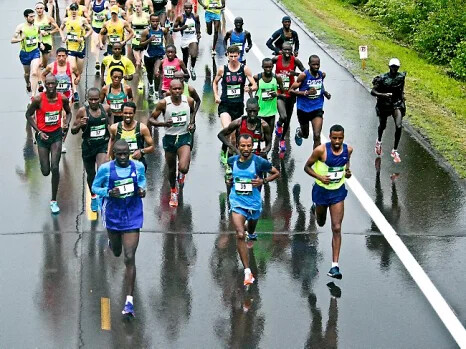
Barno shaved 18 seconds off of his previous time and currently owns three of the top four finishes at Grandma’s Marathon.

The Kenyan is now also the winnigest men’s runner in the history of Grandma’s Marathon.
(06/17/2023) ⚡AMPby Alexis Bass
Grandmas Marathon
Grandma's Marathon began in 1977 when a group of local runners planned a scenic road race from Two Harbors to Duluth, Minnesota. There were just 150 participants that year, but organizers knew they had discovered something special. The marathon received its name from the Duluth-based group of famous Grandma's restaurants, its first major sponsor. The level of sponsorship with the...
more...Kimutai wants to emulate Wanyonyi ahead of Budapest
Fast-rising Kelvin Koech Kimutai is looking to emulate former world under-20 800m champion Emmanuel Wanyonyi in the two-lap race. Kimutai, who also won the East Africa 800m title, has set his focus to represent Kenya at the World Athletics Championships in Budapest Hungary, in August.
To realize his dream, Kimutai is hoping to finish on the podium when he lines up at the national athletics championships next week at the Nyayo Stadium in search of the qualifying time for Budapest.

Last Saturday, he finished second in both the 400m and 800m during the AK Central Rift Championships at the Kipchoge Keino stadium in Eldoret. “I managed to double in the 400m and 800m finishing second but I want to run well and be in position one at the national championships next week,” he noted.
The 17-year-old says he wants to run well so that he can qualify for world championships come August. He said he is motivated by the consistency he has displayed in his past assignments.

“I won my first medal at East Africa Championships in Tanzania and went on to win in Lusaka during Africa U-18/20 Championships. These wins have motivated me to look for more accolades,” said Kimutai.
Koech is a Form Four student at the Kosirai Secondary School in Nandi County. Wanyonyi, who has now won two back-to-back Diamond League series titles—Rabat and Paris—also attended the same school.
“My dream is to keep winning on the international stage and fly the country’s flag high. Wanyonyi, who is my role model and a former schoolmate inspires me with his performance,” he revealed.
(06/17/2023) ⚡AMPby Africa-Press
World Athletics Championships Budapest 23
From August 19-27, 2023, Budapest will host the world's third largest sporting event, the World Athletics Championships. It is the largest sporting event in the history of Hungary, attended by athletes from more than 200 countries, whose news will reach more than one billion people. Athletics is the foundation of all sports. It represents strength, speed, dexterity and endurance, the...
more...Samuel Naibei set to run at next Nairobi Marathon
Iten International Marathon champion Samuel Naibei has confirmed participation at next Nairobi City Marathon.
Speaking in Iten on Thursday after receiving his Sh1 million cheque for winning the inaugural Iten race in December last year, Naibei said he has set his focus to compete in the Nairobi International Marathon.

“I will be competing at the Nairobi Marathon that will mostly be concentrated on the Expressway” he said.
“Just a month ago, I competed at the Nelson Mandela Half Marathon in South Africa, which I won in 61 minutes. I am ready to improve on it.”

Naibei won the men’s race in Iten while Caroline Jepchirchir ruled the women’s category.
In Iten, Naibei edged out experienced marathoners on his debut including Albert Kangogo among others in a time of 2:08:43. Joshua Kogo came second in 2:10:35 while Kangogo completed the podium positions in 2:11:46.
Naibei said they are on course as far as training is concerned and promised to do well in Nairobi. “Running 2:08 in Iten is easy but not so good for me. I want to do more,” he said. “We are running well in this region because coaches are doing a great job.”
(06/17/2023) ⚡AMPby Emmanuel Sabuni
NAIROBI MARATHON
Nairobi Marathon is an annual road running competition over the marathon distance held in October in Nairobi, Kenya. First held in 2003, the competition expanded and now includes a half marathon race along with the main race. It was part of "The Greatest Race on Earth", fully sponsored by Standard Chartered Bank....
more...Rodgers Kwemoi to make half marathon debut at Antrim Coast Half Marathon
The 2016 World Under-20 10,000m champion Rodgers Kwemoi will make his first half marathon appearance this year at the Antrim Coast Half Marathon, a World Athletics elite event, on August 27.
Kwemoi had a successful outing last season, reigning supreme at the N Kolay Istanbul half Marathon and later finishing second at the Ras Al Khaimah half Marathon in the United Arab Emirates.
He opened his 2023 season with a 10th-place finish in the 10,000m at the 31st Kanakuri memorial middle-and long-distance Invitational Meet.

He then finished ninth in the 10,000m at the 1st Nittaidai Challenge Games before finishing third at the 67th Central Japan Corporate Teams Athletics Championships.
He will be looking for his first win when he takes on opponents in the Irish capital for the first time.

Another athlete who has confirmed participation is Great Britain’s Callum Hawkins who will be opening his season at the event.
His last race was last year’s Valencia half Marathon where he fizzled out to finish in a disappointing 28th place.
The 2017 Marugame half-Marathon champion will be looking for a fresh start when he takes on his opponents. He returns to Ireland after a seventh-place finish during last year’s event.
(06/17/2023) ⚡AMPby Samuel Nganga
MEA ANTRIM COAST HALF MARATHON
The MEA Antrim Coast Half Marathon 2022 has been approved by World Athletics as an Elite Event. The World Athletics certified course takes in some of the most stunning scenery in Europe, combined with some famous landmarks along the route. With it's flat and fast course, the race is one of the fastest half marathons in the world. Starting...
more...Danish dad smashes stroller half-marathon record
Breaking records in marathon running is no easy feat, but Danish distance runner and new dad Jacob Simonsen managed to do just that, in a rather unconventional way. With his one-year-old son, Viggo, safely tucked in a jogging stroller, Simonsen blazed through the Aarhus City Half Marathon on June 11, setting an unofficial stroller half-marathon Guinness World Record of 68:04.
Simonsen, 28, shattered the previous record by a whopping 34 seconds, averaging a speed of nearly 19 km/hr around Aarhus. Simonsen is quite an established runner domestically, earning the title of Danish champion at the 2023 Copenhagen Marathon, where he placed ninth overall in 2:14:46. He has also represented Denmark at the 2019 and 2023 World Cross-Country Championships.

Before the race, he told Danish reporters that he isn’t used to running with a stroller, but thought it would be a fun challenge with his newborn son. His main concern heading into the race was making sure his son didn’t wake up from his nap unhappy about this endeavour. Luckily, things went as planned. “Viggo was a champ throughout the race,” said Simonsen. “He seems to have inherited his father’s sense of adventure and love for the thrill of running.”
Typically, stroller runners start at the back, but to ensure fair competition and Simonsen’s bid for the record, he was granted a position at the front. He also had another runner follow him to capture the attempt on video and make the feat official, a requirement for a Guinness World Record.
Simonsen finished fifth overall, only a minute and a half behind the winner, Omar Hassan, who won in 66:31.
(06/17/2023) ⚡AMPby Running Magazine





